Australian
and international
exploratory
performance and
media arts
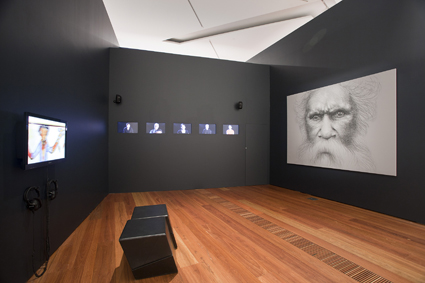
Vernon Ah Kee, Ideas of Barak 2011 Brisbane, Queensland charcoal on canvas, video installation, Felton Bequest 2011
THE NATIONAL GALLERY OF VICTORIA MARKED ITS 150TH BIRTHDAY IN MAY. IN ADDITION TO THE OCCASION’S DOMINANT NARRATIVE CELEBRATING AUSTRALIA’S OLDEST PUBLIC ART GALLERY, THE NGV ALSO USED ITS MILESTONE TO ENGAGE WITH AND FACILITATE BROADER REMEMBRANCE OF ONE OF VICTORIA’S MOST IMPORTANT ARTISTIC AND HISTORICAL FIGURES—WILLIAM BARAK. THROUGH A SERIES OF COMMISSIONS AT NGV’S IAN POTTER CENTRE, THE LIFE AND LEGACY OF THE WURUNDJERI LEADER HAS BEEN PROMINENTLY RE-PRESENTED AND RE-IMAGINED.
Barak’s life (c1824-1903) encompassed a period of intense change and trauma for his people. As a boy he was present at the signing of the 1835 Treaty between members of the Kulin people and John Batman, and as ngurungaeta (clan leader), Barak was a skilled diplomat and politician. He would famously walk from Coranderrk (near Healesville) to Melbourne to negotiate and fight for the rights and living conditions of his people—devastated and immeasurably changed after Batman’s treaty (see Bruce Pascoe, How It Starts, First Australians, Miegunyah Press, Melbourne, 2008). His legacy as an artist is also vitally important; towards the end of his life Barak produced a number of intricate works on paper that documented the traditions of the Wurundjeri people, ensuring that knowledge of this culture would be preserved and continued for future generations.
Despite the influence and impressive reputation of this Aboriginal leader, the cultural memory of Barak amongst Melbournians and Victorians remains limited. I first learnt about him at the NGV seeing his paintings on display in the Indigenous Galleries. Three new commissions on display by contemporary artists Vernon Ah Kee, Brook Andrew and Jonathan Jones represent an important opportunity to further ingrain the name and story of Barak into the national consciousness and cultural memory.
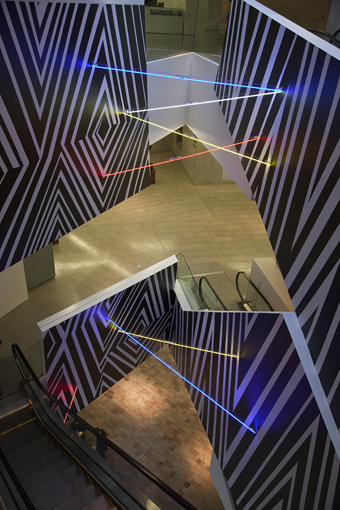
Brook Andrew, born Australia 1970, Marks and Witness: A Lined Crossing in Tribute to William Barak, 2011 Melbourne, Victoria
vinyl wall drawing, neon
Felton Bequest 2011
image courtesy of the artist and NGV Australia
Brook Andrew, born Australia 1970, Marks and Witness: A Lined Crossing in Tribute to William Barak, 2011 Melbourne, Victoria
vinyl wall drawing, neon
Felton Bequest 2011
brook andrew
Brook Andrew’s commission Marks and Witness: A Lined Crossing in Tribute to William Barak is a site-specific work installed in the Ian Potter Centre’s atrium. The recurrent Wiradjuri designs and neon stretch up multiple levels, offering an overwhelming and dizzying entrance to a space which is already monumental in its architecture. Like previous works such as Jumping Castle War Memorial (2010), there is an ironic tension in Andrew’s commission. Contrasting the connotations of formality and permanence in the memorialising process with an ironic and playful interpretation, it eschews the representational mode, offering instead an immersive and experiential form of memorial. It also possesses a sense of the ephemeral, a spectacle that may not be on display indefinitely, thus drawing attention to the relative lack of formal and prominent sites of remembrance dedicated to Indigenous histories and heroes.
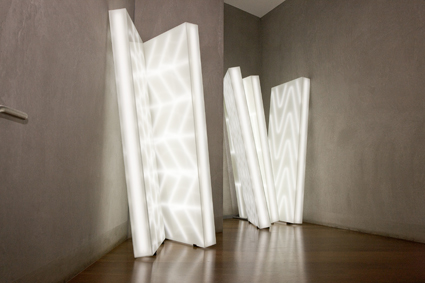
Jonathan Jones, Untitled (muyan)
2011 Sydney, New South Wales
light emitting diodes (LEDs), glass, aluminum
Felton Bequest 2011
jonathan jones
While some historical narratives emphasise the individualistic nature of heroism, Barak’s legacy as leader and artist is fundamentally entwined with the culture of his community. Joy Murphy Wandin, a senior Wurundjeri woman and descendent of Barak, explains the role of the ngurungaeta as those who “take on the responsibility for the entire community” (cited in Pascoe). Thus Barak’s paintings of Wurundjeri ceremonies are not just works by an individual artist, they also reveal the communal practices and celebrations of his people and Jonathan Jones’ commission Untitled (muyan) is inspired by and suggestive of this tradition.
Jones’ piece is composed of five LED illuminated glass light-boxes installed in a large stairwell of the gallery. Arranged into two groupings, it symbolises the two fires seen in Barak’s paintings, one for the Wurundjeri and another for visitors and guests. The white LED lights of the installation will annually turn yellow in August, signifying the blooming of the muyan (wattle), the time of year that Barak had predicted for his own death. Imbuing his piece with this temporality, Jones evokes a subtle sense of ritual and offers a visual cue to viewers, a possible catalyst for further visits and commemoration.
vernon ah kee
When presenting and documenting history, modes of representation and sources of information—history books, museum exhibits, documentary films—are generally positioned through the lens of authority and expertise. Vernon Ah Kee’s work Ideas of Barak is perhaps the most dense of the three commissions in terms of the level of historical information and context provided, however it resists didacticism by acknowledging the complexities and contradictions inherent in historical representation.
The piece consists of three components: a charcoal portrait of William Barak; a single channel video of the artist exploring and discussing Barak’s life and country; and a five channel video featuring a variety of individuals speaking about their personal ideas of Barak. Rather than offering a singular narrative, Ideas of Barak is constructed around fragments, impressions, imaginings, contradictions, musings, opinions and convergences. Some of the individuals acknowledge not knowing a great deal about Barak’s life—they are neither historians nor experts—yet each makes a personal and present-day connection with this figure. The artwork acknowledges that individuals do not need an encyclopaedic knowledge of history in order to be moved by its narratives and figures, and to play a role in their remembrance. While history might attempt to create linear narratives, memory often encompasses the fragments, fantasies and imaginations of individuals and cultures.
beyond the gallery
Last year, property developers Grocon announced plans to build an apartment building featuring a 32-storey portrait of Barak on its façade (see the plans and an article from The Age), meaning that Melbourne may well find itself with a prominent and permanent public memorial to this Aboriginal hero. However, we must not assume that any single act of remembrance, no matter how visible, marks an end to the memory-work. Cultural memory is an ever shifting and evolving realm, and the NGV’s commissions will hopefully be but one level of an ongoing, multi-layered dialogue that continues to foreground the legacy of William Barak in the consciousness of the Australian public.
The Barak Commissions: Brook Andrew, Marks and Witness: A Lined Crossing in Tribute to William Barak; Jonathan Jones, Untitled (muyan); Vernon Ah Kee, Ideas of Barak; The Ian Potter Centre, NGV Australia, www.ngv.vic.gov.au
This article first appeared in the June 28 e-dition.
RealTime issue #104 Aug-Sept 2011 pg. web
© Kate Warren; for permission to reproduce apply to realtime@realtimearts.net
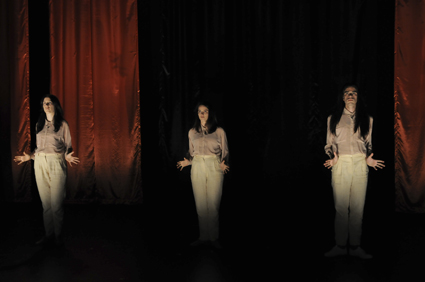
Mish Grigor, Zoe Coombs Marr, Eden Falk, Who’s the Best?
photo Heidrun Lohr
Mish Grigor, Zoe Coombs Marr, Eden Falk, Who’s the Best?
who’s the best?—post is
You’ve only got until July 2 to be seduced and wowed by Post’s infectiously delirious Who’s the Best?, commissioned by Sydney Theatre Company’s Wharf 2 Next Stages program. Once again Post raise daggy amateurism to a sublime artform—and with more professional verve than ever (see the review of Everything I Know About the Global Financial Crisis in One Hour in RT101). This experiment to determine which of the three collaborators and friends is the best performer employs a range of tests from psychological profiling to assessing who’s the ‘hottest.’ These are constantly complicated or sidetracked by hilariously mind bending battles of the Abbot and Costello “Who’s on first” variety over the semantics of category labels and terminology. They’re adroitly woven through the script, recurring as running gags and providing an immersive pulse to the work. The performers’ casual delivery (always played directly to the audience while they freely insult each other) yields intimacy and immediacy on a stage which wickedly threatens to subvert the show as curtains and lighting go about their own business regardless. Trio member and co-devisor Natalie Rose, who has recently had a child, is replaced for the premiere season by a wigged Eden Falk who slips easily into the Post mode while bringing his own wide-eyed comic innocence to Who’s the Best? alongside Mish Grigor and Zoe Coombs Marr. Post, Who’s the Best?, Wharf 2, Sydney Theatre Company, Next stage 2011, June 17-July 2, www.sydneytheatre.com.au
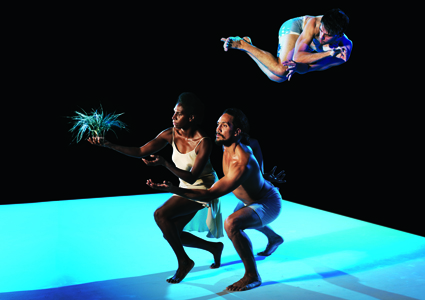
Elma Kris, Waangenga Blanco, Daniel Riley McKinley, Belong
photo Jason Capobianco
Elma Kris, Waangenga Blanco, Daniel Riley McKinley, Belong
new works in naidoc week
Next week is NAIDOC week and there are two exciting premieres to look forward to. In Sydney, the PACT Centre for Emerging Artists is presenting Bully Beef Stew, its first ever fully professional commission. Coming out of its Incubate initiative, a performance laboratory for emerging Indigenous artists, Bully Beef Stew features three young Aboriginal men—Sonny Dallas Law, Colin Kinchela and Bjorn Stewart—working with director Andrea James (former artistic director of Melbourne Workers Theatre) and choreographer Kirk Page. Billed as a “fearless theatrical exploration of Aboriginal manhood,” the piece draws on the personal experiences of the performers as well as their fathers and other men in their lives, past and present (press release).
Further north, Stephen and David Page will be premiering ID as part of Bangarra Dance Theatre’s double bill Belong. (Check out the Stephen Page archive in RealTimeDance.) This new work “draws upon Page’s personal experiences of observing contemporary Indigenous people tracing their bloodlines, reconnecting with their traditional heritage and living modern lives in a challenging urban society” (press release). The second new work of the evening, About, comes from emerging choreographer Elma Kris. The rise of Kris, Daniel Riley McKinley (RT98) and Vicki Van Hout (RT104) makes this an exciting time for contemporary Indigenous dance. The double bill will tour nationally. Bully Beef Stew, PACT Centre for Emerging Artists, June 29-July 9; www.pact.net.au; Bangarra Dance Theatre, Belong—ID and About, QPAC, July 1-9, then touring to Sydney, July 20-Aug 20, Perth, Aug 25-28, Canberra, Sept 2-3, Wollongong, Sept 8-10, Melbourne, Sept 15-24; www.qpac.com.au, www.bangarra.com.au
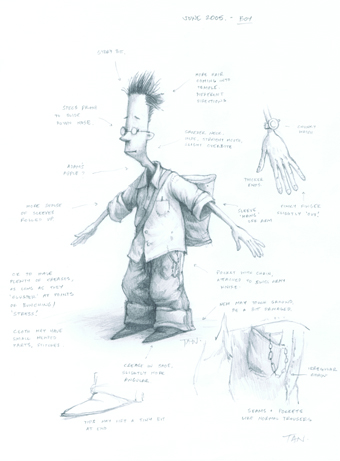
The Lost Thing
image courtesy of the artist
The Lost Thing
the lost thing found at the powerhouse
Still in Queensland, and just in time for the school holidays, the Brisbane Powerhouse presents Shaun Tan: The Art of the Story, a free exhibition showcasing the art of the Academy Award winner and children’s illustrator. On display will be limited edition prints of illustrations from his books The Rabbits, The Red Tree, The Lost Thing, Tales from Outer Suburbia and The Arrival (we reviewed Red Leap theatre’s adaptation of The Arrival in RT94). The exhibition also features the film version of The Lost Thing, which won this year’s Oscar for Best Short Animation as well as last year’s Yoram Gross Animation Award at the Sydney Film Festival (RT98). Shaun Tan: The Art of Story; June 28-July 10; www.brisbanepowerhouse.org
underbelly
In the wake of Imperial Panda (reviewed in our last e-dition) and Tiny Stadiums (reviewed in this one), comes another Sydney-based arts festival—Underbelly (see the interview with director Imogen Semmler in RT103). Previously staged at CarriageWorks (RT80) and Queen St Studios and surrounds in Chippendale, this year the festival heads to Cockatoo Island in Sydney Harbour. The festival proper is on for only one day, on Saturday July 16, but a 10-day preliminary program, The Lab, allows audiences to visit during the development period so they can watch the art unfold that’s been developing for several weeks. If you’re feeling particularly participatory, you can attend an Open Project session and contribute to the development of an anthropological experiment Case Study, Butterfries’ haunted-house inspired The All You Can Stand Buffet and Dan Koop’s The Stream/The Boat/The Shore/The Bridge, a human-scale board game in which the audience are the players. Underbelly Arts Festival, July 3-12, www.underbellyarts.com.au
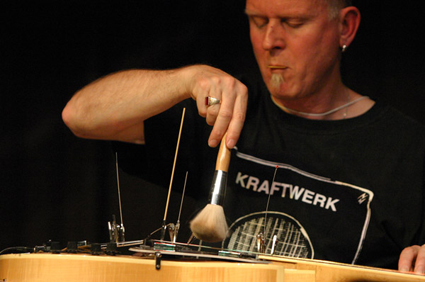
Dave Brown (aka candlesnuffer), Liquid Architecture
photo courtesy of the artist
Dave Brown (aka candlesnuffer), Liquid Architecture
sound flows
For more than a decade, the Liquid Architecture: National Festival of Sound Art has showcased the best of the world of sound art (see our Archive Highlight).This year’s program includes artists Marc Behrens (Germany) who is bringing with him sounds from China and the Amazon rainforest, Pascal Battus (France) who shapes his instruments to match his body gestures and insists on offering the occasional “sound massage” and Lukas Simonis (Netherlands), who in collaboration with Melbourne’s Dave Brown, will display his mastery of guitar improvisation. They are joined by Australians Pia van Gelder, with her own electrical inventions, plus Jon Rose and his ‘Team Music’ live interactive netball game. The festival has already kicked off in Melbourne where it continues until July 2 with concerts running simultaneously in Perth (June 27-28), Bendigo (June 29) and Brisbane (July 1). Arriving in Sydney on July 2, Liquid Archtecture will feature two free concerts at the Eugene Goossens Hall in the ABC’s Ultimo Centre, Sydney (no booking required) and Battus’ Sound Massages on July 3. If you can’t be there in person, you can hear the performance broadcast that night on ABC Classic FM’s New Music Up Late. Liquid Architecture: National Festival of Sound Art, June 27-July 3; www.liquidarchitecture.org.au; www.abc.net.au/classic/newmusic
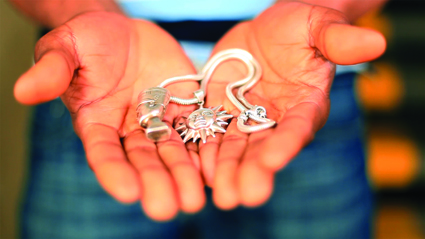
Show and Tell
scenes from the arab spring
Since last year’s Arab Film Festival, there have been revolutions in Tunisia and Egypt, a civil war in Libya, uprisings in Bahrain, Syria and Yemen, major protests in Algeria, Iraq, Jordan, Morocco and Oman and minor protests in Kuwait, Lebanon and Saudi Arabia. In other words, it’s a time of incredible change. Now in its 10th year (see our reviews from 2007 and 2010), this year’s Arab Film Festival presents 22 “front-line stories” from around the region, many of which have been presented at recent festivals in Cannes, Dubai, Berlin and Sundance. Highlights include Sarkhat Namla (The Cry of an Ant), the first feature film to address the Egyptian Revolution this year; Stray Bullet, which features Lebanese actress Nadine Labaki in her first role since the internationally acclaimed Caramel; and Into the Belly of the Whale, where we follow a man trapped in the supply tunnels under the border zone between Israel and Egypt. Local films include Mary, a story of neighbourly espionage in Western Sydney, and Show and Tell which examines the link between object and memory of recently arrived refugees in Sydney. There’s also a forum on July 1 titled Revolution, Romance, Realities, which will address “how new media has facilitated a critical mass movement, amplifying everyday voices, transmitting images globally” (press release). Speakers include Dr Paula Abood, Randa Abdel Fattah, Farid Farid and Sameh Abdel Aziz. The festival will then tour to state capitals. 2011 Arab Film Festival, Sydney June 30-July 3, Melbourne July 8-10, Canberra July 14-17, Adelaide July 23-24, Brisbane July 30-31; www.arabfilmfestival.com.au
life after death in venice
In our most recent print edition, we interviewed Anna Teresa Scheer about the work of Christoph Schlingensief (RT103). Schlingensief died of cancer in August 2010 at the age of 49, but a few months prior curator Susanne Gaensheimer had approached him to design the German Pavilion at the 54th Venice Biennale in 2011. Instead of abandoning the project completely, or attempting to realise it exactly as the artist had imagined, Gaensheimer chose a middle path, presenting Schlingensief’s plans in book form ahead of the event and then using the event itself to show a selection of his works, without attempting a retrospective. She was rewarded for her efforts on June 4, when the German Pavilion was presented with the Golden Lion for Best National Participation. You can see the announcement on the Biennale’s YouTube channel, read an interview with Gaesheimer in Deutsche Welle and an interview with Schlingensief’s widow Aino Laberenz in Der Spigel. For footage of the pavilion itself, see Vernissage, the official website Deutscher Pavilion and Schlingensief’s own personal website.
RealTime issue #103 June-July 2011 pg. web
© RealTime ; for permission to reproduce apply to realtime@realtimearts.net
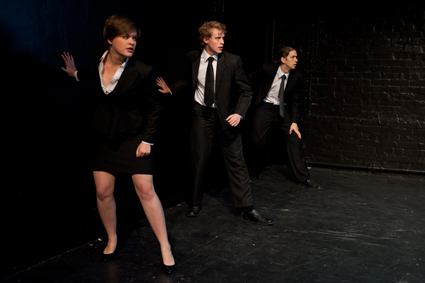
Applespiel, Executive Stress/Corporate Retreat
photo Michael Myers
Applespiel, Executive Stress/Corporate Retreat
HOT ON THE HEELS OF IMPERIAL PANDA COMES TINY STADIUMS—ANOTHER SYDNEY-BASED, SELF-PRODUCED FESTIVAL THROUGH WHICH EMERGING ARTISTS GAIN BOTH EXPERIENCE AND EXPOSURE. THE TWO FESTIVALS SHARE MORE THAN A DIY SENSIBILITY AND A FONDNESS FOR QUIRKY NAMES, THEY ALSO SHARE SOME CURATORIAL TALENT—MISH GRIGOR CURRENTLY SERVES ON BOTH ORGANISING COMMITTEES AND ZOE COOMBS MARR AND EDDIE SHARP HAVE DONE SO PREVIOUSLY. SO IT’S NOT SURPRISING THAT, LIKE IMPERIAL PANDA, TINY STADIUMS PROVIDES A DIVERSE PROGRAM THAT COMBINES LIVE ART IN A VARIETY OF LOCATIONS AS WELL AS SOME MORE THEATRICAL OFFERINGS, INCLUDING A GOOD OLD FASHIONED DOUBLE BILL AT PACT THEATRE.
First on the program is Applespiel’s Executive Stress/Corporate Retreat, which, as you might suspect from its title, is a satirical take on every self-improving, team-building, life-affirming exercise you’ve ever had the misfortune to endure. The show starts with an invitation from a young man in a snappy suit to enrol in the elite club. Several audience members head to the desk while I hang back, until I remember that I am reviewing the piece so I’d better participate. Unfortunately the elite club closes just as I reach the desk—hesitation then rejection, that’s a double fail. Having been photographed and name-tagged, the elite club members now circulate with “ice breaker” exercises, asking the non-elite about our allergies, holidays and siblings. Ice broken, we then do another survey, where the performer poses a question and we stand on one side of the foyer or the other, depending on whether we like tennis, have a father with a drinking problem etc. Finally, we enter the theatre and as we take our seats—elite club at the front, mere mortals at the back—we see several performers in black suits sprinting back and forth across the stage.
The rest of the show basically consists of Applespiel running a corporate workshop, demonstrating an exercise and then directing the elite team to do it on stage. These efforts are then scored and the results displayed in a sort of league table, which is projected onto a large screen upstage. The exercises include mock job interviews, in which participants are asked not only about their strengths and weaknesses but also about which food they most resemble. “An egg” is the recommended answer, for its ability to work solo and in combination with a variety of other ingredients, its balance of protein and fat, not to mention its facility for segueing from one cuisine to another. Do not say “banana” as they are “the first to go missing in a crisis.” Participants are also taught an obscene rhyme in order to remember how to tie the perfect Windsor Knot and led through a strange series of actions to find their totem animal. Last but not least, they close their eyes and vote on each other’s performance.
There are some amusing moments and the premise has real potential, but it isn’t completely fulfilled here. On the night I attend, the elite club members are oddly acquiescent, to the point where I was dying for someone to throw a spanner in the works. But the closest anyone got was when one participant refused to grade the others’ performances, instead giving them all a thumbs up. While this may be due to the nature of this particular ‘team,’ I suspect the problem is structural for the rules of workplace and audience participation are basically the same: as audience members we’re aware that we have entered into a contract, that the performers are depending on us and we don’t want to let them down. These are of course exactly the thoughts of hapless employees as they are conned into doing just one more hour of overtime. Thus, even as Applespiel seek to mock the mindless supplicants of the corporate world, they implicitly rely on their audience to behave similarly. There is much more to be mined here and I was reminded of Jon McKenzie’s book Perform or Else! (Routledge, 2001), an elegant exploration of how corporate, technical and theatrical notions of performance intersect. With this in mind, I look forward to undertaking another “performance review” of Applespiel soon.
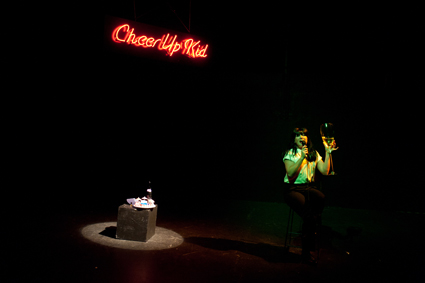
Nat Randall, Cheer Up Kid
photo Michael Myers
Nat Randall, Cheer Up Kid
While Executive Stress employs a cast of thousands, Cheer Up Kid is the work of just one writer and performer—Natalie Randall. She runs on stage wearing a white t-shirt, black pants and the broad grin of a child who has finally coerced the family into sitting down for a living room show. She briefly outlines the structure of the show, noting however that she is “completely unreliable, with no sense of consistency or consequence.” These words are repeated at the beginning of each section, so that we hear the same phrase recited by different characters, in different accents. In the second section, Randall plays a weird and bad-tempered child, who is prone to swallowing whole bottles of Vitamin C tablets, exaggerating her achievements at the school swimming carnival (winning that little known race, the 300 metres), getting swooped by magpies and secretly eyeing off the twice-cooked pork belly while being made to order the chicken schnitzel. In the third section, Randall plays an American agony aunt who slugs back a bottle of Passion Pop while dispensing advice on air, and in the fourth she plays a lonely Englishman scared his parents might die before he does.
Randall has a warm and generous stage presence, and I really enjoyed her performance in Some Film Museums I Have Known, but here she is let down by the writing, which is somewhat underdone. The characters are interesting as individuals but the connection between them, beyond their origin and juxtaposition, is not necessarily clear. Nevertheless the show, and with it the night, comes to a satisfying end when Randall slices up a “pool cake” (a classic from the Women’s Weekly cookbook) and passes it around—a gesture of generosity and hospitality that seems to encapsulate the theatrical act itself.
Tiny Stadiums Festival: Applespiel, Executive Stress/Corporate Retreat, devisor-performers Simon Binns, Nathan Harrison, Nicole Kennedy, Emma McManus, Joseph Parro, Troy Reid, Rachel Roberts, Mark Rogers; Cheer Up Kid, devisor-performer Nat Randall; PACT, Sydney, May 2-15
RealTime issue #103 June-July 2011 pg. web
© Caroline Wake; for permission to reproduce apply to realtime@realtimearts.net
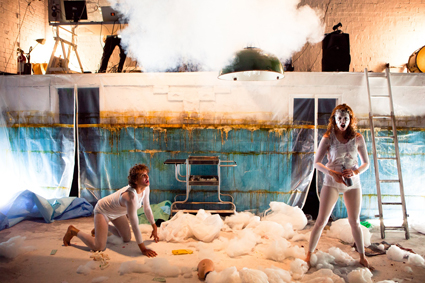
Simon Corfield and Sarah Enright, Trapture
photo courtesy of the artists
Simon Corfield and Sarah Enright, Trapture
ALL PLEASANT BREAK-UPS ARE ALIKE; EACH UNPLEASANT BREAK-UP IS UNPLEASANT IN ITS OWN WAY. WHICH IS WHY THE ONE AT THE HEART OF SARAH ENRIGHT AND SIMON CORFIELD’S TRAPTURE IS SUCH A CURIOUS THING: BY ATTEMPTING TO COVER THE UNPLEASANT BREAK-UP FROM EVERY CONCEIVABLE ANGLE—TO GIVE US, IN A SENSE, THE UR-BREAK-UP—THE PRODUCTION DOESN’T GET TO THE ESSENCE OF THE MESSY SEPARATION SO MUCH AS MERELY PRESENT US WITH A GENERALISED SURVEY OF ITS MOST COMMON AND PREDICTABLE FORMS. THE RESULT IS A PAGEANT OF MILLS & BOON METAPHORS LITERALISED AS STAGE GROTESQUERIES: AN AT TIMES HILARIOUS, BUT ALWAYS SUPERFICIAL, BREAKDOWN OF THE BREAK-UP.
The evening begins with an embrace. Enright, her mouth taped up and her wide, slightly unhinged-looking eyes meeting yours, takes your ticket, asks with a silent gesture if you would like a hug, and then takes you in her arms. The Old Fitzroy’s little theatre has been done up to resemble one of those plastic-draped rooms in otherwise empty warehouses where psychopaths wine and dine their victims before hacking them to pieces. This, as we will soon learn, is appropriate: of all the things to which Enright and Corfield compare the break-up, the most notable are disembowelment and related acts of torture. The central conceit of the piece is to realise emotional violence as physical violence.
This is, of course, something we do every day when we equate the two in language. A pleasant break-up is what you get when both parties choose to “end the relationship.” An unpleasant one is what you get when the metaphors start creeping in: when the man “emotionally raped me” or the woman “tore my heart out.” Men become “pigs” and women “bitches.” One party claims the other can “eat my shit.” For Pat Benatar love is a “battlefield.” Kramer Vs Kramer and The War of the Roses—Danny De Vito’s, not William Shakespeare’s—incorporate this idea of conflict into their titles. And Trapture seeks to give each of the above its time in literalism’s spotlight.
The show begins with Enright and Corfield dressed for a fancy date, making their way to a couch at the far side of the stage. She blindfolds him—he thinks it’s foreplay—before taking out a suitcase, throwing a few things into it and leaving him sitting there. When he finally realises what has happened, things really begin to fall apart: Enright re-emerges, dressed in surgical garb and gives her former partner a sex-change operation. Sporting a Koskian prosthetic and killer heels, Corfield waves his new vagina around in the faces of those in the front row. The performers climb into the audience, invading personal space. Masks emerge. Corfield becomes a pig and Enright a dog, the former forcing the latter to eat his shit and smearing it across her mouth. They throw bedpans of urine at one another.
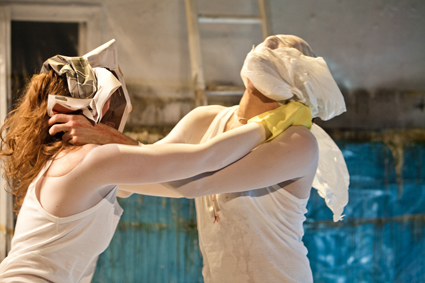
Sarah Enright and Simon Corfield
photo courtesy of the artists
Sarah Enright and Simon Corfield
In the production’s most graphic and unsettling scene, Corfield dons a clown mask and rapes Enright. She gets her revenge by sticking her hand into his chest and tearing out a cow’s heart. It’s an image straight out of The Simpsons episode “New Kid on the Block” and it is difficult for anyone familiar with that episode to take its recreation here very seriously. Indeed, I found myself marvelling less at the literalisation of the metaphor—which, as The Simpsons’ writers understood only too well, is not so much profound as hilarious—than at the fact that the actor had been wearing a bloody bovine organ strapped to his chest for the duration of the performance. Enright cooks the heart on a portable hotplate and feeds it to him. She eats a slice, too. An unholy communion.
All of this is rendered in a visual style reminiscent of visual artist and filmmaker Matthew Barney. Indeed, if Barney were to direct Artaud’s Jet of Blood, he might come up with something like Trapture. Only he wouldn’t. Barney’s use of metaphor is elaborate where Trapture’s is simplistic, providing his work with its deep, architectonic structures which are almost impenetrable. In contrast, Trapture’s structure is not even really that of a break-up, but rather a shopping list. And it’s a shopping list that, in the end, doesn’t really amount to much: referring back to a non-specific idea of a break-up—to the words we use to describe them—even the impact of the rape is lessened.
Shocking stage images, it seems to me, are becoming increasingly less shocking. I would argue that Sydney hasn’t seen a genuinely cutting one since Kosky put Robyn Nevin in Abu Ghraib for The Women of Troy (2008). As with Simon Stone’s Baal at the Sydney Theatre Company, which seems pitched to offend only a certain strata of the audience (namely the aging subscriber base), Trapture seems to suffer from putting too much stock in the inherent force of its images. That force is lessened the more it’s relied upon. It becomes increasingly difficult to care about, to invest in such images, which have less and less to do with the emotional content of an idea and more and more to do with their capacity to inspire walk-outs. Pass the heart.
Sands Through the Hourglass in association with Tamarama Rock Surfers, Trapture, director Shannon Murphy, conceived & performed by Sarah Enright and Simon Corfield, live sound design Basil Hogios; Old Fitzroy Theatre, Sydney, April 21-May 14. Trapture by Sands Through the House Glass won Best Show Sydney Fringe 2010.
RealTime issue #103 June-July 2011 pg. web
© Matthew Clayfield; for permission to reproduce apply to realtime@realtimearts.net
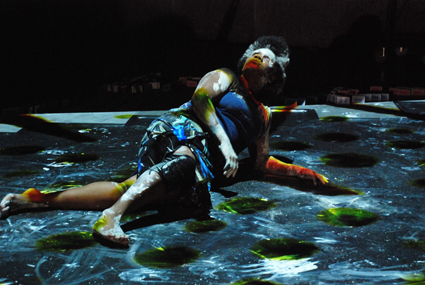
Ghenoa Gela, Briwyant
photo Marian Abboud
Ghenoa Gela, Briwyant
VICKI VAN HOUT’S CHOREOGRAPHY IS SOME OF THE MOST IDIOSYNCRATIC AND INVENTIVE SEEN IN AUSTRALIAN DANCE FOR A LONG TIME AND HER TEAM OF DEXTROUS DANCERS EXECUTE IT WITH HIGH PRECISION, UNBELIEVABLE ENERGY, HUMOUR AND ATTITUDE. VAN HOUT HAS BEEN A BUSY DANCER, CHOREOGRAPHER AND RESEARCHER TRAVELLING EXTENSIVELY TO INVESTIGATE INDIGENOUS DANCE. SHE HAS A COUPLE OF SUBSTANTIAL WORKS BEHIND HER, HOWEVER IT’S A NEW CREATION, BRIWYANT (FOR ‘BRILLIANT’), THAT COULD BRING HER THE ATTENTION SHE WARRANTS THANKS IN PART TO A SHORT BUT SIGNIFICANT PERFORMANCE SPACE SEASON.
In 2009 I was impressed by Pack (RT94), a sizeable piece in a Dirty Feet program of short works. I wrote: “In an intense work, four dancers, moving with bird-like alertness and the deep stepping of certain Aboriginal dance forms, map out their space territorially (with tape) and on each other’s bodies (with clothes pegs). Moments of intense, swiftly danced collectivity contrast with power plays and grooming displays—pegs removed gently from pinched flesh. This fascinating work, in which the tipping point seems to be whenever ‘enough is enough’ and the dividing tape is ripped up, fuses contemporary dance with Indigenous inflections to suggest that when it comes to territory we humans are pretty much just another animal.”
In Briwyant, Van Hout pays similar if much richer and more elaborate attention to the integration of dance with design. Scarves, for example, are transformatively shaped to suggest digging, cradling and the binding of one person to another. Hundreds of playing cards are arranged across the performing space evoking a riverscape. These are deployed, quite laterally, like the dots of the Indigenous paintings that fascinate the choreographer with their shimmering brilliance. On the Performance Space website, Van Hout writes, “Cards/ As the repetition of a dot/ Layed down as a river/ As a deck to share the wealth/ Made from?Dots on a canvas/ When sung/?Signify ancient power/ To transport us to the dreaming/?The everywhen.” She explains, “Briwyant is inspired by bir’yun: brilliance, shimmer and shine. In Yolngu traditional painting, bir’yun is the effect of intricate crosshatched patterns creating a sensation of shimmering movement over the painting’s surface, a manifestation of ancestral forces.” Briwyant conveys an engrossingly similar phenomenon when a dark upstage rectangle disappears the dancers but then bathes them in sparkling light.
The choreographer’s sources are many, drawing on and effectively melding diverse Indigenous and other forms within a dance theatre framework that ranges from droll rhyming verse (delivered by the charismatic Van Hout herself) to a lucid dreamtime tale transformed into dance, to witty social encounters and sometimes mysterious but never less than intriguing images pertaining to Indigenous art and culture.
Soundtrack, media and lighting are occasionally burdened with superfluities, but the best of Marian Abboud and Imogen Cranna’s digital media effects, Elias Constantopedos’ score and Guy Harding’s lighting fuse seamlessly with Van Hout’s organic exploration of the relationship between bodies and the lines, dots and the hatched ‘shimmer’ of Indigenous art. Danced organically across Van Hout’s playing card landscape design, this makes for a powerful experience, at once magically elusive and cohesive. Dancers Henrietta Baird, Ian RT Colless, Ghenoa Gela, Raghav Handa and Melinda Tyquin are superb.
See also an interview with Vicki Van Hout.
–
Briwyant, Performance Space, choreographer, designer, performer Vicki Van Hout, dancers Henrietta Baird, Ian RT Colless, Ghenoa Gela, Raghav Handa, Melinda Tyquin, digital media effects Marian Abboud, Imogen Cranna, composer Elias Constantopedos, dramaturg Kay Armstrong, lighting Guy Harding; Performance Space, CarriageWorks, Sydney, april 13-16
RealTime issue #103 June-July 2011 pg. 32
© Keith Gallasch; for permission to reproduce apply to realtime@realtimearts.net
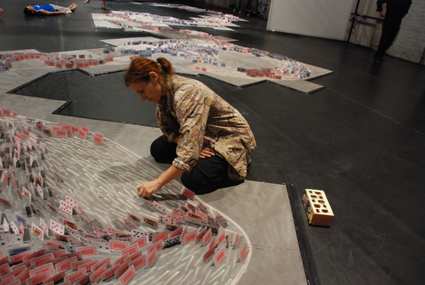
Vicki van Hout working on the installation/set of Briwyant
photo Marian Abboud
Vicki van Hout working on the installation/set of Briwyant
IT IS TWO DAYS AFTER THE OPENING NIGHT OF VICKI VAN HOUT’S NEW DANCE WORK BRIWYANT (FOR ‘BRILLIANT’). WE ARE IN BAY 20 AT CARRIAGEWORKS, THE SPACE WHERE THE PIECE IS PRESENTED. IF VAN HOUT FEELS AT ALL PLEASED WITH THE POSITIVE FEEDBACK HER LATEST WORK HAS RECEIVED FROM AUDIENCES, PEERS AND CRITICS ALIKE (P32), SHE CERTAINLY DOESN’T LET ON. “THE WORK ISN’T DONE YET,” SHE SAYS MATTER-OF-FACTLY.
And it’s easy to see what she means: The cavernous theatre space is split into two by an enormous river-like installation made up of several thousand playing cards. After every performance, each card needs to be reglued to the ground edgewise—a complicated procedure that takes up to seven hours. An activity expected from an installation artist maybe, but from a choreographer?
“You gotta give it a go,” Van Hout quips. “I’m a perennial student. I’m interested in other artforms. At first I thought this piece should be in an art gallery. Sometimes I feel dance is not enough anymore. I like integrating other forms of art into my work. In some ways it’s an excuse to find out about things I don’t know much about.” After a pause, she shrugs: “Who knows? Maybe at some stage there will be no dance at all anymore. My interest in the arts didn’t start with dance so maybe it won’t end there.” And as for those cards? “I’m lucky,” laughs Van Hout. “My 60-plus year old mum has taken time off work to help me and the stage manager.”
A Wiradjuri descendant growing up in Dapto in regional New South Wales, Van Hout didn’t start to train in dance until her late teens. All through high school she had taken drama lessons, wanting to become an actor. She recalls, “Around the time I was living in a squat, The Gunnery at Wooloomooloo, and this guy suggested I should go to NAISDA instead. I remember asking him: ‘What’s that?’ He said, ‘A place where you learn about your own people.’ I liked that.”
After four years at NAISDA, the National Aboriginal Islander Dance College, Van Hout received an overseas study award from ATSIC (Aboriginal and Torres Strait Islander Commission) to train at the Martha Graham School of Contemporary Dance in New York. Far away from the usual preconceptions and prejudices regarding her aboriginality, Van Hout relished the opportunity to immerse herself in a culture not her own. “As I’m quite fair-skinned, not a lot of people recognized I was indigenous and hardly anyone asked any questions. I hung out with a lot of musicians from the alternative music scene and punk culture. Our haunt was Manic Panic, the now legendary punk store. Their tagline was ‘Live Fast and Dye Your Hair’.” And yet, Van Hout took her dance training very seriously. After graduating from the Graham School, she stayed in New York to train and work with various modern and postmodern dance artists. “My concern was that I wouldn’t have anything to show for my time there,” Van Hout says. “I didn’t want to come back without skills.”
All up Van Hout spent almost seven years in New York, eventually returning to Australia in 1996 to perform with Bangarra Dance Theatre on an Asian tour of their seminal dance work Ochres. She later joined Marilyn Miller’s Fresh Dancers collective created to focus on the corporate and commercial market. After initially working mainly as a dancer, she soon helped to choreograph many of the works presented at indigenous events and functions. She then gradually moved into creating her own work. “It was actually [fellow indigenous choreographer] Jason Pitt who encouraged me to take that leap,” remembers Van Hout. “One day he looked at me and said, ‘What have you got to lose? Just go for it, sister.”
And go for it, she did. Working incessantly over the following years, Van Hout has steadily built a reputation as one of our most interesting and prolific independent dance artists. She has developed a growing following for her deftly imagined and thoughtfully crafted works examining urban indigenous realities, especially in NSW.
Briwyant is Van Hout’s third full-length work. Conceived as a cross-cultural, inter-disciplinary dance piece, it examines the ongoing nature of ‘traditional’ Aboriginal practices based on story telling through the act of painting. As in many of her works, van Hout aims to explore the commonality between traditional and urban cultural experiences and how indigenous cultural information is disseminated: “I’m interested in what was, what is and what is similar. I’m always trying to find what is contemporary and relevant.” The work started out as an idea for a solo and evolved into its current form featuring six performers including herself.
“My initial interest,” explains Van Hout, “was in the question: what is it to look white and identify as indigenous? I wanted to peel back layers and find out what’s underneath.” She is outspoken on the issue of claiming her indigenous heritage: “It’s a birthright but not only a birthright. It’s living an obligation defined by what you do. You are what you do.” It is not surprising then that Van Hout is a passionate teacher who has been working at NAISDA for over 10 years. She feels a strong responsibility, she says, to pass on the cultural information and knowledge she has acquired. “I have been taught [Aboriginal traditional] dances, it is my responsibility to pass them on. They are not the sum of me though. I’m also teaching the contemporary indigenous technique that I have been developing through my own work. I want to instil body discipline in students so that they can be adventurous and try something different.”
As important as the engagement with her Aboriginal heritage is to her, at the same time Van Hout is adamant that she doesn’t want to be “put in a box.” She wants to be taken seriously as a choreographer on the basis of her skills, not merely for the fact she is indigenous. Recently interviewed for a case study of artists affiliated with Performance Space, she said: “It’s important to me to participate in the broader dance and performance arena. I want to be critiqued on a par with everyone else .”
This might explain Van Hout’s extensive engagement with dance outside exclusively indigenous contexts. In the last few years she has created numerous works for both tertiary institutions and youth dance companies such as ATYP, youMove, fLING Physical Theatre and DirtyFeet, as well as WAAPA, to name but a few. She also frequently employs non-indigenous dancers for her works. The cast of Briwyant, for example, is decidedly mixed. “We’re an eclectic bunch, no one is the same,” laughs Van Hout. And there is no question that she likes it that way. It confirms her fascination with juxtaposition, a device she frequently employs in her works.
“I like things that sit side by side and can’t be rationalised. I want to give people a glimpse, not lay it out for them.” The seminal experience that triggered her thinking in this respect occurred many years ago: “I was in Maningrida [indigenous community, Northern Territory], it was about 22 years ago, and I observed a young woman washing her child’s hair on a piece of corrugated iron while watching Dallas on a portable TV on the veranda of the nearby house. It was the most bizarre vision. But it had such poignancy and absurdist poetry. That’s what I strive for in my work.”
See review of Vicki van Hout’s Briwyant
RealTime issue #103 June-July 2011 pg. 31
© Martin del Amo; for permission to reproduce apply to realtime@realtimearts.net
MARTIN DEL AMO IS BEST KNOWN FOR HIS INTRIGUING SOLO WORKS AND FOR SOME OBSERVERS IT MIGHT SEEM THAT HIS MOVEMENT LANGUAGE IS SO INTERLINKED WITH HIS PHYSIOGNOMY THAT IT CANNOT BE PERFORMED BY OTHERS. HOWEVER FOR SEVERAL YEARS NOW DEL AMO HAS UNDERTAKEN A VARIETY OF RESEARCH PROJECTS INVOLVING HIM AS A NON-PERFORMING CHOREOGRAPHER. A RECENT PROJECT AT SYDNEY’S CRITICAL PATH SAW PAUL WHITE PERFORMING AN UNCANNILY ACCURATE YET TRANSFORMED VERSION OF ‘DEL AMO’ MOVEMENT.
Discussing his reasons for the transition from solo performer to director-choreographer, del Amo cites Kate Champion from Force Majeure who was also, at one stage, best known for her solo works. “Kate said you can only mine yourself for material for so long and at some point you get more interested in other people’s backgrounds, stories and ideas. I think this is exactly what happened to me. I’ve always really enjoyed working by myself and having that freedom but sometimes I thought it would be nice to work with other bodies and have another input on that level.”
Del Amo undertook some early research in 2008 with WAAPA’s post-graduate dance company, LINK. The work, Mountains Never Meet, an exploration of the difference between walking and dancing, was made with an all female cast. “I was working with very reduced movement material, but treating it in a complex way choreographically and that was quite difficult for the dancers…it [required] completely adapting or un-learning what they had studied over the years.”
While he found this process valuable del Amo says, “I felt there was something else in that work—the way it could communicate with audiences— that could be captured in a different way.” So for the version that is to take place in August as part of the Western Sydney Dance Action and Parramatta Riverside Dance Bites program, del Amo has chosen to redevelop the work with nine male non-dancers. Having finalised his cast with co-operation from Bankstown Youth Development Service (BYDS) he says, “I’m really happy with the guys that we’ve got now. It’s an eclectic bunch from different cultural backgrounds, different ages [ranging from 15 to mid-20s] and they also have slightly different sporting or physical backgrounds.”
For Mountains Never Meet del Amo has also invited former professional soccer player turned performer Ahil Ratnamohan—most recently seen in his own work, The Football Diaries (RT91, p42) and in Branch Nebula’s SWEAT (RT102, p15)—to take on the role of artistic associate. The working relationship between the two is an ever-evolving one. While del Amo has worked as a mentor on some of the younger artist’s projects, Ratnamohan has taken on the role of trainer and consultant on del Amo’s works such as It’s A Jungle Out There (2009-2010). “I wanted a more urban, non-dance feel and asked him to do soccer training with me to improve my footwork. Out of that—being his mentor and him being mine—we established some kind of training practice.” As well as performing in this project, Ratnamohan will have the roles of collaborator and liaison with the other performers. Del Amo says, “the choreography and direction is with me, but we’re actually sharing how that is being implemented.”
Ratnamohan will also perform in Duel, a duet with Connor Van Vuuren that Martin del Amo is choreographing to accompany Mountains Never Meet. “Duel involves much more intricate movement and is inspired by some memorable sporting battles, but not tied to one particular sport.” Again, the performers have different training backgrounds, Ratnamohan in soccer and van Vuuren in martial arts and gymnastics, so the choreographic relationship is ambiguous—“Is this a battle against each other, with each other or for each other? It’s also an investigation into what constitutes a duet. In some ways it’s set up as two intertwined solos rather than as a proper partnering duet.”
Del Amo is also known for his strong collaborative relationship with composers and in this instance he will continue his collaboration with Cat Hope who scored the original LINK version in Perth. Del Amo says, “The sound world Cat has created relates to the physical concept of the work without mirroring or imitating it. It features whistling, urban sounds such as AM radio and a big percussion section consisting of marching band sounds without the band music. Cat will digitally manipulate pre-recorded elements live which ensures some ‘breathing room’ for the interplay between movement and sound. “
Both Mountains Never Meet and Duel look to be exciting additions to Martin del Amo’s impressive and highly idiosyncratic body of work.
Western Sydney Dance Action & Riverside Theatres 2011 Dance Bites, Mountains Never Meet, choreographer Martin del Amo, artistic associate Ahil Ratnamohan, performers Ahil Ratnamohan, Connor Van Vuuren, Fraink Maino, Benny Ngo, Mahesh Sharma, Sean Stanley, Nikki-Tala Tuiala Talaoloa, Dani Zarodosh; composer Cat Hope; Parramatta Riverside Theatre, Aug 17-20
RealTime issue #103 June-July 2011 pg. 32
© Gail Priest; for permission to reproduce apply to realtime@realtimearts.net
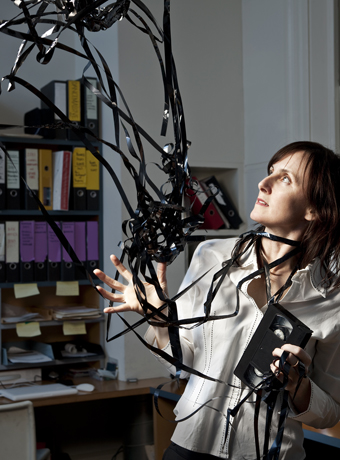
Sandra Parker, Document
photo Rachel Roberts
Sandra Parker, Document
MELBOURNE CHOREOGRAPHER SANDRA PARKER’S LATEST WORK DOCUMENT, “AN IN-DEPTH EXPLORATION OF THE WAY IN WHICH A ROOM RETAINS THE RESIDUE OF HUMAN OCCUPATION,” WILL PREMIERE IN JULY. THE WORK IS EMERGING FROM A 14-WEEK RESIDENCY AT DANCEHOUSE. PARKER WAS ARTISTIC DIRECTOR OF DANCE WORKS 1998-2006 MAKING DISTINCTIVE CROSS-ARTFORM CREATIONS. HER WORK HAS BEEN SHOWN INTERNATIONALLY, INCLUDING NEW YORK IN 2007 WITH THE VIEW FROM HERE, AND IN CHINA WITH PLAYHOUSE FOR THE GUANDONG MODERN DANCE COMPANY.
Will you physically create a room or use video and movement to do so?
I’m interested in trying to evoke a room, a rehearsal or performance space in image and light; and also through using language to describe the qualities of the space. I’m keen to play with the juxtaposition of the actual performance space with details about the space conjured up by using other media. This may or may not confirm what is actually there in the ‘real’ space, or might have been there at another point in time.
Who are the artists you’re working with and how will each contribute to your exploration?
Rhian Hinkley (projection designer; see p29), Jenny Hector and Rose Connors Dance (lighting designers), Steven Heather (composer) and Rebecca Jensen (dancer) will bring responses to the ideas and offer material. Our collaborative approach is to see where the correspondences, counterpoints and parallels lie between forms then try to find combinations that open up and suggest ways of experiencing the ideas at play within the performance. For example, I might make movement that I think feels one way but, when watched with certain sounds, radically alters the perception of the movement. I look for ways to use collaborative material as active in the performance and not just ‘accompaniment’ to the main action. I’ve also asked performers I have worked with before to contribute to the process of making the work.
Precisely how do you generate the material—do you have a particular methodology?
I began the project by asking dancers Deanne Butterworth, Carlee Mellow and Joanna Lloyd— with whom I have worked previously, but who won’t be directly involved as performers in this project—to come into the studio with me and respond to a series of questions through a ‘performed interview’ about work we have created together. In one case, this spanned back some 15 years. I am interested in not only what they remember of the movement and why, but also other things that are remembered about making work. Responses have ranged from things like describing the atmosphere of the space, how they felt about what they did, how they approached performance and personal things that were going on in their lives at the time.
I’ve also been interested in trying to describe movement. The gap between what we think movement is, what we say about it, how it appears and if it can ever be ‘perfectly’ documented in language, video or sound; and also the sometimes vastly different perception of process, choreography and performance that can exist between the choreographer, external to the work and the dancer internal to it.
I’m working with Rebecca Jensen for the first time. We met at VCA and again when I led the Learning Curve residency for recent graduates at Dancehouse in 2010. Earlier this year Rebecca also came and worked on secondment during a creative development for my new project, The Recording. She represents a new generation of young Melbourne-based dancers. I was interested to work with someone with whom I have little history, as opposed to the long-term relationships I have with Deanne, Carlee and Jo. I am interested to see how Rebecca works with material that is passed on to her through these dancers and how it changes. What detail is maintained, or left behind.
Elsewhere you’ve used ‘documents’ to describe what comes out of your process?
By documents, I mean creative material. I usually work by generating a lot of material and collect movement phrases, sound, text, video material, then start layering things. I look for tension between elements: a summation of parts. The collected material will range from drafts of choreographic material to ‘formed’ phrases that we have decided are finished. I want to try to use everything—even if it isn’t necessarily ‘finished’ material.
You’ve expressed “an interest in capturing the physical traces and after-effects of movement once it has passed,” saying, “ Document will chronicle the evidence of events that are seemingly over and complete, yet somehow remain.” Given the preoccupation with “the now” in the work of a number of contemporary practitioners it’s fascinating to see you addressing traces. How did you come to this preoccupation?
I think this interest harks back to some really early works, in absentia (1997) for example, a work with 16mm film that I made with Margie Medlin. The ephemeral nature of dance is so fundamental to working in the form that it poses a central problem that I have always found challenging and opens up many questions about how to approach dance making. I’m interested in the problem of trying to capture movement—actually ‘choreograph’ it, to set it down, if in fact that is ever really possible. The problem of trying to set movement and then return to it and re-perform it, could be seen as a futile exercise in trying to reclaim that which can never be recaptured; but for me it also offers a way to question assumptions about what you think is ‘there’ and to make it anew, to reinvent, to ask what else movement can do.
The fact that movement is ephemeral lets you give it up and move in new directions. So if traces exist in the work they are there as tools to show this difference—not simply as nostalgic recollections, but to say, this is what it might have been, but now this is what it could be.
You’ve written, “the process of creating Document will seek to investigate how choreography can be understood as a record of bodily memory and sensation.” What do you think the ramifications of this are for choreography?
A few years back I watched a documentary on the Ballet Russes that contained footage of company dancers re-enacting choreography. I was struck by how their bodies held very clear sensations of movement, even though they weren’t leaping through the air. I was intrigued by how this represented a dance experience because much of what we normally expect from dance was completely taken away, yet it felt so ‘full.’ I became interested in the ramifications of this for choreography, to move beyond representation or conceptualising movement to the co-presence of phenomena interior to the body as it moves. I’m interested in exploring the possibility of creating a poetic choreographic rendering that envelops and embeds a density of experiential phenomena under the surface of choreography, what French dance writer Laurence Louppe suggests is “the tracing of what the letter does not say, but where another text shows through, another reading of living substance.”
I think this is especially relevant given the current preoccupation in dance with needing to produce ‘product’ that has a sense of solidity about it. Or that appeals directly to particular tastes or markets or can be identifiable in certain terms. I am interested in trying to open up and question what is there before us on stage.
You’ll find reviews of Sandra Parker’s works in our extensive 1994-present
archive, RealTimeDance
Sandra Parker, Document, from Housemate VII Residency, Dancehouse, July 27-31; www.dancehouse.com.au
RealTime issue #103 June-July 2011 pg. 33
© Keith Gallasch; for permission to reproduce apply to realtime@realtimearts.net
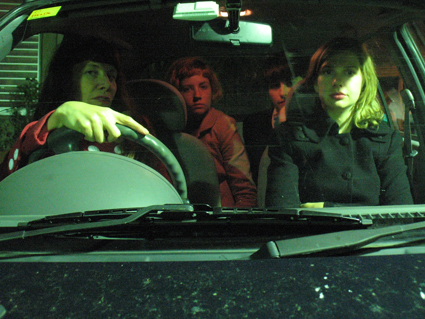
Spotlight Bunny, Julie Vulcan, Ashley Scott & Friends with Deficits
courtesy the artists
Spotlight Bunny, Julie Vulcan, Ashley Scott & Friends with Deficits
ONE OF THE MOST IMPORTANT DEVELOPMENTS FOR PERFORMANCE IN RECENT YEARS HAS BEEN THE EMERGENCE OF YOUNG INDEPENDENT PRODUCERS, FESTIVAL DIRECTORS AND CURATORS. MANY ARE WOMEN, OFTEN WORKING IN TEAMS AND PRODUCING EVENTS THAT PRESENT BUT ALSO NURTURE NEW WORK—DRAMATURGICALLY BUT ALSO IN TERMS OF MANAGEMENT, RISK AND TECHNICAL AWARENESS. IMOGEN SEMMLER IS ONE SUCH PRODUCER CREATING UNDERBELLY IN 2007, A FESTIVAL WHICH SUPPORTS INDIVIDUAL ARTISTS AND GROUPS, EMERGING AND ESTABLISHED, WORKING IN A VARIETY OF PRACTICES. THIS YEAR THE THREE-WEEK WORKSHOP AND PERFORMANCE DAY WILL BE STAGED ON SYDNEY’S COCKATOO ISLAND.
Underbelly in 2011 predictably includes a diverse range of projects. Here’s a few examples. The Sexy Tales Comedy Collective will develop a theatre and music work titled 100 Years Of Lizards. Neil Brandhorst’s Horizon will be an installation that “disrupts the sensory information required to make sense of the environment…revealing how previous experiences provide meaning in new situations, and result in the feelings and urges that become our behaviour.” Spotlight Bunny, a work conceived by Sydney performance maker Julie Vulcan working closely with sound maker Ashley Scott and emerging performance collective Friends with Deficits to “explore location, the influence of soundtrack and the slippery nature of context. Influenced by drive-in culture, it blends the past with today’s iPod culture in an intimate performance for four audience members at a time in a stationary car.”
In Inflate My Heart With 1000 Gushes Of Wind, Swanbrero will “insert a piece of Parramatta Road into the natural wonderland of Cockatoo Island. The work will experiment with large-scale interpretive choreography, costume and wind to create melancholic spectacle.” The group (Corey Crushcore Dreamlover and Lara Thoms) describe themselves as “faded, cheap, fraying and bending over so far that their heads are scraping the ground.”
Tell me about starting up Underbelly and why you did it?
I come from an events background, working on different festivals and putting on little events myself—sort of underground. I liked the idea of bringing a lot of artists together in a festival but also starting with the development of their projects. Having artists together you’d see them make great connections, but it was fleeting and then they were off. So I thought it would be good to bring development and presentation together under the one roof.
Secondly, I felt there was a lot of stuff happening in Sydney at the time that was perhaps a bit hard to access, say about five years ago. There were great underground spaces but you had to be in the know. This was pre-emailing list, pre-Facebook, so it was more text messages or word of mouth. I started talking to groups who I’d been working with or knew of and put together a group of local artists with projects.
The first year was very much curated. I came up with the concept and just did it with people I was interested in and staged it at CarriageWorks. The second year we did it there again but it was open to applications—a lot of people said, how can we get involved? So that process has continued, which has been great.
You’re still curating or is it more like a fringe festival model?
We have a curating committee—applications come in and we choose projects. We have certain loose criteria—to support emerging artists and artists experimenting with new forms or more established artists pushing themselves in new directions or wanting to do more research-based work.
Would you or your committee have seen much of the work?
Not necessarily. We focus on new work. Artists have to have a pretty good argument as to why their work should be included because the whole idea of the residency is to present something for the first time. Sometimes it’s a work in progress. Some projects develop just a few scenes or the beginning of an idea.
And audiences watch the development?
Yes. We’ve had shows that have gone on to become fully formed and feature at fringe festivals or Next Wave. It’s good to get projects at an early stage—they need the lab time.
So you’re providing a service for people to innovate. Do you charge artists for that?
No. This year we’ve developed a project fund. It’s not a huge amount of money but we want to resource projects. We don’t want artists to be out of pocket. If they come with an existing grant or other support, that’s great but we do try as best we can to facilitate their project; that includes technical support, publicity, marketing, the venue…And we provide a lot of mentoring. For a lot of the artists, this might be the first time they’ve been involved in a festival. We help them with producing, budgeting, maybe the technical side of producing and we ask them all to do risk assessments. They might not have done that before so we’re happy to hold their hands and take them through the process. But we’re not doing it for them—we make sure they learn. There’s a lot of contact. We have a producer who works directly with the artists. I did this in the first few years but now we’re expanding.
How many of you are there?
At the moment there’s Clare Holland, our executive director, and myself. In two weeks we’ll have our event producer Jenn Blake and then we’ll have a production manager, a technical co-ordinator and a marketing co-ordinator, a publicist and an artist co-ordinator, like a program co-ordinator who manages all the artists. So it’s a big team!
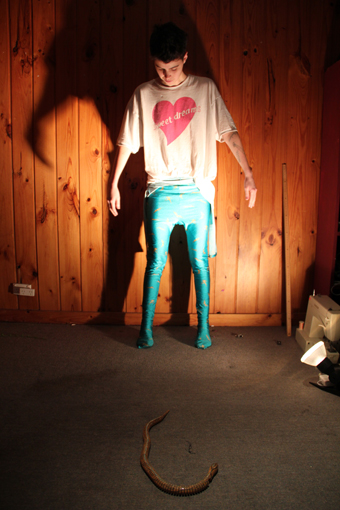
Corey Crushcore Dreamlover, Inflate My Heart With 1000 Gushes Of Wind, Swanbrero
courtesy the artists
Corey Crushcore Dreamlover, Inflate My Heart With 1000 Gushes Of Wind, Swanbrero
Does the income from box office keep the event afloat?
Box office is a very small part of our income, mainly because the lab is running for three weeks prior to the festival which is a one-day event—and we try to make the tickets quite cheap, around $15 to $20. It’s a bit like a music festival where you choose shows and wander round installations. You get to see the whole gamut of what’s on offer. We started out with very little money, but CarriageWorks was a great venue partner—they gave us a lot of in-kind support.
We set up as a not-for-profit organisation and grew gradually. We started getting support from the City of Sydney, set up more formally in 2009, and had a year off because I realised it wasn’t going to be sustainable if we just kept doing it on a shoestring.
We get Arts NSW funding and we’ve recently received first time Australia Council funding for this event through the ARI [Artist Run Initiative] fund. We’ve also found really interesting partnerships with foundations whose interests are aligned with ours, and we have an amazing board.
How do audiences engage with Underbelly?
During the lab, we run tours. We invite the audience to come and watch the projects in development. One of us will take you round and you’ll meet the artists. And what’s happening more and more, because of the audience component at the lab, is that artists are applying with projects that need the audience for development—maybe content generation or particular feedback or testing things or interactivity or even making or building things. So that allows the lab experience to be really fun for the audience and it’s also giving artists unique access to the public through a residency. So it’s not just a work in progress showing. It might be the I Can Draw You a Picture team—they made a printed publication last year with the audience generating the content during the lab.
We call this the Public Lab. People can come pretty much every day for 10 days of the three weeks. You can come out to the island and do a tour. Projects that really require audience participation might want two hours a day. So we’ll pop that in the lab calendar that from, say 1-3pm, head out to the island and you can take part in this project. There’ll be social experiments where the audience become active participants. A quarter of our projects would have that component but it’s often those that then go on to other festivals. There’s a real live art push and I think that term is constantly evolving where once it was performance art or contemporary performance. In this area huge boundaries are being blurred between audience and artists and participants.
What characterises the works that appear in Underbelly?
We have a lot of installation, works by visual artists and filmmakers. We’ve had a couple of dance films over the years—the dance pieces are created on site, filmed, edited and shown. A filmmaker last year made a 3D video where you looked through a little box. He did it with really cheap technology because he’d been working in really high-end production for big companies but he wanted to show people how you could do it really cheaply and easily using a few mirrors and an old monitor. We also have a lot of dance and theatre. We’ve had the classics—Pig Island and Eddie Sharp. Whale Chorus are back this year with a project. There a lot of emerging and experimental theatre people, a lot of hybrid stuff, a lot of blending and theatre work like Eddie Sharp’s Some Film Museums I Have Known (shown at the Old Fitzroy recently).
The word that was associated with Underbelly for a while was “underground.” Is that still a viable term?
I think it’s really moved on, particularly in Sydney. The “underground” as it was five years ago has really blossomed through different changes such as to the licensing laws, the support of FBi Radio, the inner west venues—different elements that have brought that culture out into the open. For years you heard that there wasn’t much going on in the arts unless you were in the know. Now people are saying, “oh wow there’s heaps of stuff happening.” You see it in events like Tiny Stadiums, Imperial Panda, new venues, Performance Space’s LiveWorks and their Clubhouse. A lot of it is because groups have come out of what was the underground five or 10 years ago.
Is Underbelly becoming more of a full-time job?
It’s becoming more full-time, which is great. Bringing Clare Holland our executive director in has been a huge part of that—the ability to work year-round and find the funding to do it. It’s not full-time but it’s definitely part-time most of the year. I do other independent producing work. I did the Statues Project for City of Sydney’s Art and About last year and I produce some theatre for other people. I do research for documentaries in my other life. It’s about juggling. I think making Underbelly sustainable has been a really big focus. .
You usually get a good turnout on the big day. How many are you anticipating this year?
We’ll expect maybe 1200-1500 if it’s a nice day. If it’s raining, it’s about who wants to get on the ferry. The thing is, people like going out to Cockatoo Island. Even though it’s winter. I think the Biennale has shown that everyone’s still pretty happy to go out there and its all under cover. You don’t have to worry about getting wet—you just don’t take your jacket off.
Underbelly Arts, Underbelly: Public Lab, July 3-12; Festival, Cockatoo Island, Sydney, July 16 , http://underbellyarts.com.au
RealTime issue #103 June-July 2011 pg. 34
© Keith Gallasch; for permission to reproduce apply to realtime@realtimearts.net
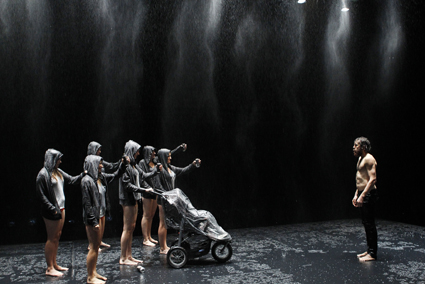
Baal, Malthouse & STC
photo Jeff Busby
Baal, Malthouse & STC
SIMON STONE CREATES HAUNTED THEATRE. NOT HAUNTING THEATRE (THOUGH IT CAN BE THAT). AND NOT THEATRE THAT HAS MUCH TRUCK WITH THE SUPERNATURAL, THOUGH I WOULDN’T GO SO FAR AS TO SAY THAT HIS IS A WHOLLY SECULAR OR MATERIALIST AESTHETIC, EITHER. BUT LIKE MANY OF HIS CONTEMPORARIES, HIS THEATRE IS SHADOWED BY RESTLESS SPIRITS AND THIS IS NOWHERE MORE EVIDENT THAN IN THE DIVIDED RESPONSES TO HIS RECENT PRODUCTION OF BERTOLT BRECHT’S FIRST FULL-LENGTH PLAY, BAAL.
The reactions to this production have canvassed the spectrum from rave to rubbish; on Alison Croggon’s Theatre Notes blog, the play produced one of the longest series of comments to date, with much passion displayed by respondents. It often came down to its writer: was there enough Brecht in here, or too much? And which Brecht? If this is the least ‘Brechtian’ of his writings, what can we do with it? Can we tackle Brecht from a post-Brechtian position, or is he inextricably embedded in the firmament of Western theatre?
It was Derrida who coined the term ‘hauntology’ and, while only a minor part of his critical theory, it’s a concept that has been picked up and developed in other areas, most notably musicology. For Derrida it was a notion used to explain the lingering presence of Marx in the post-Marxist era—an age which has seen the death of the Communist project, but which is still haunted by its echoes. The spectre of Marx is neither living nor dead; or, we may be done with the past, but the past isn’t done with us.
Brecht is dead. Long live Brecht. A canon-related demise, perhaps. If, as Nietzche argued, a being is only defined at the point of death, when the possibility of becoming something else is reduced to zero, then poor Bertolt is as stiff as a plank. It’s hard to think of anything new that the writer could become. We’ve picked at, held up and turned over every scrap of his corpus. At best, a new production can aspire to the level of autopsy.
The point here is that Stone should be able to do whatever he pleases with the body of Baal, but his liberal reworking of the original is troubled by the elusive spectre of its progenitor. It’s a problem that unsettles so many adaptations of modern classics—we know what this text has to mean, so why is the voice of its author just a faint distraction at the edge of hearing? You can do what you want with your source—it’s the postmodern age, after all—but make sure the “spirit” of the original is firmly contained. It’s a criticism that’s been levelled at Kantor, Andrews, Lutton: they’re dressing phantoms in fancy robes, only serving to remind us of the death of the authentic, original voice.
And so this Baal is haunted by what it’s not. Stone reimagines the barbarous, adulated poet at its centre as a misanthropic rock god celebrated by the very society against which he pits himself. In this vision his descent into squalid self-gratification becomes a retreat into narcissistic solipsism; everyone in his world becomes a fractured mirror on his own psyche. Theatrically, it’s a potent interpretation: Stone establishes a recognisable onstage world before flipping a switch and taking us into an utterly different mode of being, in which ‘character’ (already a loosely applied concept here) is not just destabilised but liquidated.
It should be effective stuff. But there’s that spectre that won’t be laid to rest: what about Brecht? Why should it matter? I don’t think the playwright’s original text is all that much chop (neither did he, in the end). So why should it matter where he exists in all of this? It’s a question that hovers around Beckett too, and Chekhov, and Ionesco. I don’t think it should, but I don’t know what to do about it. Call in an exorcist.
Real TV’s recent production of British playwright Debbie Tucker Green’s Random was anything but haunted—it’s as fresh a piece of theatre as I’ve seen in years performed with a vitality that exceeds containment, with an immediacy that’s bracing. It’s difficult to believe that the script wasn’t written specifically for sole performer Zahra Newman, at times seeming almost as if it’s being written at the moment of utterance. It might be the unfamiliarity of the material, which traces a tragic day in the life of a British-Jamaican family of four; it’s a corner of London life that I can’t recall having been represented on Australian stages. But credit should really go to Newman’s performance, which I found jaw-droppingly acute. Her command of four distinct voices seems measured down to the micro-tonal level; even the simplest of gestures here conjures both character and the world in which they exist. Director Leticia Caceres has honed the piece to a fine point: there are no slack moments or unnecessary embellishments.
Random was presented at Brisbane’s WTF (World Theatre Festival) this year before a season with Melbourne Theatre Company. I was intrigued to see the Melbourne season located within the MTC’s education program. Certainly, it’s a piece that will easily resonate with teens and, quite likely, inspire many to delve deeper into theatre. But it’s also a piece that deserves to be seen by a broader audience. I hope it’s allowed to live on.
Somewhere between these two productions is Laurence Strangio’s version of Pirandello’s Six Characters in Search of an Author. It should be a dead play—it’s been worked over by so many student productions and university syllabi that it’s taken on the air of a museum piece. But Strangio’s production was an unexpected delight, both carefully judged and imbued with its own irreverent spirit.
This Six Characters… was an event. For all its self-referential meta-theatricality, Pirandello’s original is still a play. Strangio adds further layers which both problematise and extend the work’s conceit: here we are witnessing two actors and a director prepare for a reading of Six Characters in Search of an Author, before they are interrupted by six actors playing the six characters. The production widens the frame of its ur-text to encompass the site of its staging (quite literally, as it seems every nook of La Mama holds a secret in this work). The performers themselves are integral to the production’s meaning—it’s hilarious to watch Natasha Jacobs complain that Caroline Lee is too old to play her, while casting playwright Adam Cass as the director eventually takes on extra significance when that role shifts towards the ‘author’ of the play’s title.
It’s the integration of the audience that probably invigorates this piece, however. There’s no limp ‘audience participation’—rather, there’s no erection of a fourth wall to begin with. On the night I attended audience members were happily talking to actors throughout, anticipating events, making in-jokes, praising bits of direction. There was still a play occurring somewhere in there, but by acknowledging the essential artifice of the whole shebang we were invited to investigate it from the inside, rather than dissect it as a preserved fossil of another era. Pirandello is dead, for sure, but for two hours here I quite simply forgot that he’d ever been alive.
Baal, writer Bertolt Brecht, translators Simon Stone, Tom Wright, director Simon Stone, performers Brigid Gallacher, Geraldine Hakewill, Luisa Hastings Edge, Shelly Lauman, Oscar Redding, Chris Ryan, Lotte St Clair, Katherine Tonkin, Thomas M Wright, set & lighting design Nick Schlieper, costumes Mel Page, composer & sound designer Stefan Gregory, presented by Malthouse Theatre and Sydney Theatre Company; Merlyn Theatre, CUB Malthouse, April 2 – 23; Random, writer Debbie Tucker Green, director Leticia Caceres, performer Zahra Newman, designer Tanja Beer, composer & sound designer Pete Goodwin, presented by Real TV, Melbourne Theatre Company; Lawler Studio, MTC, May 3 – 13; Six Characters In Search of an Author, based on the play by Luigi Pirandello, concept, direction, adaptation Laurence Strangio, performers Adam Cass, Dean Cartmel, Caroline Lee, Alicia Benn-Lawler, Clare Callow, David Pidd, Natasha Jacobs, Karen Berger, Gabriel Partington, Carmelina Di Guglielmo, Josie Eberhard, lighting design Bec Etchell, design consultant Dayna Morrissey, puppets by Johannes Scherpenhuizen; La Mama Theatre, May 11 – 29
RealTime issue #103 June-July 2011 pg. 35
© John Bailey; for permission to reproduce apply to realtime@realtimearts.net
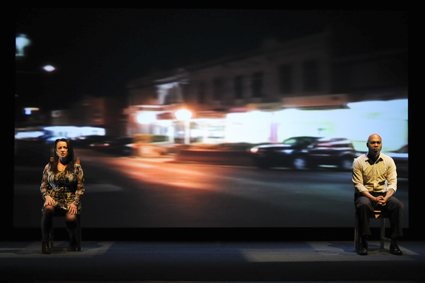
Yana Taylor, Irving Gregory, The Disappearances Project, version1.0
photo Heidrun Löhr
Yana Taylor, Irving Gregory, The Disappearances Project, version1.0
VERSION 1.0 HAS BEEN CREATING AMBITIOUS PERFORMANCE WORKS IN AUSTRALIA SINCE THE 1990S. THEIR LATEST, THE DISAPPEARANCES PROJECT, UNFURLS SLOWLY AND CAREFULLY AS IT INTERROGATES THE LOSS THAT REVERBERATES ACROSS SPACE AND TIME WHEN SOMEONE YOU LOVE DISAPPEARS. PERFORMERS IRVING GREGORY AND YANA TAYLOR TAKE THE AUDIENCE WITH THEM INTO THE TENSE AND SOMETIMES SHATTERING STATE OF MOURNING FOR THOSE WHO REMAIN UNCERTAINLY LOST.
In the company’s characteristic verbatim style, the performance includes excerpts from interviews conducted by version 1.0 with people who had experienced the loss of a loved one through disappearance. The performers share excerpts from stories they gleaned from these interviews, telling them as if they were their own. The authenticity of these narrative fragments in The Disappearances Project is both fascinating and painful to witness.
The first light of Yana Taylor and Sean Bacon’s video projection flickers across a large screen to Paul Prestipino’s emerging soundscape, laden with falling raindrops and trembling cascades of sound. The video, shot through the window of an endlessly, slow-moving vehicle, creates the sense of an exhaustive and inexorable search. Streetlights leak into a dawning cityscape to the incessant sound of dripping water. Rural and suburban streetscapes flitter onto the screen—their familiarity directly implicating viewers in the stories they will hear.
Yana Taylor and Irving Gregory’s miked voices emerge, disembodied—as if suspended in space—until their bodies are gradually illuminated by side lighting. For most of The Disappearances Project, the performers remain seated—upright, alert and tense on wooden chairs either side of the stage. Their near frozen stillness and the nervy soundscape charge the space with a sense of impending danger, tracing a plateau of quiet intensity which creeps to its peak when Taylor’s numbness begins to crack towards the end of the piece. The heaviness of the stories they tell visibly wears away at her, while Gregory maintains a veneer of relative calm.
The syncopated rhythm of the utterances is strung tightly across this ineffable space of mourning. Throughout, the performers’ alternating bursts of monologue bleed into each other’s stories, fragmenting them. Sometimes these stories enunciate glimmers of optimism, but always back-gridded by confusion and slowly building to existential explosions like, “It got to the point where I wanted to go missing, too.”
Taylor and Gregory do not perform fixed characters, but multiple embodiments from a range of experiences of loss. These float across the surfaces of the skin and the resonant timbres of their voices, a performative choice that neatly destabilises the potential for a linear performance structure and without leaning into didacticism. Sustained, disciplined stillness allows for this, as does the weaving of multiple stories into the performative fabric, without the performers embodying any singular identity. Perhaps Taylor and Irving explore a type of traumatised dis-embodiment, where they are rendered motionless due to the incomprehensible size and weight of such loss—a loss that always remains open, without closure.
The terrifying ambiguity of not-knowing displaces the missing persons’ loved ones. This nightmarish loss is always repeating itself in The Disappearances Project by perpetually asking, ‘What if?’ Taylor and Gregory articulate the varying registers of hope, denial, despair and anger that fill this non-place, for the most part with sensitivity and command.
The audience is encouraged to maintain a critical distance for the majority of the performance. At certain points, I wanted to be invited to ‘feel-with’ these stories of loss, rather than hover over them. This is the challenge of verbatim theatre that version 1.0 repeatedly faces with gusto: how can performance move an audience affectively, whilst also moving them to think critically about important social issues? The company managed this particularly well in The Bougainville Photoplay Project (2009-11).
Despite the successes of The Disappearances Project, I’m uncertain as to whether it met that challenge this time.
What The Disappearances Project highlights is a bureaucratic system predicated upon bodies that are fixed, stable and identifiable. The disappeared haunt the loved ones left behind who are punished further by bureaucracy’s inability to cope with the intricacies of human feeling. Where do loved ones of those who have disappeared go for help? Can our system accommodate and support complex human experiences? Whether or not verbatim theatre is an adequate mode for responding to such questions, at the heart of The Disappearances Project is an important plea to rethink the inadequacies of apparent democracy that fails when we need it most.
version 1.0, The Disappearances Project, concept, research, co-direction Yana Taylor, David Williams, devisers Irving Gregory, Paul Prestipino, Yana Taylor, David Williams, performers Irving Gregory, Yana Taylor, composer Paul Prestipino, lighting Frank Mainoo, film direction Yana Taylor, filmmaking collaborator Dan Jamieson, cinematographer, Sean Bacon, producer David Williams; Performance Space, CarriageWorks, Sydney, May 3-7
RealTime issue #103 June-July 2011 pg. 36
© Charlotte Farrell; for permission to reproduce apply to realtime@realtimearts.net
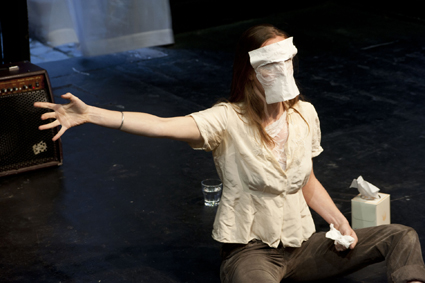
Brigid Jackson, This is—of the other
photo Nick Stephens
Brigid Jackson, This is—of the other
THIS IS—OF THE OTHER EXAMINES THE COLLABORATIVE RELATIONSHIP BETWEEN XX AND BRIGID JACKSON; THEIR FIREFLY-BRIGHT HOPES, SEPARATE SETBACKS AND THEIR ONSTAGE CHEMISTRY. AT ITS CORE IT IS A STUDY OF YOUNG ARTISTIC LIFE, OF THE DESIRE TO BE IN THE MENTAL AND PHYSICAL SPACE WHERE A CREATIVE SPARK IS IGNITED AND BURNS, THE ARTIST BECOMING A CONDUIT FOR SOMETHING ELECTRIC AND COMPELLING. WHAT TEARS PEOPLE AWAY FROM THIS PRODUCTIVE STATE IS THE STUFF THAT INFORMS ART—LIFE. DEATH LOOMS TOO, AS DO ILLNESS AND DISAPPOINTMENT.
X and Jackson have tackled autobiographical material using two complementary elements, touch and text. The words here range from prosaic to poetic, sometimes in the same monologue. Occasionally the performers seem to antagonise each other for real; spontaneous flashes of heat in their words raise questions about the proximity of real life to their art. Favouring performance based solely on movement, Jackson admits that hearing the first words come out of her mouth on stage is challenging.
The two young women who met at VCA in 2007 are tense and loose by turn, one earthy, one ethereal. The material in this performance, while broad in scope, has developed from their experiences of isolation. Jackson, the ethereal one, was at her mother’s side last year as she succumbed to cancer and then suffered a physical breakdown herself—”my scalp just let [my hair] go.”
Jackson’s grieving is conveyed powerfully and simply with a wet tissue placed over her face like a death mask then slowly inhaled into her mouth. On the floor, her ballerina-slim body raggedly convulses as it struggles to breathe through sobs. Remaining silent here, she avoids histrionics.
Bare-boned and intimate, the performance relies on few props—a radio, vacuum cleaner and tissue box—which relate to the shared living arrangement of the artists at one point. It was difficult not to feel a pang of empathy as Jackson expressed a desire for a baby to please her dying mother. X was in Paris at this time, directionless and lonely—reality in the city not living up to her artistic ambitions.
The stories overlap and run parallel to one another, the performers picking up loose pages from the floor, reading from their missives to each other unsystematically. X crawls close to the walls in the claustrophobic, blackened space at La Mama, scratching her arms against their surfaces in an act of frustration and restlessness. Unable to console each other adequately through written language, the dialogue turns to the platitudes that close their emails. Their unravelling is best conveyed physically. Jackson traces an operating vacuum cleaner nozzle across her skin in an act of seeming self-harm or procrastination.
Jackson and X push each other into new depths of their practice, both in the thoughts they share and their exploration of physical expression. There is a moody, ad lib quality to the piece as the duo builds a quiet, emotive landscape brick by brick, word by word.
This is—of the other, made & performed by XX and Brigid Jackson, La Mama, Melbourne, March 23-April 23
RealTime issue #103 June-July 2011 pg. 37
© Varia Karipoff; for permission to reproduce apply to realtime@realtimearts.net
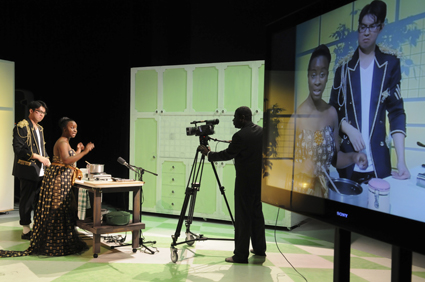
Alan Lao, Effie Nkrumah, Frank Mainoo, Ama and Chan, Urban Theatre Projects
photo Heidrun Löhr
Alan Lao, Effie Nkrumah, Frank Mainoo, Ama and Chan, Urban Theatre Projects
THAT “REALITY TELEVISION” IS AN OXYMORON IS FAIRLY COMMON KNOWLEDGE. FROM SURVIVOR AND BIG BROTHER TO MASTERCHEF AND THE AMAZING RACE, THE “REALITY” OF THE GENRE HAS ALWAYS TAKEN A BACKSEAT TO THE “TELEVISION” OF IT. THE TRUISM THAT OBSERVATION ALTERS THE THING OBSERVED IS TRUE ENOUGH OF CINEMA VERITE AND NATURE DOCUMENTARY, LET ALONE OF A PROGRAM THAT HOLES UP 16 OF SOCIETY’S MORE VACUOUS SPECIMENS IN A FORTRESS OF ARCHITECTURAL MODERNISM AND PLIES THEM WITH ALCOHOL FOR THREE MONTHS. IT IS DIFFICULT TO THINK OF RICHARD HATCH AS A MODERN DAY ROBINSON CRUSOE WHEN JEFF PROBST KEEPS ROCKING UP AT CAMP LOOKING LIKE THE ACTIVITIES MANAGER FROM A NEARBY SPA RESORT. AND EVERYONE KNOWS BY NOW THAT BY THE TIME THE JUDGES TASTE ANYTHING ON MASTERCHEF THE DISHES HAVE BEEN COLD FOR A GOOD 45 MINUTES AND THAT THE CONTESTANTS THEMSELVES RECEIVE SUB-PAR CATERING.
At least within this country, however, the least realistic thing about reality television is its colour: these programs have an insidious tendency to be a starchy, unrepresentative White. (To its credit, MasterChef has been somewhat more colourful than other programs—Chinese-Australian Adam Liaw won the competition in 2010, Malaysia-born Poh Ling Yeow came second the year before that, and Greek-Australian George Colambaris is one of the three judges—but even its line-up tends towards the starchy.) One can’t but recall Lee Lewis’s 2007 Platform Paper on cross-racial casting: “I had grown accustomed to New York’s mixed-race casts and was astonished that the ethnic diversity that was so apparent on the streets was not replicated on Sydney’s stages,” Lewis writes. Let’s hope she didn’t tune in to The Block or My Kitchen Rules.
It should come as no surprise that Urban Theatre Projects’ Ama and Chan takes this sorry state of affairs as its starting point. As Caroline Wake writes in her introduction to RealTime’s online archive of pieces on the company and its work: “Time and time again, Urban Theatre Projects has explored who becomes marginalised, how and why…Through their many productions we have come to know many modes of resilience: modest contingent, defiant, temporary, permanent and sometimes triumphant, but rarely in the way we expect.” Certainly, that is the case here. Where one might expect an angry, even militant, approach, Ama and Chan’s critique is instead subtle and good-humoured, worn on the sleeve of the production only lightly, as though it could, like lint, be brushed away without a second thought.
Indeed, if the production’s strategy could be summed up in a word, it would perhaps be “charm.” Performers Effie Nkrumah and Alan Lao have created, in the titular characters, two intensely and immediately likable protagonists. Ghanaian-Australian Ama and her bumbling Chinese-Australian husband Chan meet the audience in the foyer of the Bankstown Arts Centre prior to the show in a hilarious meet-and-greet that might be better described as an accost-and-berate. (Chan gives the vegetarians a particularly hard time.) They spurn political correctness. (Ama asks the row of Africans in the audience to smile. When she fails to see their teeth in the darkness, she frowns: “Hang on! That’s just a row of empty chairs!”) To a large extent, the characters hew pretty closely to stereotype. Chan’s Chinese-Australian accent is straight out of the fish markets and Ama’s entire persona reminiscent of blaxploitation’s sassy supermamas. When the piece reveals its interest in reality television, however, this reliance on types is revealed to have a very particular purpose: we quickly realise that these same types fall outside television’s prescribed and limited definition of social reality.
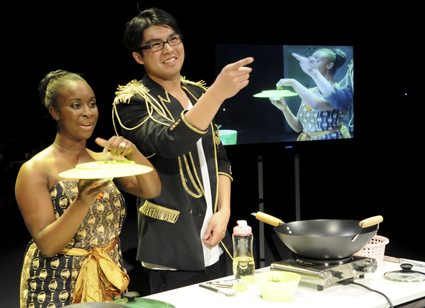
Effie Nkrumah, Alan Lao, Ama and Chan, Urban Theatre Projects
photo Heidrun Löhr
Effie Nkrumah, Alan Lao, Ama and Chan, Urban Theatre Projects
Drew Fairley’s production posits a unique solution to this problem: Ama and Chan take to the internet with a YouTube cooking show. (Within the context of the narrative, their reasons for doing so are less social than financial: the couple’s furniture has been lost by removalists on the day they are supposed to move into their new apartment. Chan hasn’t purchased insurance, one suspects characteristically.) Dedicated to “Ghanaian-Chinese fusion,” with the cuisines, like the character types themselves, given added depth and richness by their collision with one another, the couple’s show takes advantage of the digital sphere and its much-touted capacity for breaking down cultural barriers and opening up more inclusive and representative spaces.
A Catfish-esque montage of images from Google Maps, iPhone text messages and online airline booking sites opens the production, serving as its prologue and providing us with the characters’ back stories. The networked world also played an important role in the production’s marketing strategy, with audiences invited to befriend Ama and Chan on Facebook and follow the latter’s hilarious videoblog in the lead-up to the season.
With the Arab Spring still in full swing as this issue goes to press and with the importance, if not necessarily the centrality, of these same technologies to those struggles, the exploration of their capacity for creating new spaces here at home seems timely. Ama and Chan’s mode of resilience, too, is a digital one.
Urban Theatre Projects, Ama and Chan, director, writer Drew Fairley, devisors, performers, writers Effie Nkrumah, Alan Lao, dramaturg Alicia Talbot, musician, performer Reza Achman, Bankstown Arts Centre Theatre, Sydney, May 4-14
RealTime issue #103 June-July 2011 pg. 38
© Matthew Clayfield; for permission to reproduce apply to realtime@realtimearts.net
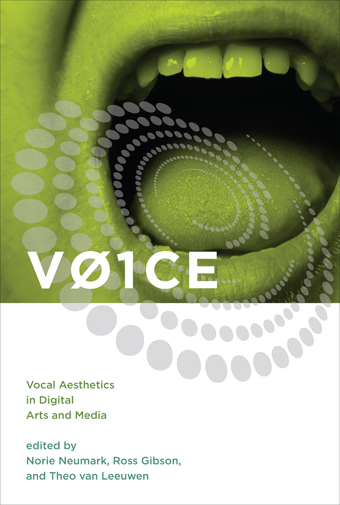
VOICE: vocal aesthetics in digital arts and media
IS IT SACRILEGIOUS TO ADMIT THAT I’M UNDERWHELMED BY ROLAND BARTHES’ CLASSIC ESSAY “THE GRAIN OF THE VOICE”? BEYOND THE TITULAR CONCEPT THAT THE VOICE CONTAINS THE ESSENCE OF ITS PRODUCING BODY, “THE GRAIN,” THE ESSAY REVEALS LITTLE ABOUT THE RAW VOICE ITSELF, CONCENTRATING MORE ON BARTHES’ OPINIONS ABOUT CLASSICAL MUSIC.
While Barthes’ “grain” is well-referenced in VOICE: vocal aesthetics in digital arts and media, edited by Norie Neumark, Ross Gibson and Theo van Leeuwen, the 19 essays gathered here prove much more satisfying. The book offers multiple analyses of the voice in concert with and beyond language, with a focus on the mediated voice and its relationship with technologies and modes of contemporary art production.
The book is divided into four areas that essentially lead us from the gadgets of the past to propositions for the future. The first section, “Capturing Voice,” explores technologies by which the voice has been synthesised, recorded, stored and transmitted. Theo van Leeuwen looks at instrumental emulations of the voice, starting with pipe organs and ending with the synthesised samples found on his Roland RD300-SX, discussed within the framework of authenticity and modality theory. Thomas Y Levin conducts a whirlwind tour of the history of voicemail revealing a range of fascinating early inventions and proposing that the recorded/transmitted voice is a form of writing.
Virginia Madsen and John Potts look at the extension of temporally dependent radio into the realm of on-demand voice casting, exploring amateurism and audio blogging along with Brecht’s idea of radio as a two-sided exchange. Martin Thomas’ chapter on archiving Aboriginal languages is particularly fascinating with its analysis of the use of language in Rolf de Heer’s Ten Canoes and the possibilities that digital technology offers for communities to archive themselves.
Part two, “Performing Voice,” groups together essays that explore the voice in action across a range of artworks that can loosely be defined as ‘performed.’ A particular highlight is Brandon LaBelle’s complex analysis of sound poetry perhaps because it most directly addresses the paradoxes inherent in vocalisation. LaBelle states that in “attempting to free orality from the constraints of linguistic meaning, sound poetry edges against tensions inherent in subjectivity…sound poetry yearns for language by rupturing the very coherence of it.” He also identifies the tension in sound poetry between the desire to embrace technology and the pursuit of a raw, primal voicing with examples from artists such as Henri Chopin, William Burroughs and François Dufrêne. He concludes with the proposition that as we now live in the realm of the digital, the modernist project involving the fragmentation of the subject has been replaced by a networked and “distributed sense of subjectivity.”
Amanda Stewart’s artist statement follows on aptly from LaBelle as she describes her explorations into “the materiality of language itself.” Tracing her trajectory from poet-on-the-page to performing vocal artist via radio production, Stewart offers an astute analysis of the role of technology in her practice, both analogue and digital. Meredith Morse’s exploration of the voice in the works of choreographers Yvonne Rainer and Simone Forti is also a fascinating read, exploring how their voices ruptured the perceived sacredness of the silent dancing body. While she suggests these artists’ explorations anticipated digital approaches, the overall analogue preoccupation of the chapter makes this essay feel slightly tangential to the overall framework of the book.
The third section, “Reanimating Voice,” offers the most practice-oriented chapters, focussing on many illuminating examples of the voice and its manipulation in screen media. The highlight here is the chapter on filmic voices by academic Helen Macallan and sound designer Andrew Plain. Plain’s real world perspective mixed with Macallan’s informed analysis offers many insights into the effect digital processes are having on voice in film, particularly regarding the hierarchy of voice to sounds within a score and the importance of spatialisation given the renewed excitement about 3D cinema.
Mark Ward and Axel Stockburger’s chapters on the voice in video and computer games cross over considerably. Stockburger offers a more academic overview with an emphasis on the role of the user’s voice in the game, while Ward presents an in-depth analysis of sound design in the game BioShock. As with Macallan and Plain’s chapter, it is particularly insightful due to its inclusion of detailed statements by the game’s Audio Lead (head sound designer) Emily Ridgway.
The concluding section, “At the Human Limits of Voice,” starts with a poetic exploration by anthropologist Michael Taussig addressing the spiritual nature of humming, using examples ranging from Winnie the Pooh to the Iroquois people and ending with an excerpt from the Chicago 7 trial involving Allen Ginsberg. The thrust of his argument is that “humming is central to language, as a base state of the voice, humming being neither conscious nor unconscious, neither singing nor saying, but rather sound where the moving mind meets the moving body.”
Nermin Saybasili continues the spiritual exploration in her analysis of a range of media artworks addressing migrant experience in Europe, arguing that the displaced and disembodied migrant voice is essentially a haunting, occupying a liminal space which is in fact inseparable “from the social body.”
The book concludes with a chapter by Philip Brophy exploring how “the human voice readily becomes its other through vocalisation,” using examples of songs by popular artists including Michael Jackson, Cornelius, Yoko Ono and Scott Walker, as well as Luciano Berio. Interestingly this and another chapter by Ross Gibson on the pre-digital nature of King Tubby’s dub, including a quick summary of modern vocal production techniques, are the only chapters that deal with music as such. This ensures that the book is not swamped by multifarious discourses on popular music, allowing alternative voices about voice to be heard.
It is this range of approaches and the presence of multiple stylistic voices that makes this book so enjoyable. I particularly appreciated the inclusion of more personal writing from the likes of Amanda Stewart and Theresa M Senft. The latter’s autobiographical account of her adventures—with telephone sex chat lines, self-help cancer tapes, computer voice recognition and Alvin Lucier’s I am sitting in a room—is both informative and moving. The whirlwind smash-and-grab poetics of Mark Amerika also makes for a provocative read.
Norie Neumark frames VOICE: vocal aesthetics in digital arts and media with an introduction offering a range of theoretical approaches to the paradox of vocality which many of the individual chapters expand upon, providing the book with a strong academic underpinning. However for me it is inclusion of real life applications and statements from practising artists interwoven with theoretical analysis and provocation that make this book a pleasurable, accessible and edifying read.
VOICE: vocal aesthetics in digital arts and media, editors Norie Neumark, Ross Gibson and Theo van Leeuwen, MIT Press, Cambridge Massachusetts, London, 2010
RealTime issue #103 June-July 2011 pg. 39
© Gail Priest; for permission to reproduce apply to realtime@realtimearts.net
“PEACOCKS ARE VAIN AND STUPID,” CONDUCTOR SIMON CHARLES EXPLAINED. “AT MONTSALVAT ONE KEPT ON COMING INTO THE GREAT HALL AND STARING AT HIMSELF IN THE MIRROR.” THE RECENT PERFORMANCE, FEATURING FOUR PIECES COMPOSED DURING CHARLES’ RESIDENCY AT THE VICTORIAN ARTIST COLONY, WAS UNDERSCORED BY A LESSON FROM THE PEACOCK: YOU CAN MAKE SERIOUS MUSIC, BUT YOU ALSO HAVE TO MAKE FUN OF YOURSELF. THIS DID NOT MEAN THAT THE ENSEMBLE, FEATURING AVIVA ENDEAN ON CLARINETS, MATTHEW HORSLEY ON PERCUSSION, KIM TAN ON FLUTES AND RYAN WILLIAMS ON RECORDERS, SHIED AWAY FROM FULL-BLOODED ‘SERIOUS’ MUSIC, TO WHICH THE FIRST HALF OF THE CONCERT WAS DEDICATED.
Tan opened the concert by sending Toru Takemitsu’s “Air” darting about the lofty spaces of Richmond Uniting Church. The solo flute meditation on air in and outside the body requires the performer to turn breath into wind, imitating a gust one minute and a gale the next. Maintaining intonation and rhythmic precision amidst the composition’s swelling melodic zephyrs, Tan delivered the impossibility of controlled abandon.
“Air” set the impressionist tone for the rest of the first half, sitting comfortably alongside the light tone colour of Charles’ “White Simplex” for bass recorder, bass clarinet and percussion. The overblown, underblown and plosive attacks on the deep instruments sounded as though you were wandering past a drain pipe and heard, far below, some peculiar machines having a secret conversation.
The machines were brought to light for Charles’ percussion piece “Matcham’s Junk.” Charles carves, or threads, a delicate miniature from the barely perceptible sounds of springs, tiny stones and grating pipes, fittingly sourced from the backyard collection of the late jeweller, sculptor and former resident of Montsalvat, Matcham Skipper.
Open ocean provided the program for Liza Lim’s solo clarinet work “Sonorous Body” inspired by the text from her opera The Navigator: “Horizon and water/ Could never be lovers/ Horizon adores only distance/ Sonorous water/ Searching for its sonorous body.”
Lim paints a horizon of undulating microtonal lines, broken only by key clatter and pops and slaps like water on the side of a boat. Endean on clarinet gave expression to the horizon’s infinite desire for distance through her fearsome dynamic range, from the piece’s ear-splitting climax to the barely audible, bubbling double trills at its conclusion.
The second half of the program featured theatrical works that tested the peacock’s composure with both humour and challenging political themes. Matthew Horsely’s “Murdering Creek Rd” was inspired by the composer’s night time visit to the scene of a premeditated massacre of Indigenous Gubbi Gubbi people by white cattlemen in the 1860s. In the first movement the performers call forth chaotic screams from their instruments before breaking into fragments of Australian folk song. Manically waving a lagerphone, Horsely may be conjuring a lawless, unstable, early colonial Australia. He may also be making a humbling parody of contemporary music in the face of an issue that it can only address with difficulty. The second movement asks, “whether the ghosts can be appeased and the land made whole again.” This time, Horsely draws from the Pentecostal musical tradition of New York saxophonist Albert Ayler, with a nod to an account of the massacre that suggests it occurred immediately after a church service. The work does not attempt to answer conflicts arising from its engagement with the historical moment, with Horsely conceding that, “the only answer we receive is the percussive equivocation of the pobblebonk frogs.”
Horsley’s rendition of Greek born French composer Georges Aperghis’ “Le Corps à Corps” saw the solo percussionist careening around the church on an office chair. Horsley played a commentator, narrating the car-cum-chariot race at breakneck speed while accompanying himself on a Persian zarb.
The concert concluded with Charles’ “LOL On My Face,” featuring the disturbing juxtaposition of a dirge-like canon exercise played on alto flute, bass recorder, clarinet and crotales and a vocalist retching and croaking “Shut up, Shut the fuck up!” Humorous, yes, but also strangely beautiful. Providing experiences from sublime to ridiculous, Plight of the Peacock both strutted and laughed with pride.
Plight of the Peacock, conductor Simon Charles, clarinets Aviva Endean, percussion Matthew Horsley, flutes Kim Tan, recorders Ryan Williams, Richmond Uniting Church, Melbourne, May 6
RealTime issue #103 June-July 2011 pg. 39
© Matthew Lorenzon; for permission to reproduce apply to realtime@realtimearts.net
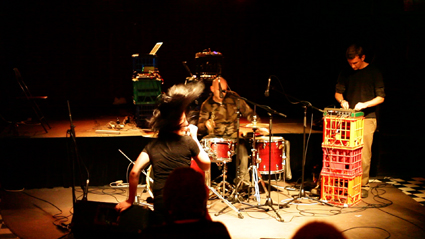
Kusum Normoyle, Sean Baxter, Peter Blamey, High Reflections
video still courtesy Kusum Normoyle
Kusum Normoyle, Sean Baxter, Peter Blamey, High Reflections
THE BEGINNING OF THE MILLENNIUM WAS A GOOD TIME FOR EXPERIMENTAL MUSIC AND AUDIO ARTS IN SYDNEY WITH SEVERAL REGULAR EVENTS SUCH AS IMPERMANENT.AUDIO, DISORIENTATION, IF YOU LIKE IMPROVISED MUSIC WE LIKE YOU (AKA THE NOW NOW), ¼ INCH AND SOUNDNOSOUND TAKING PLACE IN A RANGE OF INTRIGUING ARTIST-RUN (ILLEGAL) VENUES LIKE SPACE 3, LAN FRANCHI’S MEMORIAL DISCOTHEQUE AND HIBERNIAN HOUSE. THERE WAS A REAL SENSE OF COMMUNITY AND MOMENTUM GUIDED BY SOME EMERGING CURATORS AND FUELLED BY YOUNGER ARTISTS COMING THROUGH TERTIARY INSTITUTIONS SUCH AS THE UNIVERSITY OF WESTERN SYDNEY AND UTS.
By around 2006 things were dying down: venues were scarce, event organisers became tired and/or got real jobs and the media arts bubble burst, taking with it the more audio focused university courses. But maybe this was the pause that refreshes because in 2011, along with a few of the older events that continue, there is another batch of regular gigs with new performers and new audiences. Over the next editions I will survey some of these, exploring their particular flavours (and flaws) and discovering ways in which artists are currently reshaping our expectations of music.
the silent hour
The Silent Hour is the latest addition to the experimental music scene, starting in January 2011. It is run through The General Store Gallery, William Street in Kings Cross, under the guidance of Ben Galvin with occasional guest curators. The shows are irregular but can occur up to twice a month and the programming so far shops across a range of styles from improv, audiovisual, pop inflected electronica and a hint of noisier stuff, with no sense of a rigid agenda.
A small but loving audience attended Session IV featuring three acts. Hinterlandt (Jochen Gutsch, from Germany now residing in Sydney) presented a jam-packed set on keyboard, trumpet, guitar, samples and vocals. He moves effortlessly through a lot of material and after 30 minutes it begins to feel overloaded, but it’s well-produced electro pop with complicated structures and warped edges. Scissor Lock (Marcus Whale) is a man about town, performing regularly at many of these series. His luscious rafts of sound made from layers of static and mangled voice form into sweet and abrasive crescendos that seem at once familiar yet unique.
Visiting German artist Max Neupert closed the night with a live data and video link up with THE! —Tommy Neuwirth, Clemens Wegener—in different locations in Germany. Writing only code they played a collaborative piece of shifting beats and bleeps that was complex and playful, making the most of the limited midi sound palette. In the following weeks Neupert also presented Satellite Zodiac, a gallery installation mapping the realtime data of satellites across our night skies with moving laser pointers. This forms part of an intriguing body of work concerned with modern astronomy.
While the rhetoric around The Silent Hour is somewhat overwrought and the title curious given the events are neither silent nor an hour in length, the intimate space, openness of curation and the enthusiasm of Ben Galvin make this series worth investigating.
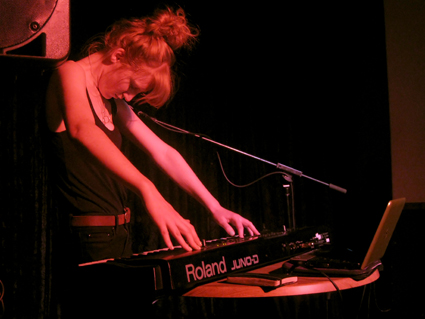
Daisy Buchanan, Ladyz in Noyze, Adelaide
photo Spoz
Daisy Buchanan, Ladyz in Noyze, Adelaide
ladyz in noyz
Predominantly a Melbourne activity run by Lara Soulio, this was a tour to promote the CD compilation of the same name, with gigs in Melbourne, Sydney, Adelaide and Newcastle (Soulio is extending the work of Marlo Eggplant’s US compilations through Corpus Callosum). While there has been reluctance in the past few years (in Sydney at least) to create separate women’s sound events, it feels as though Ladyz in Noyz has a celebratory, non-righteous agenda that releases it from concerns about ghettoisation. The ladyz vibe was nicely reinforced by the venue, The Red Rattler in Marrickville, a fully legal artist-run theatre established by a collective of women in 2009, which has been a godsend to the alternative performing arts.
Refreshingly, there were four acts from out of town that I hadn’t heard before. Rites Wild (Adelaide) presented a set of songs made from big dirty synth sounds, pared back drumming (by a male) and distorted war chant vocals creating a Nico-esque dirge. Daisy Buchanan (Melbourne) on keyboard offered blizzards of shredded descending tones and dark, folky vocals, heavy on apocalyptic atmosphere. I particularly enjoyed Oranj Punjabi (Melbourne) who used a tabletop full of pedals and electrical boxes, setting up drones by singing into an electro-hacked tin can, her metallic thumps and big delays reminiscent of early industrial music. Finally Festive Jackals (Lismore/Melbourne) sculpted vocal utterances into thick layers of buzzy fuzz, their delayed shouts escalating into a nightmare soundscape that might have pleased Dante.
While each of these artists had their own methodologies, there were strong similarities in their dirty fuzz, bassy drones, submerged vocals and sudden stops. Onnie Art (Melbourne) offered a slightly different approach working with voice, electronics and objects (a tape measure flicked savagely) creating a more chaotic, comic performance. Kusum Normoyle (Sydney) gave us the most physical and brutal set, her screaming and feedback assault deftly crafted to form a thick but detailed noisescape. Normoyle aside (her signature is brevity), I was surprised that all sets barely topped 15 minutes. While particularly sensitive to artists overstaying their welcome I couldn’t shake the feeling that these ladyz should boldly demand more of our time.
While not yet a regular Sydney event, Ladyz in Noyz is certainly an interesting addition to the sound landscape. Lara Soulio has plans to make it happen here again, hopefully with more local involvement.
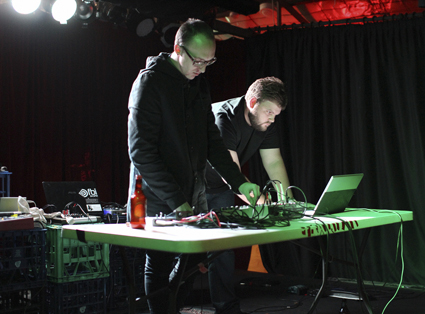
Machine Death
photo Paul Marshall
Machine Death
high reflections
It could be argued that High Reflections kicked off the resurgence of sound activity in 2009. Caleb Kelly, curator of previous activities such as the seminal impermanent.audio and Pelt Gallery teamed up with Alex White who moved straight from running Electrofringe (2007-08) to take on Serial Space, the venue originally founded by Tameka Carter and Louise Dibben in 2008 that can also be credited with keeping the lights on through the dark times. Taking place monthly on a Saturday night it offered a more upbeat but no less edgy side of experimental music, drawing in elements from more alt-pop genres like metal, no-wave, freak-folk and psychedelia.
I use the past tense as the curators have decided to wrap it up with the final two nights taking place at The Red Rattler: a mini-festival presenting 17 artists, many in new combinations. One particularly successful pairing featured Jon Hunter and Nonemusic (Nic de Jong from Naked on the Vague) playing a sustained guitar epiphany. For the majority of the piece Nonemusic focused on a detuned arpeggio loaded with delay to create an ever-evolving sea of notes. Hunter exacted astounding sounds from his guitar—bubbling water, banshee howling and a truly bone-chilling wooden creaking like a ship in the process of breaking up. The cohesion between the two loosened as it morphed into a kind of broken pop song, but overall we witnessed a dynamic meeting of minds and guitars.
The second evening offered some magic sets. Long time favourites who perform rarely, Machine Death work with dirty minimalist pulses that build by infinitesimal layers, like intricate Japanese lacquer work, to enormous noise. If they’d pushed the volume just a little more in the latter tracks, we just might have reached that higher plain.
Sean Baxter on drums, Kusum Normoyle on voice and Peter Blamey on electronic emissions offered some hardcore extreme clamour. Normoyle prowls the stage, howling and triggering feedback that wraps around Blamey’s deep, electronic eructations, with all the spaces filled by Baxter’s metal pipes clattering over his drumkit: loud, dense and bracing.
However the real highlight was the psychological terror induced by Thembi Soddell’s performance. With the lights turned off and a request for quiet (even the rattling fridges were silenced), Soddell, hidden from view, created an amazingly evocative soundscape of unspecified but terrifying dread coming towards us slowly from a distance. An intensifying rumble augmented by half-human, half-animal shrieks reaches its zenith and then sucks back down, vacuum-like, to a ringing almost-silence, only to begin again. With a fine balance between augmented field recording and machine noise Soddell perfectly controls this exhilarating journey into her unconscious—or is it our own?
The final night of High Reflections was a fitting roundup of two years of diverse and adventurous programming and it is sad to see the end of another era. But as this current resurgence of gigs evidences, it’s all part of a greater cycle—there’s more to come.
Next up I’ll report on visits to Sound Series and 1/4 inch.
The Silent Hour, curator Ben Galvin, The General Store, March 31, www.the-generalstore.net/The_SIlent_Hour.html; Ladyz in Noyz —Sydney, curator Lara Soulio, The Red Rattler, April 10; High Reflections, curators Caleb Kelly, Alex White, The Red Rattler, Sydney, May 25-26, www.highreflections.org/
RealTime issue #103 June-July 2011 pg. 40
© Gail Priest; for permission to reproduce apply to realtime@realtimearts.net
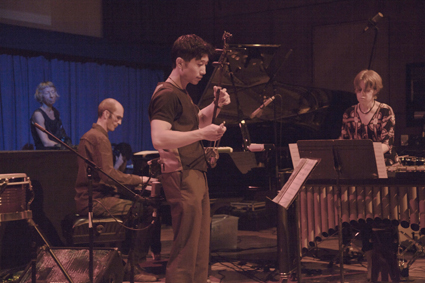
Janet Baker-Finch, Erik Griswold, Nicholas Ng, Vanessa Tomlinson
photo Sharka Bosakova
Janet Baker-Finch, Erik Griswold, Nicholas Ng, Vanessa Tomlinson
IT’S CLOCKED OUT DUO’S SEASON OPENER AT QLD CON’S RECITAL HALL. NICE SIZED CROWD, NICE PRE CONCERT BUZZ. STAGE SET-UP IS A COUPLE OF PIANOS, PERCUSSION, VIBES, BIG DRUMS. UP THE BACK, HIGH OVER A TALLISH THIN PLATFORM, HANGS A WIRE BASKET AND A LARGE CIRCULAR CONE, POINTY SIDE DOWN. ERIK GRISWOLD INTROS THE PROGRAM (SEVEN PIECES IN 60 MINS), THANKS THE GUESTS, USES THE ‘EXPERIMENTAL’ WORD. TELLS US THE WIRE BASKET AT THE BACK HOLDS ICE THAT WE WILL HEAR MELTING ONTO STUFF LATER—I MUST ADMIT I DID NOT NOTICE IT AGAIN OTHER THAN TO WONDER FROM TIME TO TIME IF I SHOULD BE NOTICING IT.
Clocks tick away (tonight’s theme) and the concert starts with Wake Up!—a sort of programmatic journey across the sleep cycle. Percussive tic-tocs and prepared piano chimes move into fast rolls on skins, then a long middle section of hits on wood like a bunch of clocks ticking to their own individual time frames. Tube cut metal bells tinkle out a lullaby against sparse piano before waking to a strangely funkless swamp groove.
Now that everyone is awake it’s onto breakfast with two guests—Lawrence English and Janet Baker-Finch—and Tomlinson playing what could be cereal bowls. Tomlinson is doing percussion-as-Foley and even though it is really nice to hear the different sounds and consider the transitions from beats to clicks to noise to tones as one clicks and taps and scrunches ever faster, things get a bit formless. I invoke audience privilege and blame the performers for my wandering attention rather than thinking it is my fault for not understanding what is going on. But…in come some seagull sounds via English’s field recordings and that gives the whole thing a bit of retrospective sense. The dynamics of the previous section anticipated the seagulls. They have taken the formless and unpredictable and retrospectively predicated it on familiar nature. This is a great touch as so much of listening is about forward prediction and this piece reverses that default. Instead of modulating prediction to give meaning through elements of musical surprise and familiarity we get storytelling and memory to make sense of the past. Then again, as Griswold starts rolling a ping pong ball on the strings of a zither and yet another instrument gets its time in the sun, I wonder if perhaps I’m reading a bit too much into it. Then the seagulls disappear and cycles of soft ocean waves fade in to gently underpin the form with another scale of repetition.
A few shorter pieces follow. Griswold sings what sounds like a Chinese street vendor’s call to Nicholas Ng’s accompaniment on erhu. Fast atonal bits and pieces come in on percussion and piano then it all syncs together through a majestic chordal sequence before more traditional tune, riffy piano and vibes. Like an update to mid 70s jazz fusion a la Jean-Luc Ponty.
The guest spot with Joel Stern introduces old school electronic FX—squealy pig snorts, booming bass drums. The interplay between the performers is excellent; they seem to be really listening and adapting to each other. Switching on and off, back and forth, bursts of noise then a quick stop tight with the drums–like stadium rock gods trading ever-harder solos as a contest in status updates.
The final piece is Spill Redux with Baker-Finch, a re-working of the earlier Spill [www.clockedout.org/projects/dsfpercussion.html]. Here we discover the purpose of the hollow inverted cone suspended at the back. It is filled with rice and swung as a pendulum, rice slowly leaking from the bottom. The rice spills onto a variety of surfaces, such as bowls and paper, to make gentle bursts of percussive noise. Using a leaking pendulum to drive a rhythmic pulse is a beautiful idea, as the period of a pendulum’s swing remains constant even as the arc of the swing gets shorter. Another link to clocks.
Baker Finch moves in and out of the arc of the pendulum’s swing. She wears a garbage bag dress, outsized castanets on her fingers, metal kitchenware on her limbs. She drags her foot through the spilled rice to make sound, slow and hypnotic, then reaches into the falling stream of rice, making washes of sound that hint back to the earlier field recordings of ocean waves. The rice runs out and the evening finishes on church bells and a call to prayer. The weekly rituals. Awake and asleep. Waves and the ocean tides.
Wake Up! Clocked Out Duo (Erik Griswold, Vanessa Tomlinson) with Janet Baker-Finch, Lawrence English, Nicholas Ng, Joel Stern, Queensland Conservatorium, Brisbane, March 23
RealTime issue #103 June-July 2011 pg. 41
© Greg Hooper; for permission to reproduce apply to realtime@realtimearts.net
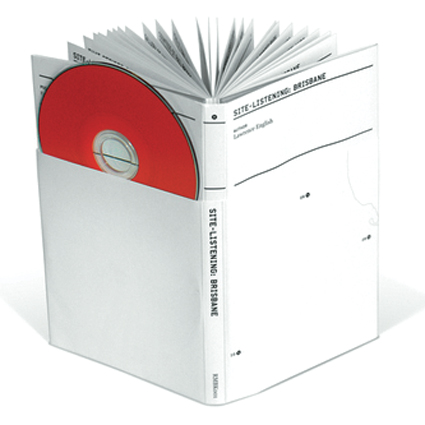
ite-Listening: Brisbane, Guidebook and 3” CD, Room 40
LAWRENCE ENGLISH WANTS US TO EXPAND OUR PERCEPTION. HE DOESN’T JUST WANT US TO PAY MORE ATTENTION TO SOUND, BUT TO PREFERENCE OUR EARS IN OUR SENSORY ENGAGEMENT WITH PLACE. THIS IS HARDER THAN IT SOUNDS. FOR ONE, OURS IS INCREASINGLY A VISUAL WORLD, FORMED, LIVED AND KNOWN THROUGH TEXT AND IMAGE. SECONDLY, OUR EARS HEAR CEASELESSLY, BUT OUR BRAINS ARE TRAINED TO PROTECT US, APPLYING ‘NEUROLOGICAL COTTON WOOL’ THAT FILTERS AND PROTECTS US FROM THE SHEER MASS OF AUDITORY INFORMATION WE ENCOUNTER IN EVERYDAY LIFE.
This idea is not a new one, as audiophiles know—the concepts of acoustic ecology and the human mediation of the environment through sound have been around for 50 years or more. English himself has extensively promoted the idea of careful listening to spaces to cultivate a sense of sonic aesthetics through phonography in some of the world’s wildest places. His latest intervention is in many ways the natural next step for the project he terms site-listening—a handbook to guide the listener to experience and apprehend the sounds of various locations in and around South-East Queensland.
Site Listening: Brisbane invites us to offset our ordinary ocular-centrism in a guided tour of some 17 natural and manmade sites within the Greater Brisbane region. The book includes discussions of the act of listening in Brisbane, opening with a short essay by English outlining the project and closing with essays by Nick Earls and David Toop. The quintessential Brisbanite, Earls emphasises sound’s snapshot function, pointing out how some of the most familiar and pervasive sounds in our day-to-day life—the beep of a reversing truck or the click of a resident gecko (“40 to a house on average”)—haven’t always been here but rather, over the last two decades or so, have insinuated themselves into the normal sound of living here. Though he also considers sound’s transience, Toop provides an insight on the “bizarre, totally unfamiliar sounds” the city serves up to an outsider. One of his most memorable descriptions is of the evening roost of squabbling flying foxes, “hung messily from the trees as if a cargo of broken black umbrellas had been dumped from a plane flying overhead” and sounding like “a large man wallowing in a bathtub filled with squeaky rubber ducks.”
The sites we are guided to in the book are precisely noted with a colour image, map and GPS co-ordinates and a short description of the possible sounds the listener may hear unfolding at different times of day. The guide covers the city’s orifices: its airport, port, marina, railway and other major organs, like the football stadium and Gallery of Modern Art. The city’s lungs are also included in the form of inner- and outer-city parklands, matchless wetlands and state forests. Throughout the book, English’s highly attuned sonic sensibilities—both legacy and matrix of his field recording practice—result in fine-grained textual description of the sound-making structures and bioacoustics in each site. While the guide’s locations, and numerous others, are listed on the project’s website—part of English’s ongoing and expanding mission to psycho-acoustically map Queensland—this little book is an important publication. An attractive object, its cover cleverly folding out to display an A4-sized map of the locations, it is only just bigger than an audiotape, making it the perfect size for a pocket when not being consulted on location.
Some Brisbanites may feel a little conflicted about the choice of locations. On the one hand, there is a particular thrill in revisiting a familiar location, such as the heritage-listed Highgate Hill lookout on the knoll of Dornoch Terrace, a popular spot during visually spectacular events such as fireworks and eclipses. The site-listening approach suggests “recommended time: late night.” On the other hand, natural locations are incontrovertibly special sites, such as the Tinchi Tamba tidal wetlands teeming with life-giving mangroves. Many, if not most, are (largely) protected by state legislation, or at least widely acknowledged for their cultural and environmental value. In a fast-growing region there are other sites around this city that, though not yet recognised or protected, are just as important—”spaces where life occurs,” to use Christian Norberg-Schultz’s famous phrase.
While it’s great to see mention of local, unofficial landmarks such as the Griffin Park bat colony, there is a rare opportunity here for advocacy on behalf of numerous other significant sites threatened by the city’s insatiable hunger for space. Inner-city bushland, dwindling koala habitats and historic architecture critically endangered by ‘sustainable development’ in a rapidly disappearing Brisbane come to mind. Their non-inclusion means that the book centres on mainly known locations, and has longevity—it will still be relevant long after endangered places are developed. Then again, being mentioned in a book like this could prove very pertinent to ongoing efforts to preserve and retain these spaces. Considering the locations that are included, it’s worth remembering that legislation can always be changed, and that even those places currently designated as reserves are only a planning decision away from permanent disappearance.
English mentions this constant flux, and in many ways this book’s quiet insistence that we spend our time not just passing through or looking at, but paying real attention to ‘place’ acts as an implicit assertion of the public value of these and other shared landscapes. To visit the geographies mapped in this guide is to realise how readily the process of privileging sound reveals details the eye can overlook, and how much the ‘spirit’ of a place emerges from interactions between the environment and the human sensorium. The quiet act of dwelling intentionally in these locations generates an awareness of the small and meaningful within the infinite and the everyday. As Toop puts it, when we really listen to sites, what we hear, when we realise we are “just one moving point in a distinctive web of resonances, atmospheres, pressure waves, echoes, signals and silence,” is our place within them. This may be the most valuable guidance of all: that landscape is not just something we behold with our senses, but something to which we are also beholden.
Lawrence English, Site-Listening: Brisbane, Guidebook and 3” CD, publisher Room40, catalogue no. RMBK001, design ORDNER, Ralph Steinbrüchel, sponsor Queensland Music Festival; http://sitelistening.com/; http://room40.org/store/lawrence-english-site-listening
RealTime issue #103 June-July 2011 pg. 42
© Danni Zuvela; for permission to reproduce apply to realtime@realtimearts.net
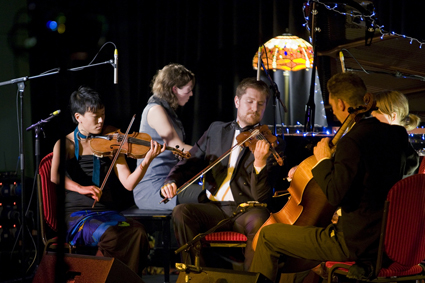
Sunwrae String Quintet
photo courtesy of the artists
Sunwrae String Quintet
THERE WAS THE SMELL OF PEPPER CHAI AND DAMP JACKETS AT COLBOURNE AVENUE FOR SUNWRAE’S SYDNEY LEG OF THE EAVESDROPPING TOUR. COSY SOFAS AND RED WINE MADE US AT HOME WHILE ICONIC WONKY LAMPS LIT THE PLAYERS OF SUNWRAE QUINTET. USUALLY A NINE-PIECE, SUNWRAE ENSEMBLE IS A PREMIER NU-CHAMBER GROUP THAT BLENDS MELODIC PHRASES AND INTERWEAVING RHYTHMS, CREATING FLOWING MUSIC WITH FAR REACHING APPEAL. ARTISTIC DIRECTOR AND TRIPLE-THREAT PIANIST, PERCUSSIONIST AND COMPOSER RAE HOWELL LEADS THE GROUP FROM THE PIANO WITH PASSION.
Howell’s compositions are explorations of texture, where melodies arise from group-created shapes. Even when a solo tune is clear it’s the harmony that’s in focus. Howell’s music is often described as cinematic and is charged with emotion and potential for imagery. Her sound flaunts a complex understanding of classical music but is delivered with the natural simplicity of popular music. If her lilting ostinati don’t hypnotise you at first, her engrossed head bobbings will.
Minus an alto flute, vibraphone, harp, double bass and percussion, Sunwrae Quintet was destined for reduced sound, but the Sydney performance suffered from other factors. Playing their guts out, the musicians’ energy was greater than the sound they impelled. The great little venue in Glebe did not do any acoustic favours for the non-amplified group. Fuzzy, directionless sound forced intimacy as the slouchy-couched audience leaned in to hear, but left a strange feeling of communal deafness. Is it possible for a room to suck so much sound away?
The most characterful piece of the night, “Mmm, Good Question,” let Sunwrae fool around with vaudevillian snippets lifted from every cliché you’ve known and loved. Creepy clown, scratches from the grave, a gate that needs oiling, those screeching trills near the bridge of a violin that elicit a physical reaction: your skin crawls with the memory of that pesky kid from school who clawed the chalkboard. The quintet’s answer to the fairground zombie vampire apocalypse craze is yet a spacious music that makes a listener hear the sounds of the room. It breeds hyper-awareness as it slinks into a warped corpse-bride’s tango, then deflates as the strings put on the shifty eyes—left right, left right—removing any doubt that this music is comedy, before returning to the fair.
Two world premieres were received well but didn’t jump out of the program. The best performances were of tried and tested hits like “Autumn Never Fall,” where Sculthorpe seagulls flew by (a technique on cello popularised by Peter Sculthorpe where harmonics in close succession sound like flying sea rats). We were given further license to imagine with “Far Away Castle” (soundtrack to a children’s film) as its Chinese-fantasy-esque love theme emerged. Rachel Kim on first violin realised key themes while second violinist Zac Johnston danced in his chair. The stoic bass section, viola player Phoebe Green and cellist Tim Blake, gave nuanced performances that made up for occasional blips in the upper parts. The most exciting offering of the evening was “The Machine,” a favourite piece that might have had a love affair with a Tenori-On, or this digital version at http://mandaflewaway.tumblr.com/post/2057242738
Chugging, cogs chipping, driving pistons, “The Machine” grinds away. Spurts of sound are left behind as the music reproduces conditions for further outputs. This machine seems to borrow its climaxes from the choral works of Stanford or Herbert Howells, only to disjoint them, cut them short, move on. Containing many complete musical ideas, like a mash up of distinct quotations, the work’s cogs really shouldn’t engage with such cohesion, but do. “The Machine” manufactures landscapes for the listener, ones that pan in and out, at stages zooming so far out of the wheeled workings that the contraption’s business is made invisible and insignificant with distance. This piece has been part of Sunwrae’s repertoire for a few years and has conjured similar images for others including Tom Fraser, whose animation of turning wheels, dripping taps and racing scenery now illustrates the track’s video clip.
Howell’s relaxed between-song chat heightened the family vibe in the crowd, but reinforced the sense that this gig in the tour was like a dress rehearsal: that show where the bumps are ironed out before the more important overseas appearances. On their way to Ho Chi Minh City Opera House, we forgave them. The crowd loved the performance and applauded for an encore that the freshly formed quintet could not provide, saying apologetically, “We don’t have anything else prepared.” They’d given us everything they had. Finishing off with a repeat of “Rainlessness” written by Howell during a cold stay in Canada, they created a new moment from material we’d already heard. It’s perhaps this quality of ‘being’ that makes Sunwrae’s performances so memorable: they play each piece as though for the first impassioned time.
Sunwrae String Quintet, Eavesdropping Tour, Colbourne Ave, Glebe, Sydney, May 5,www.sunwrae.com
RealTime issue #103 June-July 2011 pg. 43
© Felicity Clark; for permission to reproduce apply to realtime@realtimearts.net
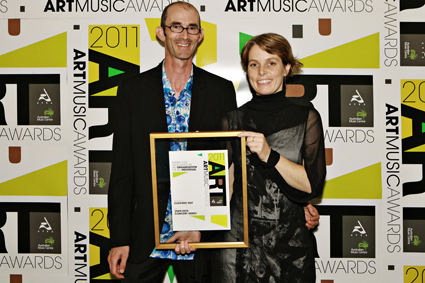
Erik Griswold, Vanessa Tomlinson, Clocked Out
photo Prue Upton
Erik Griswold, Vanessa Tomlinson, Clocked Out
THE AUSTRALASIAN PERFORMING RIGHT ASSOCIATION (APRA) AND THE AUSTRALIAN MUSIC CENTRE (AMC) HAVE ANNOUNCED THE 2011 WINNERS OF THE INAUGURAL ART MUSIC AWARDS IN THE GENRES OF CONTEMPORARY ART MUSIC, JAZZ AND EXPERIMENTAL MUSIC IN A SLEEKLY ENTERTAINING CEREMONY AT SYDNEY THEATRE DROLLY HOSTED BY JULIAN MORROW, PEPPERED WITH SOME FINE LIVE PERFORMANCES AND FRAMED BY DIGITAL IMAGERY THAT KEPT US IN TOUCH WITH CATEGORIES AND PRECISELY WHO WAS WHO.
It was gratifying for the RealTime Editors to see Queensland’s Clocked Out (Erik Griswold, Vanessa Tomlinson) and Western Australia’s Cat Hope honoured with awards. These are artists whose work we have long admired and featured.
Clocked Out won the Award for Excellence by an Organisation or Individual for their annual programs, in this case their 2009-2010 program which premiered 15 new compositions, included three international tours, plus community projects in regional Australia. They also won the Queensland State Award. The inaugural Award for Excellence in Experimental Music was taken out by Cat Hope artistic director of Decibel which in 2009-10 undertook 11 commissions for new Australian work, 10 performances, toured interstate and had four live broadcasts for ABC Radio. Hope also received the West Australian State Award for Decibel in the category of Excellence in Experimental Music
The Performance of the Year Award went to soprano Jane Sheldon and the ever inventive Ensemble Offspring conducted by Roland Peelman for their collaborative project, The Origin Cycle. Sydney-based composer Paul Stanhope won Instrumental Work of the Year for his String Quartet No 2 and Vocal/Choral Work of the Year for Deserts of Exile from his Exile Lamentations choral cycle performed by the Choir of Trinity College. Orchestral Work of the Year was awarded to James Ledger’s Chronicles performed by the West Australian Symphony Orchestra conducted by Paul Daniel.
The WA winning streak was confirmed by Johannes Luebbers who received the award for Jazz Work of the Year for his big band work Ashes to Ashes, performed by the Johannes Luebbers Dectet.
Other award winners included Michael Kieran Harvey who received the Tasmanian State Award for his homage to Frank Zappa, 48 Fugues for Frank, and recorder virtuoso Genevieve Lacey who took out the Victorian State Award for Performance of the Year for her multimedia creation, En Masse.
The Award for Distinguished Services to Australian Music was shared between Patrick Thomas and John Hopkins. Thomas recalled a long career, commencing as 3rd flute at 14 years of age, looked back fondly to the Modern Music forum he established in Brisbane with Tony Gould and going on to conduct some 110 works by Australian composers, quipping “nor just first performances!” As a young concert-goer in Adelaide. I was always impressed with Thomas’ commitment and the calibre of his conducting. Unfortunately, he was a casualty of the reforms of the mid-1980s when the ABC was divested of its orchestras. Some compensation comes with the imminent release of an eight-CD collection of his performances as conductor. John Hopkins was also appreciative of the best years of the ABC in the era of conductors Joseph Post and Bernard Heinze (whom I recall gently lecturing a restive Adelaide Symphony Orchestra audience about the meaning and sounds of Peter Sculthorpe’s Sun Music). Thomas remembered the pleasure of conducting the music of Sculthorpe, Penberthy, Brumby and others, while Hopkins treasured the particular memory of Richard Meale conducting Nigel Butterley’s Laudes and Butterley conducting Meale’s Floridas in an exciting time for Australian music. As the Art Music Awards indicate, now is another such time.
APRA and AMC, Art Music Awards, Sydney Theatre, Walsh Bay, May 3
For the full list of awards see www.australianmusiccentre.com.au/awards/
RealTime issue #103 June-July 2011 pg. 43
© Keith Gallasch; for permission to reproduce apply to realtime@realtimearts.net
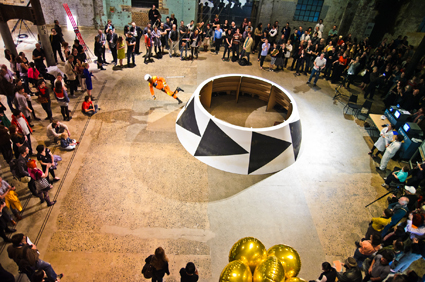
Adam Norton, Mars Gravity Simulator, 2011, Awfully Wonderful
photo Lucy Parakhina
Adam Norton, Mars Gravity Simulator, 2011, Awfully Wonderful
CONTEMPORARY ART OFTEN APPEARS SCIENCE-FICTIONAL, AS IT EMPLOYS THE LATEST VISUAL TECHNOLOGIES AND ADAPTS SCIENTIFIC IDEAS FOR ITS OWN ENDS. EXHIBITIONS OF SCIENCE FICTION (SF) IN ART ARE HOWEVER A MOSTLY RECENT PHENOMENON. IN THE RICH ANTHOLOGY OF WRITING THAT MAKES UP THE CATALOGUE FOR AWFULLY WONDERFUL, SWISS CURATOR PATRICK GYGER LISTS RECENT SHOWS ON SF AT THE INSTITUTE OF CONTEMPORARY ARTS (ICA) IN LONDON, THE POMPIDOU IN PARIS AND ELSEWHERE. YET THESE EXHIBITIONS FALL SHORT OF BEING ABOUT SF, INSTEAD HAVING SF-INSPIRED THEMES. THE ICA USES ALIENS AS A METAPHOR FOR MULTICULTURALISM (ALIEN NATION, 2006), WHILE THE POMPIDOU JOINS THE RAFT OF CONTEMPORARY SHOWS ABOUT UTOPIA (LA NUAGE MAGELLAN, 2007).
The Awfully Wonderful exhibition is more explicit as it tackles the relationship between SF and contemporary art. In doing so, it makes the striking conclusion that new technologies and cutting edge sciences in fact have little to do with the SF genre. Curators Bec Dean and Lizzie Muller instead populate Performance Space with low-tech works that speculate on such archaisms as travel through time and outer space. Two architectural dioramas by David Lawrey and Jaki Middleton recall dusty museum exhibits while portending an apocalyptic future, their miniature city overtaken by disaster. Sam Smith’s Time Travel (2009) also hinges upon the past’s future, alluding to a philosophy of travelling through time while compelling our gaze with its scenes of cinema and television. Deborah Kelly’s collages of oceanic creatures and 1960s pornography also appear out of time, their tangles of limbs and tentacles recalling the erotics of surrealism. The paradoxes of these old media works in wood, video and paper build a picture of SF as the retro-futurism of today.
This appears to be bad news for SF—that it is no longer the cutting edge genre of technology and prediction in a world that has come to look like the future itself. Like contemporary art, the world is science-fictional, leaving the actual genre stranded in a time out of time. Video works by Ian Haig and Philip Brophy push this retroactive logic to the extreme by making pastiches out of SF images, evoking clichés of gender war and alien visitation. A near naked Hayden Fowler also plunges us into a muddle of time, as he inhabits his installation of futuristic domes and grass in the CarriageWorks foyer only to evoke images of life in prehistory. Fowler imagines himself to have returned humanity to nature but this is a cleanly engineered nature with lawn and laboratory rats. There is something perversely troubling about a live performer in a set that might have been dropped from a cheap 1970s SF film. Such a meticulous realisation of the most lurid SF scenography is both compelling and discomforting in our technological age, which has long rendered such pastoral visions the stuff of fantasy.
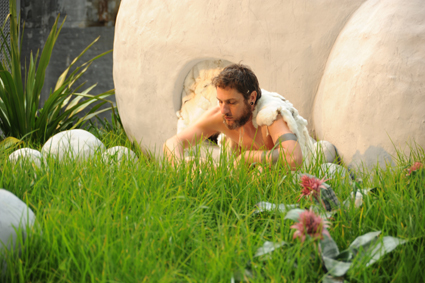
Hayden Fowler, Anthropocene, 2011, Awfully Wonderful
photo Garth Knight
Hayden Fowler, Anthropocene, 2011, Awfully Wonderful
If Fowler is a visionary, ready to move into the greater laboratory of a bioengineered world, Adam Norton is ready to move to Mars. By hanging a body harness above a room-sized running track (also in the vast CarriageWorks’ foyer), the space-suited Norton simulates the planet’s gravity, as well as NASA’s own training regimes. The sight of Norton bouncing around his track is spectacular, his sincerity and enthusiasm backed by the authenticity of his research. Norton’s work is among several in the show that shape-shift from art installation to actual science. Haines and Hinterding’s pair of cloudbusters—orgone energy machines after the plans of Wilhelm Reich—also stand at the slipping point between creative fabrication and scientific actuality. It is only a shame that there are no demonstrations of their potential to seed clouds, whip up a storm or even a tornado. What greater legacy for an exhibition like this than a great whirly-whirly lifting the tin from Darlington terraces, art’s possibilities spinning out of control in a science-fictional world?
A collection of obsolete technologies from the Powerhouse Museum also simulates the simultaneity of science and art. Safely encased in perspex, these technological artefacts are displayed in low light as if they might suddenly collapse back into their own times. One is a circumferentor, a low cost surveying instrument from the 1800s decorated with vegetal designs, appearing as if from some alternative steampunk timeline. Another, a 1K microcomputer from 1980, the Sinclair ZX80, has all the appearance of a dinosaur with its garishly large keys. These technological relics bring a scientistic sincerity to the show, casting a serious light on the allusions to arcane SF that might otherwise be comic.
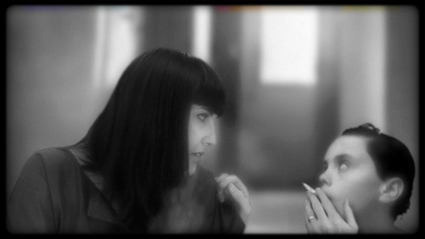
Frame Drag 1988 / 2009 / 2024, Ms&Mr
courtesy the artists
Frame Drag 1988 / 2009 / 2024, Ms&Mr
These devices are in neat contrast to one of the more metaphysical works installed beside them. A magnificent pair of video portraits by Ms&Mr alludes to some ambient, transgendered future. Two simple loops present enigmatic figures that seem to be lost in some nebulous eternity. On one screen a man’s arm disappears into a forest of stars, while on the other the artists, in footage from different times in their lives, are smoothly juxtaposed so they appear to share smoke from a cigarette. She inhales his exhale and exhales in turn in a triangulation of sensual, ambient whiteness.
The feeling that Awfully Wonderful occupies a fold in time, as it plays upon the paradoxes of an art about the future that is nonetheless a future imagined by the past, tells us as much about contemporary art as science fiction. In rushing to capture the present, attracted by this or that technological or cognitive widget, contemporary art often wilfully forgets its own past. This show casts a more complex light upon the meaning of the contemporary, insofar as its technological and political conditions have been constructed by past imaginings. If contemporary art is the dominant genre of a global, networked present, Awfully Wonderful gestures to the romanticism that produced this contemporaneity, the fantasies that brought it into being.
The success of the show also lies in the absence of the kind of grandiose work that makes contemporary art so emasculated. Instead, the artists here work in the spirit of what SF scholars call the tinkerer, the handyman who fiddles with the details of lamps and lunch trays in a quest for everyday happiness. This is in contrast to the grandeur of new media and its ambitions to rewrite the history of art, and to the new genres of technological art, such as bio-art and nano-art that are so closely tied to the politics of their industries.
Instead, Awfully Wonderful is driven by a pragmatic and retro utopianism. Simon Yates’ hilarious Metropolis Robot is symptomatic of humble hope, as he creates a walking version of Fritz Lang’s cinema icon. In a single stroke Yates solves one of the most expensive problems in robotics, this being the bionics of walking, as he suspends the robot with cheap helium balloons and propels its legs with two AA batteries. Such is the genius of the tinkerer, who shows us that the future, or even the present, is not as complex or difficult as we might have imagined it to be.
Awfully Wonderful: Science Fiction in Contemporary Art, curators Bec Dean and Lizzie Muller, Performance Space, Sydney, April 15-May 14; www.performancespace.com.au
RealTime issue #103 June-July 2011 pg. 44
© Darren Jorgensen; for permission to reproduce apply to realtime@realtimearts.net
{$slideshow} IN HIS VIDEO WORK FIVE PRODUCTION COMPANY LOGOS IN 3D, EMILE ZILE STANDS AROUND LOOKING SLIGHTLY BORED IN JEANS AND A HOODIE IN AN EMPTY SPACE THAT COULD BE A GALLERY, EXCEPT THAT IT’S LIT BY OFFICE-STYLE SETS OF CEILING FLUOROS. INCONGRUOUSLY, WE HEAR A DESCENDING WALL OF SOUND MIMICKING PERFECTLY THE IMPRESSIVE ZOOMS AND SWEEPS OF CINEMA COMPANY PROMOS—AND FROM HIP HEIGHT WE WATCH ZILE GIVE US THE ACCOMPANYING ‘3D GRAPHICS’ IN A SERIES OF SMALL-FRAME HAND MOVEMENTS. THE GESTURES ARE BOTH RIDICULOUS AND ORDINARY. IN A DIFFERENT CONTEXT THEY MIGHT READ AS EXPLANATORY OR, ODDLY, AS A MIX OF ‘SHOWING’ AND ‘GIVING.’
When the ‘music’ zooms in, out, up or down, so do the hands. One by one, Zile works his way through five short aural ‘signature’ tracks over two and a half minutes, never appearing to take any more interest in what his hands are doing than he might if he were at home watching a series of TV ads. It looks vacuous, but no less so than the brightly coloured starbursts and rotating logos of corporate motion graphics. Which I guess is, at least in part, the point.
Amsterdam and Melbourne-based Emile Zile’s work ranges from solo performances to VJ-ing, gallery installations and video. Five Production Company Logos in 3D fits into a stream of Zile’s thinking that concerns itself with “an ever-accelerating culture of image consumption and distribution.” A couple of (much) earlier works put the new work into context for me, one of them being 6pm Personality (1999). TV newsreaders’ heads are fairly crudely disjoined from their words, bobbing and mouthing in reversed black and white. Almost too simple, their de-contextualisation exposes the coded patterns to which our perception so easily adapts, highlighting gestures that otherwise lock unnoticed onto our media ‘receptors’ like dubious nutrient onto enzyme.
And then there is Larry Emdur’s Suit (2002 see RT57, and RT84). Zile is chosen as a contestant on The Price is Right. He comes-on-down, gliding and shuffling. He shrugs, waves his hands, twitches and finishes up on stage, generating a series of movements that range in possible interpretation from ‘right on’ to ‘wow’ and then well beyond meaning. Host Larry Emdur can’t talk, he can only meet gesture with gesture, synching into Zile’s dance with a set of his own random movements—his ‘receptors’ forced to instantly accept Zile’s ‘language’ by TV’s imperative to keep moving seamlessly. Both works illustrate a fascination with body movement transformed for media consumption.
Philip Brophy, in his catalogue essay for Five Production Company Logos in 3D, sees Emile Zile’s groin-level gesturing aptly as a ‘spoof’ on masturbatory corporate excess. It strikes me also as a kind of post-mass-media shadow-puppetry, almost as though Zile might be telling us a story around the campfire, his flickering hands casting the shape of mythical battles or god-heroes onto thin air. The banal human presence is complicated by the artist’s transformation of gesture into looped-back, empty artifice. Throughout the video the glimpses of his shoulders and face, the way he wanders back into start-position between ‘takes,’ suggest boredom. There’s also something of the Archibald Packer’s Prize about it, the appearance of a moment where the common man steps out and has his say—or has a lend of us.
At face value Emile Zile spoofs the smoke and mirrors of the corporate-logo-in-extremis, but in the end, of course, his movements depend as much on our ability to read signs as the logo itself does. What separates it from a dumb joke is perhaps—or of course—only the gallery. It’s like air guitar, or a kind of 21st century Rolf Harris painting—a whipped-up cliché on a wall, elevated in status by the perfect, synthesised pomposity of Adam Milburn’s spot-on soundtrack. Married to Zile’s movements, Milburn’s swooping synths no longer signal the magnificence of big business and CGI graphics. Instead the audio pans out sideways to encompass the ego of the artist, even as the artist himself stands around in scuffed shoes ineffectually waving his hands.
The human body can only be in ‘3D,’ can’t it? And yet it’s obvious that what comes out of the graphics studio is as human—the product of clicks and drags—as a pair of hands, thumbs hooked together casting a bat shadow on the wall behind it. In the 2.5 minutes it takes for Zile’s Five Production Company Logos in 3D to loop around and begin again, his hands approach, recede, make clunky little chops in the air, respond to 60-Minutes-like ticking and Val Morgan-like aural morphings and take a rest at the end with briefly folded arms. In the CGI studio there’s a keystroke to ‘cut’ that monumental ending. Emile Zile simply clicks his fingers.
Five Production Company Logos in 3D, (single-channel video, 2010) artist Emile Zile, audio Adam Milburn, Dianne Tanzer Gallery, Melbourne April 2–23
RealTime issue #103 June-July 2011 pg. 46
© Urszula Dawkins; for permission to reproduce apply to realtime@realtimearts.net
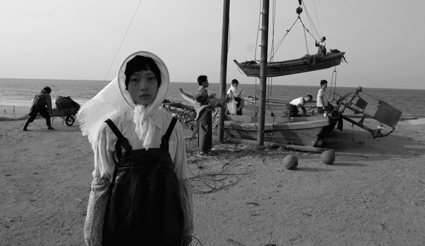
Seven Intellectuals in Bamboo Forest–Part IV, 2006, Yang Fudong
courtesy the artist, ShanghART Gallery, Shanghai and Marian Goodman Gallery, New York and Paris
Seven Intellectuals in Bamboo Forest–Part IV, 2006, Yang Fudong
STEPPING FROM PADDINGTON’S GOODHOPE STREET INTO YANG FUDONG’S NO SNOW ON THE BROKEN BRIDGE (2006) AT THE SHERMAN CONTEMPORARY ART FOUNDATION, YOU FIND YOURSELF PLUNGED INTO DARKNESS. EIGHT SILVER SCREENS FLICKER TO YOUR RIGHT, ASSISTING YOUR EYES TO ADJUST, WHILE CLUMPS OF BEANBAGS TAKE SHAPE SLOWLY IN THE SHADOWS TO YOUR LEFT. A FINE THREAD OF MUSIC BECOMES DISCERNIBLE—SMATTERINGS OF PIANO AND VIOLIN EMERGING FROM SOMEWHERE BEHIND THE SCREENS. YOU SINK INTO A SEAT AND ALLOW THE ARC OF BLACK AND WHITE IMAGES TO ENGULF YOU.
Your first thought on entering this work is where to place your attention. Each black and white image is gorgeous, yet none lasts more than a few languid seconds and the screens all compete for interest. For a moment your eye rests upon a woman in a silk cheongsam and fur stole, laughing as she crosses a bridge with her friend. Then you’re distracted by a man approaching in long, traditional Chinese robes, or another in a suit and bowler hat. Exquisite shots of plum blossoms and Chinese pavilions, of young lovers and girls in dapper drag, begin and are then replaced, until you relinquish expectations of narrative and give over to a dreamlike state.
Like much of Yang Fudong’s work, No Snow on the Broken Bridge draws on classical Chinese aesthetics, early 20th century fashion and the trope of the young romantic to create a feeling of disconnectedness from the world. Set amidst the scenery of Hangzhou’s famous West Lake, the film has a sense of both floating and ennui, its cast of preened young characters indolent to the point of camp. There are moments when people disappear behind boulders, or lie in the sun with great portent, feeling almost like Picnic at Hanging Rock: young people in their finery experiencing the power of nature and beauty. Running at 11 minutes, with no real beginning or end, the installation is a playful mosaic—an impressionistic dreamscape pregnant with unexplained mystery and meaning.
Downstairs in the gallery’s annexe, Yang’s film Seven Intellectuals in Bamboo Forest (2003-07) continues these themes and visual references—again, in Yang’s signature monochromatic style. An epic work, it consists of five parts, each running between about 30 to 70 minutes and totalling almost five hours in all. The film is loosely based on a story of seven Taoist sages from the Wei Dynasty (220-265BC) who rejected public life in favour of one of seclusion in the forest. Choosing not to belong to the bureaucratic elite, they devoted their lives instead to conversation, poetry and music and the pleasures of food and wine.
As with Broken Bridge, Seven Intellectuals evokes a sensation of drifting, its young and debonair protagonists seemingly lost in their search for meaning. The film also samples imagery from traditional Chinese poetry and painting, mixing this with fashions from 1930s Shanghai to create an urbane and otherworldly feel. Despite this ambience, however, Seven Intellectuals is set in current times, its characters contemporary in their existential dilemmas, their environment a half-demolished, half-built China. Moving from the famous scenery of Huangshan Mountain (the ‘sea of clouds’) to life in a modern apartment, to a farm, to an island and back to the rubble of a modern Chinese city, the film’s five parts present aspects of contemporary life framed by an aesthete’s imagination.
There is something of De Sica’s The Garden of the Finzi-Continis (1970) in Seven Intellectuals. These suave and privileged young people are seductive, but cold, their lassitude faintly disconcerting. The film’s melancholy is reminiscent too of Visconti’s Death in Venice and there are moments in the first part of Seven Intellectuals in particular, when youths languishing on rocks or staring off mountain tops echo the young Tadzio pointing to the sky. Yang is working within a number of cinema traditions and has cited both European and Chinese filmmakers as influences on his work.
It is perhaps the combination of these two cultures and their fascination for one another that makes Yang Fudong’s films so alluring, particularly for a Western audience—the plaid suits and mountain mists, the chinoiserie. It’s easy to linger under the spell of these installations, their strangeness providing just the right amount of intrigue (while their familiarity consoles). Yang has stated his attraction to the traditional aesthetic of yihui, or sensation, and this exhibition works on you in this way. Making few demands, these works lull you to a point where it becomes easier to surrender to their beauty than to try to piece together their meaning.
Yang Fudong, No Snow on the Broken Bridge, Seven Intellectuals in Bamboo Forest; Sherman Contemporary Art Foundation (SCAF), Sydney, March 18-June 4, www.sherman-scaf.org.au/exhibitions
RealTime issue #103 June-July 2011 pg. 46
© Christen Cornell; for permission to reproduce apply to realtime@realtimearts.net
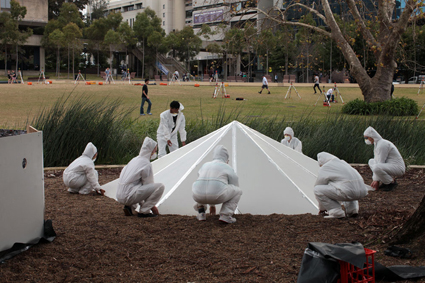
DISASTR Hotel, 2011, DV Rogers, The Right to the City
photo courtesy the artist
DISASTR Hotel, 2011, DV Rogers, The Right to the City
“SHE’S FOR SANDAL-WEARING, MUESLI-CHEWING, BIKE-RIDING PEDESTRIANS.” THIS WAS PAUL KEATING’S EXTRAORDINARILY ARROGANT DISMISSAL OF MAYOR CLOVER MOORE’S PRESENTATION TO NSW PARLIAMENT OF A PETITION WITH 11,000 NAMES PROTESTING THE CURRENT DESIGN PLANS FOR THE BARANGAROO URBAN WATERFRONT DEVELOPMENT, WHICH LED TO HIS REACTIONARY RESIGNATION FROM THE PROJECT.
Tucked within the more sedate enclave of Sydney University’s Architecture Department, far from the combative squabbling of ex and current politicians, the Tin Sheds Gallery in April hosted The Right To The City, a multifaceted exhibition, symposium and publishing project that, while not directly concerned with this particular urban conflict, echoed its tensions by seeking open-ended responses to the spatial politics of the city.
Here, interdisciplinary artists cultivated the gallery space and beyond with sculptural objects, installations, video, photomedia and speculative works that circumvented the top down approach to urban planning, testing what might emerge in the interstices of public, creative and professional dialogue.
This was by no means unfamiliar territory for co-curator Zanny Begg, who two years earlier helped create an impressive exhibition for Performance Space, There Goes the Neighbourhood, which explored the regeneration of Redfern (RT92, p52). At Tin Sheds, where she is Director, Begg worked in tandem with University of Sydney Senior Lecturer Lee Stickells to present an exhibition more general in reach, taking as its starting point a 2008 article by British geographer David Harvey, “The Right to the City,” although his are concerns that have been percolating for some time. They are questions of access, whether we build for people or for profit, how public and disused space might be used more creatively and what power, if any, citizens have to influence the development of the city. Despite the timely and prescient nature of these concerns Sydney is notoriously a city driven by consumerism, which means that urban activism is often met with apathy. Yet the continuities between works presented in this exhibition reveal how, as life increasingly falls into an earn/buy cycle, certain symbols that resonate as alternatives are at least gaining greater visibility.
Among the most prevalent is the communal garden. As an embodiment of sustainability, collectivity and self-reliance it’s understandable that it figured in a number of works presented. The most striking treatment was arguably a multi-channel video installation by the France-based architects Constantin Petcou and Doina Petrescu, At the Ground Level of the City (2001-2005). This was an unconventional account of their ECObox project, a series of nomadic self-managed community gardens installed in urban wasteland sites in the suburbs of Northern Paris. Drawing upon 99 hours of archive footage of the gardens gathered over five years using a “participative camera” that passed through multiple hands to record everyday life at the sites, a dynamic and non-linear documentary approach successfully conveyed the fluid and evolving nature of these reclaimed spaces. Played in fast succession and spliced across seven screens, the footage was set to a soundtrack mixing industrial noise, world music and snippets of conversation, injecting vitality into the ‘quotidian’ while avoiding romanticism in the subtle acknowledgment of the inevitable development of the sites.
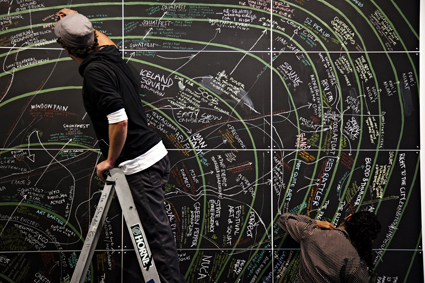
SquatSpace Mapping Project, The Right to the City
photo Zanny Begg
SquatSpace Mapping Project, The Right to the City
In a nearby corner, Sydney’s SquatSpace responded to the challenge of recording the collective’s transient history by using chalk to plot their 10 year legacy of urban activism on panels of blackboards in an ebbing and flowing ephemeral timeline, Network Map (2011). The sprawling and indefinite history was complemented by a short documentary film by Justin Hewitson, Squat the Lot (2000-2003), which recounted the turbulent period when artists occupying vacant council-owned buildings on Broadway were evicted prior to the Sydney Olympics. The video was perhaps the most outspoken work in the gallery, as others appeared more concerned with subtler, less anarchic modifications of urban space. Chicago’s Temporary Services surveyed with a forensic eye milk crates refashioned into basketball hoops and roadside memorials in their series of photographs, Public Phenomena (2008-2010), while urban redevelopment took a lo-fi turn in Milkcrate Urbanism’s The North Eveleigh Propositional (2011). After a mobile feedback box was dispatched to various locations around Redfern inviting alternative development proposals for the former railyards site, the feedback was incorporated into a newspaper style publication and pinned to the wall although, with only three suggestions on display, this particular speculative project felt a little incomplete.
When the force of nature unexpectedly asserts itself, the task of remaking the city becomes a more urgent dilemma. Hunkered down in an outdoor refuge campsite a short walk from the gallery, DV Rogers presented the 14-day endurance performance installation DISASTR Hotel (2011), which saw the artist build two hexayurt shelters following an open source design by Vinay Gupta and then invite visitors to stay overnight to judge the efficacy of the shelters and to consider their own preparedness for a disastrous event. Some Ballardian style signage spelling out DISASTR in large letters studded with brightly coloured light bulbs created a performative setting, however this was not a work of science fiction. On the contrary, Rogers was concerned with enacting “a symbolic field test,” demonstrating how DIY open hardware structures already exist as viable transitional responses that could be set up in present day disaster zones. The question is, what is holding us back from implementing them?
With a tagline citing Buckminster Fuller’s provocation “we are called on to be the architects of the future, not its victims,” the exhibition’s earnestness was counterbalanced with some playful, tongue-in-cheek works. The Holmes stereoscopic viewer received an anthropological twist in Tessa Zettel and Karl Khoe’s primitive masks jerry-rigged with plastic ephemera and clapped-out gauges. Another collaborative duo, Claire Healy and Sean Cordeiro, accosted visitors with Sound Barrier 2011, a giant wooden catapult sporting a slingshot stockpiled with fluorescent orange earplugs. Flung target practice style at a blank white board, the spray of compact foam bullets on the wall resembled a minimalist colour field painting meets urban-noise-pollution-dart-board, a witty indictment of how the gentrification process demands not only land but also sensory homogenisation.
Stepping outside the gallery and into the courtyard, where students and lecturers were breaking between classes, reinforced how critical the site was to the effectiveness of this exhibition. Some of the less polished, work-in-progress installations might not have withstood the tougher aesthetic scrutiny of an austere white cube space. But in an environment where art, design and education naturally cross-fertilise, such works became key components in what was essentially an art forum. While we may lack a centralised method to surmount the circle of government, developers and purchasers who largely determine the evolution of our cities, by giving expression to the humbler gestures and desires of the everyday, this exhibition highlighted the alternatives that can burst through the cracks when necessity, inspiration or sheer dogged perseverance take hold.
The Right to the City, curators Zanny Begg, Lee Stickells, artists Claire Healy & Sean Cordeiro, atelier d’architecture autogeree, DV Rogers, Temporary Services, SquatSpace, Milkcrate Urbanism [Sophie Warren, Jonathan Mosley, Marjetica Potrc, Tessa Zettel, Karl Khoe], Bababa International, Tin Sheds Gallery, University of Sydney, April 8-30
RealTime issue #103 June-July 2011 pg. 47
© Ella Mudie; for permission to reproduce apply to realtime@realtimearts.net
![Nicola Leahey, Jessica Jefferies, [sic], Dancenorth](https://www.realtime.org.au/wp-content/uploads/art/46/4690_ashley_dancenorth_sic.jpg)
Nicola Leahey, Jessica Jefferies, [sic], Dancenorth
photo Bottlebrush Studios
Nicola Leahey, Jessica Jefferies, [sic], Dancenorth
HAVING FUNDRAISED TO ENABLE THE ENTIRE COMPANY OF DANCERS TO ACCOMPANY DANCENORTH ARTISTIC DIRECTOR RAEWYN HILL TO HER BARYSHNIKOV RESIDENCY LAST SEPTEMBER, TOWNSVILLE WAS REWARDED WITH THE PREMIERE SEASON OF HER SHORT WORK BLACK CROWS, DEVELOPED DURING THE FORTNIGHT IN NEW YORK. HILL INVITED ROSS MCCORMACK AND ELIE TASS, IN AUSTRALIA EARLIER THIS YEAR WITH LES BALLETS C DE LA B, TO CREATE A SECOND SHORT WORK FOR DANCENORTH’S SEASON-OPENING DOUBLE BILL. TITLED [SIC], THIS EDGY AND CONFRONTING PIECE OF DANCE THEATRE WAS A PERFECT FOIL FOR THE CONSIDERED GRACE AND POWER OF BLACK CROWS AND A TESTAMENT TO THE VERSATILITY OF THE DANCENORTH DANCERS.
[sic] opens with a dormant pyramid of tangled bodies heaped against a wall as if thrown there. Apart from Nicola Leahey on top, standing semi-slumped against the wall with her back to us, it is difficult at first to see how many individuals are in the heap. To Jody Lloyd’s intoning, whispering soundtrack, Leahey eventually begins to jerk and slither down the now erratically twitching pile, while Lauren Carr slowly emerges like a breech birth from underneath. The two start inching across the floor in unison, on all fours, faces up. Their movements, initially insect like, progress to larger gestures and rolls, culminating in a twining, spastic embrace completely lacking in eye contact or any evidence of emotional connection.
Meanwhile the pile has been delineated and Thomas Gundry Greenfield, Jessica Jefferies and Jeremy Poi stand and stare down the audience, grinning malevolently. They intermittently reconfigure their cluster, moving without averting their challenging focus. This hostile inversion of the usual audience/performer gaze is discomforting. People cough, shift and half laugh.
All five dancers wear mismatched underwear—paradoxically exposed and vulnerable, yet bold as brass. The minimal costumes allow us to see every muscle isolation, each gesture and extension. When all of the dancers balance on their buttocks on the floor while holding an excruciating, uniformly angled Pilates V for what seems an eternity, the audience sweats in sympathy. The dancers hold and hold until quivering and in a pause in the music, their breathing provides the rhythm.
This almost perfect unison is a feature of [sic], right down to minute repetitions of flicked-back hair, lip biting and breath exhalation during a sequence of erotically charged flirtation with the audience. Set to a musical passage of classical strings, it appears to subvert the famous Swan Lake ensemble piece, with a pout and a lewd hip leading as the dancers rhythmically shift weight from foot to foot. Only Leahey falls out of time, blank-eyed and panicky, clutching at her throat. As Greenfield, Carr and Poi blithely continue the chorus line, Jefferies is on the floor. Leahey squats over her and, blank-eyed with an eerie absentmindedness, kneads the unresponsive Jefferies’ face while the audience squirms.
[sic] scrapes back the veneer of civilisation and utterly fulfils its intention as a series of moments of indulgence in primal, uncensored tics and urges. A sublime and grotesque experience, the entire audience is discussing it the moment it’s over and the descriptor ‘disturbing’ ricochets around during intermission.
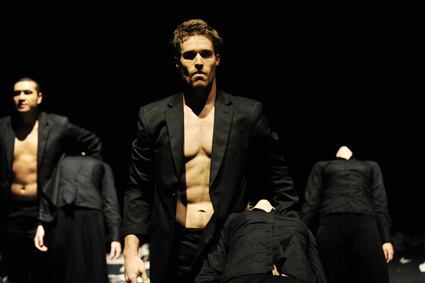
Thomas Gundry Greenfield, Black Crows, Dancenorth
photo Bottlebrush Studios
Thomas Gundry Greenfield, Black Crows, Dancenorth
Black Crows takes us on a very different journey of heightened emotions, of people pushed to the limit by extraordinary circumstances (war) but held in check by a sense of duty, discipline and the common good.
The costumes are Amish in their austerity—shirtless black suits for Greenfield and Poi, long widows’ weeds and hair pulled back for Carr, Jefferies and Leahy. The floor is precisely blanketed with old newspapers and, from the first pass of the dancers across the stage, its orderliness irrevocably disintegrates. The simple metaphor works brilliantly, with dignity and restrained passion in the dancing, chaos and unpredictability underfoot. In one later scene the dancers briefly lapse into a panic, scrabbling on the floor trying to pick up as much newspaper as possible and clasping it to their chests. Their desire to know is poignant in its futility.
Spaniard Micka Luna’s pumping score is contemporary but suggests WWII with sounds evocative of aeroplane engines roaring, air raid sirens and radio static. Inhabited with heartbeats and night terrors, it winds down to a slow dance to support the tenderness and heartbreak of the final scenes of reluctant, duty-bound men leaving behind stricken women.
With some of the ensemble pieces obviously devised for three couples, the absence of one male dancer through injury compromises the symmetry occasionally, but more often works in favour of the current of loss.
Black Crows, a beautifully realised and satisfying entity in itself, is also a precursor for an upcoming full-length work, Mass, on similar themes, opening at the end of June. Raewyn Hill’s choreography and Luna’s score will be expanded, with Jocelyn West (UK) on vocals and Mariona Omedes (Spain) creating digital imagery for the performance.
Dancenorth Double Bill: [sic], choreography, concept, direction Ross McCormack, Elie Tass, music Jody Lloyd, lighting Van Locker; Black Crows, choreography, design concept Raewyn Hill, music Micka Luna, lighting design Van Locker, dancers Lauren Carr, Thomas Gundry Greenfield, Jessica Jefferies, Nicola Leahey, Jeremy Poi; Dancenorth, Townsville, March 18–May 13
RealTime issue #103 June-July 2011 pg. 30
© Bernadette Ashley; for permission to reproduce apply to realtime@realtimearts.net
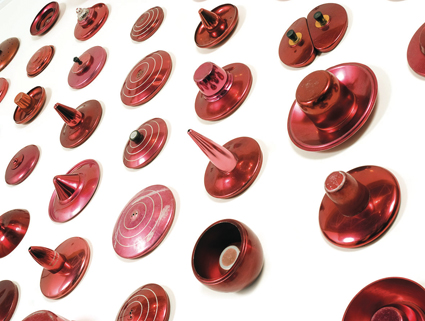
Naples 2011, Donna Marcus, found aluminium (detail), NOW and WHEN: Australian Urbanism
courtesy the artist and dianne tanzer gallery + projects
Naples 2011, Donna Marcus, found aluminium (detail), NOW and WHEN: Australian Urbanism
“We are called on to be the architects of the future, not its victims,” Buckminster Fuller once insisted. His words are an apt reminder of the rising public passion now for the re-casting of cities to improve access, health and the environment. Alternatively, we could become the artists of the future. There’s plenty of evidence in this, The Future City edition of RealTime, where we report on artists, often in collaboration with the public and working in public spaces, altering our perception of the city, recasting it as gallery and performance arena, communal meeting place and green environment. Our stories range from a gardening project in an art school (Tending) to re-workings of the city (Right to the City) and pragmatic and fantastical cities of the future (NOW and WHEN). Dancers re-cast Perth (Tongues of Stone). An artist and the community transform a city centre south of Sydney with video works and a performative installation (The Begin-Again). Performers place their audience inside a cardboard Manila in Sydney’s West in Within & Without (p2). An artist creates a site-listening guide to greater Brisbane. Visiting Irish/UK artists Desperate Optimists show their film Tiong Bahru in which Singaporean locals enact the tensions and pleasures of their lives. In Birmingham UK, artists in the Fierce festival inventively take on the city. On this page, Gold Coast artist Donna Marcus, in an adjunct exhibition to NOW and WHEN, reflects on the architectural layering and historical aura of Naples using found aluminium cook-ware. And, in the first of our Burning Issue features, you can read how the late German theatre provocateur Christoph Schlingensief made cities politically performative.
RealTime issue #103 June-July 2011 pg. 1
© RealTime ; for permission to reproduce apply to realtime@realtimearts.net
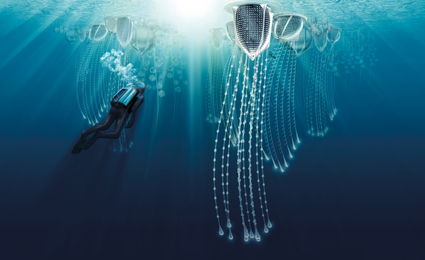
The Oceanic City, Arup, team members Alanna Howe, Alexander Hesp
image FloodSlicer
The Oceanic City, Arup, team members Alanna Howe, Alexander Hesp
NOW AND WHEN: AUSTRALIAN URBANISM IS NOT YOUR TYPICAL EXHIBITION FARE. RATHER IT’S ARCHITECTURE AS POETRY, COMBINING THREE-DIMENSIONAL MOVING IMAGE, SOUND AND INSTALLATION. AS A CONVERSATIONAL CATALYST, A 16-MINUTE FILM HOUSED WITHIN THE EXHIBITION, DESCRIBES THE URBAN DENSITY AND ECONOMIC SUSTAINABILITY FACING AUSTRALIA, AND HOW THESE MAY INFORM HYPOTHETICAL (IF NOT HYPERREAL) VISIONS OF URBAN EXISTENCE 50 YEARS FROM NOW, AND BEYOND.
NOW and WHEN is creatively directed by John Gollings and Ivan Rijavec, realised in 3D by Floodslicer and commissioned by Janet Holmes à Court. Launching at last year’s prestigious Venice Architecture Biennale, the show attracted an impressive 93,000 attendees. The Gold Coast is Australia’s sixth fastest growing city. It is also a metropolis that, in voraciously re-imagining its urban character, also serves to delete whatever is left of its architectural heritage. This is where Now and When makes its Australian debut.
Entering Gold Coast City Gallery, the venue for the show, I immediately feel transported into an otherworldly environment. The cavernous, infinity-like darkness of the space is startling. I find myself transfixed by the way-finding lines that slash across the black-coated walls and onto the floor and glow blaze-orange under ultraviolet lighting. Like traffic cones, they direct me to a stack of hollowed-out orange cubes. Fashioned into a dense cluster, not unlike a downtown city, these cubes tower at varied heights and remind me of the skeletal histories of past buildings, or templates of a future metropolis. Or perhaps they represent the void between people who reside in high-rises, disengaged from the bustling congregation of the ground below. A great screen commands the middle of the space, and 3D glasses (made especially for the show) vine down from the ceiling. I take my place in a scatter of stools and prepare for the eye-ride.
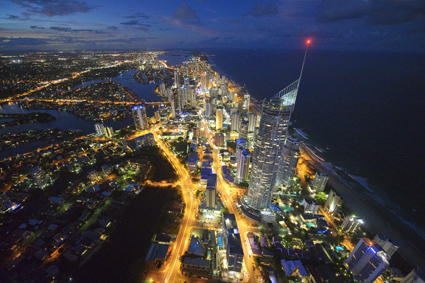
Surfers Paradise, Queensland, Australia, NOW
photo John Gollings
Surfers Paradise, Queensland, Australia, NOW
now
The short film starts with prototypical photographs of contemporary Australian landscapes, as documented by John Gollings. Here, vastly deserted mining craters of the western outback are contrasted with the high density eastern cities of Melbourne, Sydney and Surfers Paradise. Ninety three percent of Australia’s population is crammed onto the whiskers of the coastline, or the upward heave of concrete and lights. At the same time, it’s alarming to see colossal craters drilled into Newman and Kalgoorlie to become cityscapes in the distant future.
when
WHEN features 17 immersive, at times overwhelming, multi-dimensional explorations of future cityscapes. Selected from a nationwide competition, various designers and architects aimed to challenge conventions, and liberate themselves from notions of ‘safe’ design.
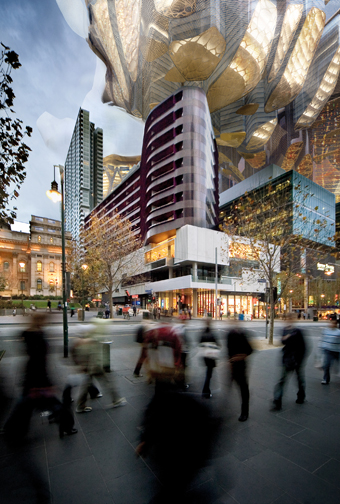
Multiplicity, John Wardle Architects and
Stefano Boscutti, WHEN
image FoodSlicer
Multiplicity, John Wardle Architects and
Stefano Boscutti, WHEN
At the recent Excellence in Architecture forum, Michael Harrison from City of Sydney asked: “Are cities a kind of grand accident, or can human will be exercised effectively so that city form is a true expression of our highest aspirations?” Aspiration is indeed what comes to mind when viewing snippets of an idealistic, harmonious future. Among the highlights: In Multiplicity (John Wardle Architects and Stefano Boscuitti) Melbourne does not expand further inland, rather it grows up and down. Airspace is utilised to intersect a ‘floating city’ with the existing ‘underground’ metropolis. Featured on this edition’s cover, Mould City (Colony Collective, Melbourne School of Design) explores what Rijavec calls “metropolitan Darwinism,” re-conditioning mould to turn it from a decaying organism into an active harnessing source. The ongoing migration problem in Australia is resolved through gigantic residential biomimetic water-pods in The Ocean City (Arup).
3D
Recently, film critic Robert Ebert chastised 3D films as a waste of filmic experience and an excuse to hike up movie prices. However, I believe that in the circle of architecture, 3D is king. This show portrayed architecture as having the ability to visually stimulate, augment and enchant, to convince audiences they are, for a moment, immersed in another dimension. Urban planners will use this new form of 3D to translate concepts and multifaceted visual narratives, and flattened drawings and models will come to life as environments and encounters.
sound & interactivity
The show’s soundtrack, engineered by T4K, enhances this suspension of disbelief. The score for NOW sounds foreboding, sometimes urgent—often the bass rumbles at my feet, leaving my stool slightly vibrating. I am later told by a gallery staff member that the positioning of the sound system just behind the audience was an intentional request by the Creative Directors. In contrast, WHEN is meditatively ambient, heightening the utopian imagery of a fearless and environment-friendly future city. I stay for repeated viewings, and notice that while a few visitors complain of the sound being too loud, a group of children appears to relish this environment. Their shoulders jump slightly at the sharp, cacophonous parts and they harmoniously ‘whoosh’ around the swirl-sounding scenery of Saturation City (McGauran). Children also seem to sit very close to the projection screens—not so different from watching television up close—but without the restraints of two-dimensional TV screens. This multi-layered experience means they too can be part of the action. The kids start clawing their hands in the air and like cats about to scratch, they ‘catch’ the enormous jelly-fish-like hydro-turbines of The Ocean City and duck down as the glass-like, multi-polar structures of Survival and Resilience pierce the air (BKK Architects, Village Well, Charter Keck Cramer and Daniel Piker).
side-shows
Displayed alongside the film is Then and Now: The Surfers Paradise Re-photography Project, a comparative 2D photographic study of Surfers Paradise from 1973 to present day 2011. I am astounded to see just how much this city is alien to its vintage evidence. As John Gollings laments (Sara Hicks, “A 3D Revolution in Architectural Photography”, ABC Radio 2011), “The problem is there is not a single building left in the photographs that I shot and they’ve moved the road alignments…I want people to understand what’s been lost and what’s been gained by these direct comparisons.” Out on the foyer, Revisiting the City—Naples by Donna Marcus sees an assemblage of aluminium kitchenware depicting the civic uniformity of grid cities. (See Editorial page.)
the 3D book
NOW and WHEN is a blockbuster exhibition supported by a limited edition 3D book, a short documentary and two mini-exhibitions as well as forums and workshops. However, unlike traditional shows seen at much larger, institutional galleries—whereby pre-digested mainstream works from overseas ‘star’ artists are imported—NOW and WHEN is proudly an Australian production, one of fierce creative foresight and technological vigour. And while the urban fabric explored is uniquely Australian, the issues it raises are felt globally.
To encapsulate the experience, the book comes with complimentary 3D paper glasses bringing to life the NOW pages. Like the film, the pages are split between the insipid mining fields and the luminous, dusk-shot city lights. When a colleague perused the 3D sections she shrieked, “This book is giving me vertigo!” She shut the book, thus flattening the pointy skyscrapers that, for a moment, seem to dart off the paper.
And this is inherently what exhibitions should be about, eliciting reaction and pushing boundaries. As an avid exhibition-goer, I feel that NOW and WHEN is one of the most striking shows I have seen in a long while. Someone asked me, “What is an architectural showcase doing in a contemporary art gallery?” There is a saying that an artist can create a square wheel, but an architect must make theirs round. Through NOW and WHEN architects become artists by harnessing creative inceptions to build cities and streetscapes that supersede realistic notions and constraints. This entertaining and spectacular program achieves its aim to create instant impact, to make those wheels square and to leave an impression long after the glasses are taken off.
NOW and WHEN originally appeared in the Australian Pavilion, Venice for the 12th International Architecture Exhibition, La Biennale di Venezia, 2010, and is now showing at the Seoul Museum of Art, from April 25-June 26. Versions of the exhibition will appear at Object: Australian Centre for Craft and Design, Sydney, July 2-Sept 25 and Ballarat International Foto Biennale, Aug 20-Sept 18.
Australian Institute of Architects, NOW and WHEN: Australian Urbanism, creative directors John Gollings, Ivan Rijavec, 3D visualisation Floodslicer; Gold Coast City Art Gallery, March 26-May 1, www.architecture.com.au
RealTime issue #103 June-July 2011 pg. 5
© Mariam Arcilla; for permission to reproduce apply to realtime@realtimearts.net
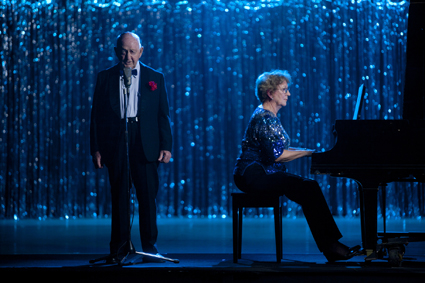
Vince Lemon, Mavis Noakes, Old Man River, video still, Angelica Mesiti, The Begin-Again
image courtesy and © the artist, photo Jamie North
Vince Lemon, Mavis Noakes, Old Man River, video still, Angelica Mesiti, The Begin-Again
AS WE INCREASINGLY ADDRESS THE PLIGHT OF THE NATURAL ENVIRONMENT, OUR CONCERNS EXTEND TO CITIES, NOT JUST THEIR POTENTIAL FOR GREENING BUT AS SITES OF HUMAN CO-OPERATION AND CULTURAL SHARING. ONE SUCH VENTURE IS THE C3 WEST PROJECT, A COLLABORATION BETWEEN THE MUSEUM OF CONTEMPORARY ART, CASULA POWERHOUSE ARTS CENTRE, PENRITH REGIONAL GALLERY AND THE LEWERS BEQUEST, CAMPBELLTOWN ARTS CENTRE AND COMMERCIAL PARTNERS.
C3 West has extended south to Hurstville with The Begin-Again. Angelica Mesiti, a video, performance and installation artist based in Sydney and Paris, worked intensively with locals to create four video works and a performative installation that could be enjoyed over two nights as you wandered the city centre.
Just outside the railway station on Memorial Square a large screen shows respected senior citizen Vince Lemon sveltely delivering “Old Man River” with an affectingly pronounced Australian accent. Down the main street in a small park by the Bus Exchange, we watch another video projection, intriguingly juxtaposing a driving percussion soundtrack with images of young children in various historical guises joyfully re-constructing the first local railway line and then innocently kicking it apart (a comment it seems on current public transport issues). Despite being dimly projected, the work is enthusiastically received by a large gathering of families.
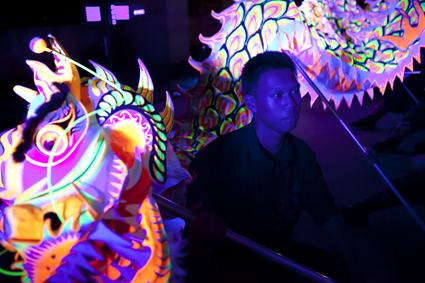
Kwang Leung, Parking Lot Dragon, Angela Mesiti, The Begin-Again
image courtesy and © the artist, photo Jamie North
Kwang Leung, Parking Lot Dragon, Angela Mesiti, The Begin-Again
Down a nearby lane we encounter another screen, this time featuring local ballroom dancers waltzing against a classic TV studio city skyline design. The video is beautifully edited, conveying the charm and confidence of the dancers—another kind of free-floating innocence. Suddenly out of the first night crowd, a popular featured dance pair glide before the screen and execute some deft turns to great applause. Around the corner on an otherwise bland brick wall, Lucinda Liu elegantly performs Water Sleeves, a traditional Chinese dance often shot in medium close-up with orange-red textures to capture the nuances of expression and gesture. At the top of the ramp, there’s something quite different, Parking Lot Dragon—four revving, glammed-up cars (smoke machines sensibly providing the mock exhaust fumes), vividly lit from below and darkly sparkling as their sound systems rumble. Darting and looping between them comes a richly fluorescent day-glo Chinese dragon (mythological but also a local sports mascot) whose increasingly sinuous moves are brilliantly executed.
The Begin-Again is not an epic event, but an intimate one built out of protracted collaboration with locals who become onscreen or live performers. Urban Theatre Projects has long engaged communities in Sydney’s West through an impressive range of performative means, while here The Begin-Again brings together the cinematic inclinations of a visual artist with local issues and passions.
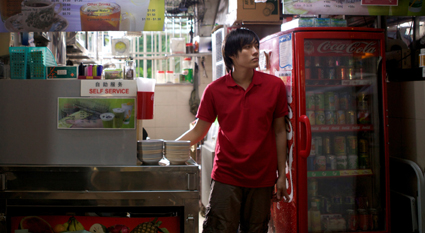
Leo Mak, Tiong Bahru, Civic Life, Singapore, Desperate Optimists (Christine Molloy & Joe Lawlor)
photo Samantha Tio
Leo Mak, Tiong Bahru, Civic Life, Singapore, Desperate Optimists (Christine Molloy & Joe Lawlor)
The UK-Irish pair, Desperate Optimists (Joe Lawlor and Christine Molloy), have taken their widely admired Civic Life project to Singapore, creating Tiong Bahru, a seductive 20-minute 35mm cinemascope film (shot by leading Singaporean cinematographer Daniel Low) featuring citizens as performers in a subtle, un-melodramatic account of the everyday tensions and pleasures in their lives. Tiong Bahru Estate, one of the oldest housing estates in Singapore and well known for its architecture and the excellent food of its hawker centre, provides the film’s focus. With the support of 150 locals, the film centres on the lives of four individuals across the course of a day, each faced with the challenge of change. An older woman treasures her home and community, but is pressured to move elsewhere to live with her family. A young man inherits his father’s coffee shop but invites paternal opposition in wanting to transform it into a tapas bar. A difficult teenager adjusts to a new foster mother. And a young schoolgirl struggling with her homework completes it as a story, realised on screen, of a group of children wondering what they should do when they find an abandoned baby in the food centre’s garden.
The film is accompanied by 19 short films made by locals and a booklet with excellent essays about living in Singapore. Desperate Optimists are visiting Australia with screenings of Tiong Bahru and other works in the Civic Life series in Melbourne at ACMI, in the Sydney Film Festival, at Performance Space and a workshop with ICE in Sydney’s West (see websites for dates and times).
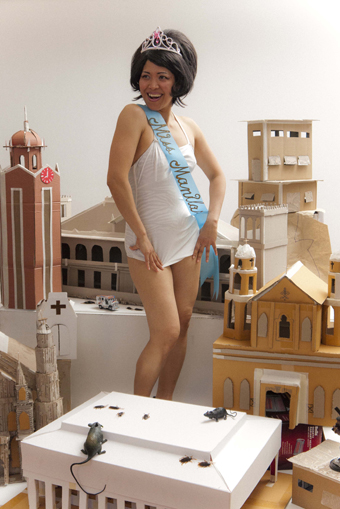
Valerie Berry, Within & Without, Performance Space and Blacktown Arts Centre
photo Datu Arellano
Valerie Berry, Within & Without, Performance Space and Blacktown Arts Centre
Also in Sydney’s West is the Blacktown Arts Centre where, thanks to the inventive creators of The Folding Wife (RT79, p35), you could soon find yourself in Manila: “Audiences [will be] immersed in a physical reproduction of the city…made entirely out of recycled cardboard boxes, shadowplay and surround-sound environments” (press release). Within & Without is the creation of Paschal Daantos Berry and Deborah Pollard in collaboration with Valerie Berry and the Anino Shadowplay Collective from the Philippines. The group’s aim is to explore “how capital cities—through their architecture, mythologies and histories—represent and personify the cultural identity of a nation.” But don’t expect a literal approach to the topic from these performance magicians.
C3 West Projects and Within & Without are just two of a growing number of creative ventures that explore our relationship with cities, suburbs and communities. Campbelltown Arts Centre’s Minto:Live was another fascinating example and more will doubtless emerge as the pressures of urban life demand to be addressed through discussion, planning and the engagement offered by art. RT
The Begin-Again, A C3 West Project, MCA and Hurstville City Council, artist Angelica Mesiti, Hurstville, Sydney April 1-2; Civic Life, Tiong Bahru, various venues Melbourne and Sydney; http://civiclifetiongbahru.com/; www.desperateoptimists.com; Blacktown Arts Centre and Performance Space, Within & Without, installation from June 24, 10am-5pm Tues-Sat, performances June 22-July 2, www.artscentre.blacktown.nsw.gov.au
RealTime issue #103 June-July 2011 pg. 2-3
© RealTime ; for permission to reproduce apply to realtime@realtimearts.net
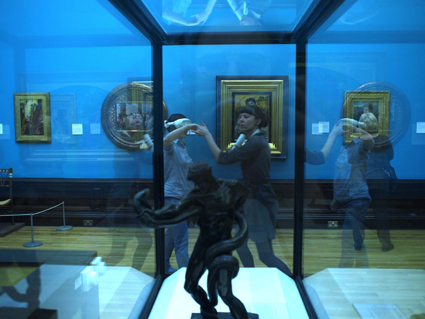
Lundahl & Seitl, Symphony of a Missing Room
photo Christer Lundahl
Lundahl & Seitl, Symphony of a Missing Room
LIVE ART. COLLISION. HYPERLOCAL. SUPERNOW. THESE FOUR CHALLENGES DROVE THE RECENT FIERCE FESTIVAL, A DENSE PROGRAM OF IDEAS THAT INFILTRATED THE CITY OF BIRMINGHAM FOR FIVE DAYS IN MARCH. NEW ARTISTIC DIRECTORS LAURA MCDERMOTT AND HARUN MORRISON’S VISION FOR FIERCE WAS DEEPLY AFFECTING, MOSTLY FOR ITS CLOSE AND CAREFUL CONSIDERATION OF THE FESTIVAL’S RELATIONSHIP TO BIRMINGHAM AS A CITY.
From religion to war, museums to football, architecture, food and micro-local journeys, the program took my hand and gently introduced a place both dirty and profound. A city that—in the words of Andy Field (co-director of the remarkable Forest Fringe)—wears its urban development scars much closer to the surface than other ‘rebranded’ English cities.
March 2011 marked the first Fierce since 2008 and the first without Mark Ball at the helm (Ball is now Artistic Director of the London International Festival of Theatre—LIFT). Like many of their peers around the country, McDermott and Morrison are alumni of Battersea Arts Centre’s extraordinary posse of producers, who establish key collaborations with emerging artists within BAC’s bosom, then go on to present their work in a range of other contexts.
I arrived in Birmingham after a 23-hour flight, one and a half-hour tube ride and two-hour cross-country train. Unshowered, confused and with my eyelids starting to fold inside out, I shared my disorientation on Twitter and immediately received a cheery “Ew! And welcome, see you soon!” from whoever manages Fierce’s account. It was the cheeky first step in unexpected intimacy with the festival’s program and the city of Birmingham itself.
The next morning, eyelids in place, I followed a series of bright yellow ribbons and yellow A4 posters towards the Birmingham Museum and Art Gallery for Lundahl and Seitl’s Symphony of a Missing Room. With “headphone art” becoming increasingly ubiquitous and sometimes just plain lazy, it was exciting to encounter the thorough and considered practice of this research-driven performance art duo. Six of us were led through the museum, observing the typical 19th century oil paintings, apricot walls and creaky polished wood floors. Upstairs, we were each given Sannheiser headphones fitted with a tiny MP3 player, and blindfolded. Robbed of sight for the work’s duration, we were led through the gallery while an audio narrative reimagined our journey as one through forests, castles, small tunnels and finally, a long winding staircase at the top of a castle overlooking a hill. A series of imaginative Catherine Wheels followed, as choreography, instruction and technology combined with the intimacy of a stranger’s gentle hand to lead us on a beautiful physical and imaginative journey. The work’s lyric storytelling managed to completely reinvigorate my relationship with this kind of institution. Blindfolds off and headphones returned, I wandered towards the Museum’s exit viewing its paintings and artefacts anew, with an increased physical agency within what is usually perceived as a space of formality and restriction. Symphony of a Missing Room has also been performed in Sweden and Brussels, each new iteration folding a ‘museum’ of previous imagery into the new site-specific work. It’s the kind of sophisticated and innovative live art for which established institutions should be clamouring.
Leaving the Museum, I wandered through Birmingham’s infamous ‘Bull Ring,’ an absurdly large retail complex hit hard with the Bedazzler. I ducked into Moor Street Train Station and found a wooden box: Quarantine’s The Soldier’s Song. As someone staunchly anti-war, this was an important work for me. Disappearing inside the box, I was greeted by a lone microphone and TV screen with six karaoke songs and six profiles of male and female British soldiers currently serving in Afghanistan. Warrant Officer Shaun Kelvin (North Wales) and I sang “Sweet Home Alabama” together—the whole thing. It was fun and silly, poignant and breathtakingly unique—when had I ever before associated troops in Afghanistan with giggling joy? Soldiers sing and dance and laugh and feel awkward too; why had I never considered that before? Through Warrant Officer Kelvin’s booming baritone and my squeaky soprano, the political became intensely and unforgettably personal.
On to the ‘dirty end’ of Birmingham and a talk by performance artist Eitan Buchalter at the Fierce Festival Hub, VIVID. Buchalter’s practice reframes human behaviour through a performance context, offering reflective space within the flow of crowds who are restricted in choice. During the lead-up to Fierce, Buchalter had observed VIVID’s proximity to St Andrew’s Stadium and that on football days thousands of people overflowed the footpath passing the gallery. In Veer, he set up barriers that channelled crowds away from the street, through an empty gallery and out again (now with a token redeemable for a beer at the pub next door). The vacant nature of the space makes clear that the point of this work is not to confront non-gallery goers with art, but to make the flow of crowds itself the subject of artistic inquiry. Responses to this detour ranged from hesitant to oblivious to cautious to nervous, with some even crossing to the other side of the road to avoid such ‘confrontation.’ Buchalter has an elegant commitment to letting go of ‘where’ his work takes place and acknowledges that his gestures may result in art that exists most potently in people’s memories. Participating in his workshop the next day, we discussed the vital importance of process-based performance art being presented to audiences in a manner as fulfilling as the original unique experience of the artist, rather than re-presented. The challenge of ephemerality—and the curse of unsubtle documentation—is something keenly felt in Australian live art and performance circles. I found Buchalter’s perspective persuasive and insightful.
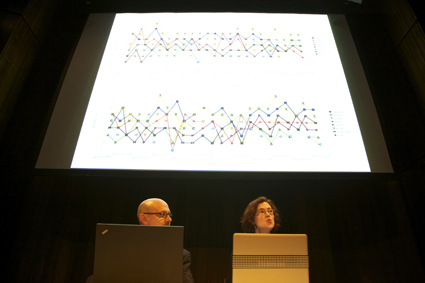
plan b, Narrating Our Lines
photo Briony Campbell
plan b, Narrating Our Lines
Now nearing the end of the day, I jumped into a cab and headed to the Midlands Arts Centre (MAC) for Plan B’s performance-cum-lecture Narrating Our Lines. Sophia New and Daniel Belasco Rogers have geo-tracked their daily movements since 2003. From the birth of their daughter to visiting their favourite cafe, the incidental and the unexpected are gathered and examined for habits, tendencies, moods and prejudices. They shared this intimate practice with 12 residents of Birmingham, creating a living map via donated GPS data. After a long day of walking and thinking, it was terrific to sit and contemplate the constellation of Birmingham’s movements as of Wednesday March 23, contrasting my first steps in this strange city with the hyperfamiliar steps of locals.
So from imagined forests to Afghanistan to the micro-local, a day with Fierce proved instructive and insightful. It revealed how vital a festival experience can be when the artistic direction is passionately dedicated to site and place, showcasing a city’s shiny bits as well as the parts it would rather ignore. I wandered from major government-funded venues to ARIs, from decadent retail strips to industrial bohemia, yet Fierce’s sound artistic choices ensured the experience was consistently joyous, filled with curiosity and love for the diversity of Birmingham and its people. The festival was a lovely example of the extraordinary sense of immersion artistic directors can achieve with a program that’s cohesive and multi-faceted, with good clear signage making the journey between shows as full of character as the works themselves.
Working with an 18-month development period and a relatively small group of artists, as an international arts festival Fierce is miles away from the superficial supermarket approach of some million-dollar arts festivals, where the connection between artist, locality and audience is so presumed, so without consideration or care, as to be lost altogether. Festivals must continue to assert their rationale beyond a marketing guide or catering to a collection of people who came last year. In my own practice and in those that inspire me, there exists an attempt at genuine and specific engagement with artists and the audiences who care enough to pay attention.
With curation charged with humble curiosity for the “hyperlocal” and a dedication to openness and possibility that consistently allowed its artists’ works to exist in the “supernow,” Fierce 2011 impacted deeply on the city it sought to explore, the artists within its embrace and the visitors who witnessed it sparkle.
Fierce Festival, Birmingham, UK, March 22-27, www.wearefierce.org
RealTime issue #103 June-July 2011 pg. 6
© Emily Sexton; for permission to reproduce apply to realtime@realtimearts.net
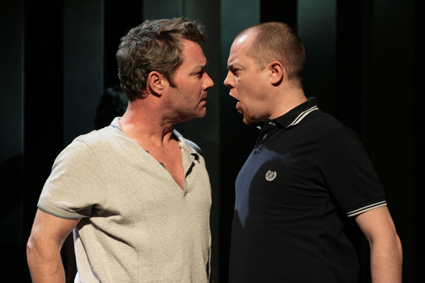
Martie Maguire, Chris Corrigan, Chronicles of Long Kesh
photo courtesy Ten Days on the Island
Martie Maguire, Chris Corrigan, Chronicles of Long Kesh
A BURLY, RUDDY-FACED INMATE STANDS ATOP HIS BED IN HIS SOLITARY CONFINEMENT CELL AND BELLOWS “I’M THE EMM-CEEEEEE, WITH THE PERSONALITEEEEE.” HE GOES ON TO ENCOURAGE HIS FELLOW INMATES OF CELL BLOCK H TO SING, TELL STORIES, TO DO ANYTHING AS LONG AS THEY JOIN HIM ON ‘AIR’ ON HIS RADIO STATION THAT RELIES ONLY ON THE VOLUME OF ANY ONE VOICE AND THE POROSITY OF A CELL. THIS IS OSCAR. HE IS A MEMBER OF THE IRA AND A LONG-TERM INMATE OF LONG KESH AND HE CAN ALSO MAKE A MOTOWN TUNE SPARKLE.
Chronicles of Long Kesh, one of the headline theatre shows of Tasmania’s Ten Days on the Island festival, depicts a 30-year period in the Belfast gaol that began in the early 70s when the British government had the authority to intern offenders without sentence. We are witnessing a scene that takes place as this group of inmates hovers on the edge of an historic and tragic decision to launch a rolling series of hunger strikes as a protest against their mistreatment in this institution.
Seven players working with a minimal set of grey, body-length boxes perform the high energy play by Belfast local and ex-IRA member Martin Lynch. The show offers insight into the tempestuous politics of the period, but its focus is squarely on all of the people involved—the IRA, the Loyalists, the prison guards and the families of these people. In a post-show talk Lynch says, “I wanted to write a play that was true to the people I grew up with.” In doing so, he pulls no punches when it comes to depicting the violence and despair of these years in gaol, where hunger strikes were preceded by years of protest. During this time inmates remained naked except for blankets, in solitary cells plastered with their own shit as gaol management withdrew services such as cleaning in an attempt to stop the protests.
What is most surprising is that Chronicles of Long Kesh is funny, perhaps even delightful, despite the content remaining so difficult to digest. Lynch’s key device to achieve this mood is song. While the prisoners may not have sung Motown tunes as Lynch’s players do, it is stories of the galvanising action of singing and talking that inspired this play. Lynch recalls that his generating idea was hearing that Bobby Sands—the first to die on the hunger strikes—recalled the story of Spartacus for his fellow inmates over a three-week period.
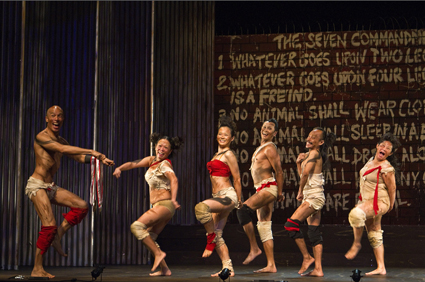
Animal Farm, Wild Rice
photo Albert Lim
Animal Farm, Wild Rice
Another high energy show with a serious intent, Animal Farm, directed by Ivan Heng of Singaporean theatre company Wild Rice, manages to be a quirky mash-up of the book by George Orwell, while remaining faithful to the detail of the text. Like Lynch’s show, the scene is established by the players rather than the set, with much of the action simply performed in front of a full height ‘brick’ wall painted with the imposed rules of “Animalism.” An enthusiastic one-man band plays from a raised platform within the orchestra pit. Dressed in colours that offer a nod towards communism and revolution—red, white and grey—the players create the various farmyard animals with sets of signature gestures that allow them to flip between duck, goose, pigeon, pig, cow and horse. It takes a little time to get used to each of the characteristics and hear the text of the play through the stamps, snorts and wing flutters, but the players are remarkably consistent and convincing in their portrayals.
While I was able to come to terms with Lynch’s infusion of humour into the traumas of Long Kesh (feeling I was witnessing a true coping mechanism among those inmates), I could never quite relax into Heng’s wacky portrayal of Orwell’s text. With schmaltzy tunes such as “Sugar Sugar” by the Archies, slapstick humour and a generous smattering of pop culture references, the show often felt like a pantomime and yet the serious themes persisted. These opposing directions appeared awkward, although I did muse that I may have seen it with different eyes had I the benefit of a more intimate understanding of the complexities of Singaporean culture.
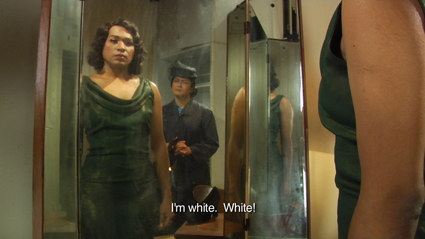
Ming Wong, still from Life of Imitation
courtesy Ming Wong and Ten Days on the Island
Ming Wong, still from Life of Imitation
Ming Wong: Life of Imitation is a show that offers some insight into an aspect of Singapore’s culture. Installed at CAST gallery, the show presents a small section of a much larger exhibition taken to the 2009 Venice Biennale. It incorporates several works by Ming Wong in conjunction with an array of artifacts such as film posters from a golden age of cinema in Singapore through the 1950s and 1960s. The most compelling of Ming Wong’s works is Life of Imitation in which two projections, each paired with a large mirror, face each other across the gallery. The artist has recreated a short, emotional excerpt from the 1959 film entitled Life of Imitation, where the same two female characters are played by a rotating series of cross-dressed male actors collectively representing the country’s multicultural mix. The dialogue in the looped scene between a young mixed-race woman and her estranged black mother reveals the moment when the daughter is caught out in her assumed ruse as a white woman. Ming Wong’s interpretation of this film hints at an aspiration to escape the constraints of one’s cultural heritage or any defined role. Once again, I sit on the outside of cultural understanding, but I feel as though this work offers a small window into the Singaporean psyche.
In keeping with a core commitment of the festival to be a statewide event, several productions were staged in regional areas. Minotaur—The Island, the first in a trilogy by Chamber Made Opera, was performed in the Dennes Point Community Hall on Bruny Island. With rich mythological fodder as a base, David Young and Margaret Cameron’s work is an esoteric take on the story of Ariadne lamenting her abandonment by Theseus, whom she saved from the Minotaur. Wearing a series of handbags as hats, the players work with a minimal set and makeshift percussion to tell Ariadne’s story. Their focus is on spoken word, noise and movement and on improvised instrumental music rather than sung text.
While I don’t believe that any art form should be constrained in its reach, I felt disappointed that the ‘opera’ seemed to have been lost in the making of Minotaur—The Island. Small moments of poetic, sung text by Deborah Kayser (Ariadne) were haunting and beautiful, but they were fragments in a work that felt more like a series of experiments in physical theatre, held together loosely by the landmarks of a well-known story—a red thread, a labyrinth, an island. I don’t think I’m mistaken in gauging that the audience was at best puzzled at the conclusion. A major factor in my disappointment—particularly given the eight-hour adventure required to get to the island location and back—was that the work was performed in a bland community hall, rather than two minutes away on a beach or jetty within extraordinary surrounds that may have added resonance to the story. Given Chamber Made is known for playing with context in their performances staged in private living rooms, the choice of venue seemed an odd and perhaps risk-averse decision.
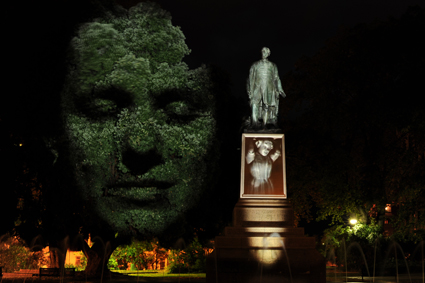
Intension 2011, Craig Walsh (three channel video projection at Franklin Square, Hobart
image courtesy and © the artist
Intension 2011, Craig Walsh (three channel video projection at Franklin Square, Hobart
A free festival highlight was Digital Odyssey by Craig Walsh, a public work developed as part of his Hobart residency. Located at Franklin Square and on the edge of the wharf in Sullivan’s Cove, the artworks brought the space of the tree canopy and the water surface to life using projections. The Franklin Square location was the most successful as large video projections of young faces were cast onto the canopy of several trees surrounding the public space. The mapping of light created the illusion that the trees had been trimmed, or had grown into the shape of the faces and I was not alone in finding it mesmerising to stare into the ‘eyes’ of this silent, blinking and seemingly benevolent vegetation.
There is ongoing talk within the local arts community about the festival and its direction. This year’s Ten Days felt like a series of isolated performances rather than a cohesive, transformative event, which is partly to do with the selection of shows but also the unfortunate circumstance of decreased funding. The Ten Days team, to their credit, has continued to battle on in increasingly difficult financial circumstances, but in light of newer festivals in the state such as MONA FOMA, which has quickly become a summer highlight in Hobart as well as Junction Arts Festival in Launceston, it does seem as though a significant rethink is needed. Perhaps we don’t need a statewide festival any more. Perhaps a permanent theme of ‘islands’ is limiting to potential content. And maybe one reason why we all love MONA FOMA so much is that it’s a festival that is not tangled up in defining Tasmania’s identity or battling with the impression of being the poorer cousin to Melbourne or Sydney, yet in the act of ignoring these issues positively contributes to the redefinition of this place.
Chronicles of Long Kesh, writer Martin Lynch, directors Lisa May, Martin Lynch, musical director Paul Boyd, Green Shoot Productions, Hobart Theatre Royal, March 30-April 3; Wild Rice, Animal Farm, director, designer, choreography Ivan Heng, George Orwell’s novel adapted by Ian Wooldridge, composer Philip Tan, Hobart Theatre Royal, March 25-29; Ming Wong Life of Imitation, artist Ming Wong, curator Tang Fu Kuen, Contemporary Art Spaces Tasmania (CAST), March 24-April 24; Chamber Made Opera, Minotaur—The Island, composer David Young, writer, director Margaret Cameron; Digital Odyssey, artist Craig Walsh; Ten Days on the Island, Tasmania, March 25-April 3
RealTime issue #103 June-July 2011 pg. 8
© Judith Abell; for permission to reproduce apply to realtime@realtimearts.net
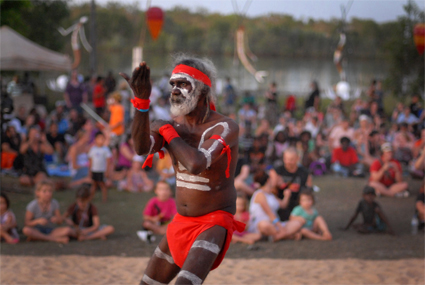
dancer with David Dingala’s group from Groote Eylandt, Mahbilil Festival
photo Dominic O’Brien
dancer with David Dingala’s group from Groote Eylandt, Mahbilil Festival
DIRECTOR AND PRODUCER ANDRISH SAINT-CLARE HAS MADE JABIRU’S MAHBILIL FESTIVAL A DISTINCTIVE CULTURAL EVENT IN THE NORTHERN TERRITORY, WITH ITS INNOVATIVE INSTALLATIONS, PERFORMANCES AND FAMILY-ORIENTED APPEAL. FOR 2011 HE’S BEEN INVITED TO BE ARTISTIC DIRECTOR OF THE FAMOUS GARMA FESTIVAL AS WELL, A QUITE DIFFERENT EVENT BUT WITH SOME IMPORTANT SHARED PRIORITIES, NOT LEAST FOR YOUNG INDIGENOUS ARTISTS. I ASKED SAINT-CLARE ABOUT HIS BACKGROUND AND HIS APPROACH TO EACH OF THE FESTIVALS.
What is your background as an artist and producer?
My mother collected and illustrated folk songs and tales when I was a small child and also forced me to study the cello, which I got good at. Later after the difficult years as a dislocated and deprived teenager looking for an Australian identity, I started to meet and work with artists, musicians, filmmakers and became a member of a seminal theatre group, The Performance Syndicate, led by Rex Cramphorn which was devoted to realising a new performance language that paid homage to our Asian geography.
This early period involved various excursions from Khatakali to Kabuki to Martha Graham, writing for radio, learning film editing at ABC TV, composing on an Atari and tutoring for NAISDA, doing all manner of things as an arts worker and performer. Then after abandoning the arts for a decade or more I was invited back to compose for a ballet by Kim Walker about the life of Aboriginal opera singer Harold Blair.
A couple of years later I decided to abandon city life and settled in the Northern Territory and spent a lot of my time in remote communities creating and devising performance works with the people there. On Elcho Island I found an opportunity to create a work about the contact history of Yolngu people from North East Arnhem Land and the so called Macassans from the island of Sulawesi in the eastern Indonesian archipelago. The resulting large-scale stage work Trepang was widely appreciated and has been written up in various books and articles.
Trepang was followed up by another large live performance work for the stage called Fire Fire Burning Bright about a massacre of Aboriginal people in the Kimberleys around the closing stages of the First World War. The work was performed by Gija and Mirrawong speaking people at the Quarry for the Perth International Arts Festival and at the Arts Centre’s State Theatre for the Melbourne International Arts Festival.
After this period, finding it increasingly difficult to raise funds for large stage work, I found myself more and more involved with community cultural development projects including producing festivals.
Why your particular and enduring engagement with Indigenous cultures?
I have a refugee background and had considerable racist experience when I first arrived in Australia as a child. This continued in lesser ways of discrimination for many years and added to this were the very distressing stories my mother related to me about the war years in eastern Europe, which included the murder of several relatives and the scattering and dispossession of my family. All this led me to have great sympathy for the lot of Aboriginal people when I finally met and made friends with some as a young adult.
From these roots and the sometimes lengthy travels I undertook to places in South America, North Africa and Indonesia set me on the road to a fascination with Indigenous people and cultural studies. Of course, as one matures and illusions dissipate, it becomes untenable to apply attitudes of ‘study’ to the many Indigenous people who have become personal friends and family.
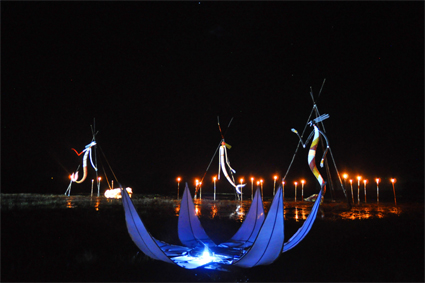
Yawk Yawk figures by Techy Masero after bark paintings of local totem figures. Lotuses by Conor Fox open to release illuminated balloons
photo Dominic O’Brien
Yawk Yawk figures by Techy Masero after bark paintings of local totem figures. Lotuses by Conor Fox open to release illuminated balloons
How long have you been working with the Mahbilil Festival and what is its particular character and appeal?
Originally I was asked to do a cultural mapping of the area around Jabiru by a mining company looking to develop small business with Bininj people in 2004, but ended up being asked to take over the Jabiru Wind Festival by Gundjeihmi Aboriginal Corporation and change it to a more Indigenous event, which I did successfully. In 2009 I was again invited back to reverse a slide in the quality and direction of the festival and again made it largely about local and regional Indigenous culture with a youth focus.
Having worked on a number of regional festivals I generally look for what is unique in local characteristics and resources. Jabiru is a mining town with a mixed population of Indigenous and multicultural backgrounds so I thought it would be good to reflect this diversity, something that is rare in the remote and regional festivals of the Northern Territory. The town is also situated in the midst of a vast wetland full of birds, buffalo, barramundi and so forth, so we have instituted a magpie goose cooking competition for instance, judged by chefs from Cooinda and the Gagaju Crocodile Hotel. Magpie geese are delicious to eat and there is no place else in Australia really that you can get a taste of this bird. We also feature large earth oven cuisine where buffalo is cooked in maleluca bark and spiced with local native herbs.
The festival site is also in a park next to a lake, so on a laid back family afternoon you can eat, shop for artefacts, watch Aboriginal artists weaving and painting and let your kids go on free water slides and dodgem cars and enter spear throwing and didgeridoo blowing competitions. Then you can marvel at the magical installations on the water in the fading sunset.
This part of the festival is all about art and multimedia. The installations are based on local Indigenous mythological figures, the use of which has been approved by the local elders and are interwoven with soundscapes and, when possible, traditional dance. In 2009 we created large, illuminated mobile puppets mounted on boats that appeared like creatures from another world. Last year we installed five-metre tall Yawk Yawk figures, the Bininj “mermaids” on the lake. These were surrounded by gigantic lotus buds that opened to reveal illuminated balloons that floated up into the starry darkness like mermaid eggs.
The final part of the festival is devoted to the concert stage. Here we have all manner of bands from Indigenous groups such as Narbalek to funk and rock from the night spots of Darwin interleaved with dance performances that have included Maori poi, Balinese, Congolese, traditional performance from Groote Eylandt, Oenpelli and hip hop. Simply put, the festival caters to family, art and entertainment with a broad, eclectic programming mostly absent from the other festivals.
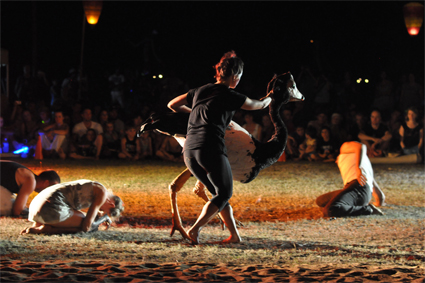
Gary Lang’s group, Goose Lagoon
photo Dominic O’Brien
Gary Lang’s group, Goose Lagoon
What do you feel you’ve achieved with Mahbilil?
Mahbilil is devoted to winning hearts and minds in the town and celebrating our communality. The festival has certainly achieved this and virtually everyone living there comes out to enjoy the sights and activities. Local attendance has also increased since we discontinued alcohol being served on site. We also have an increasing number of visitors to the extent that you have to book way ahead for accommodation in the town.
Beyond this, the festival is about showcasing what is going on, especially for children and youth. The Kakadu Youth Centre for example runs many after-school workshops where the young learn to make videos, train in music, songwriting, dance, gymnastics and various other arts and crafts. There are also extensive collaborations with the Jabiru Area School that tend to go into overdrive a few weeks before the festival. By now I feel that we have achieved a unique festival that is contributing cohesion and pride to the life of the town. For the first time last year we were asked to expand the festival with sporting events and we’re working on a parade, which will hopefully display floats and marching groups contributed by the organisations and businesses in the region.
Garma is already well defined, not least as an ideas and issues festival. How did you come to it and what do you wish to do with it in terms of continuity and new directions, if any?
There was nothing special about how I came to Garma. In early 2010 there was a change of administration at the Yothu Yindi Foundation, which runs Garma under the guidance of a Yolngu steering committee. I was asked if I wanted to direct the festival. I said no straight away, as I didn’t think I had enough time available to do the amount of work it would take and I was also uncomfortable with the idea that a non-Indigenous person should be the director, even though there had never been an Indigenous director before. I could not think of a Yolngu who had the training, experience or willingness to take it on, so I recommended Rhoda Roberts, whose Dreaming Festival I had attended a couple of times. A short while later I was rung again and asked if I could handle producing some part of the festival at least and I ended up agreeing to do the Bunggul, the traditional performance section, which was put on every afternoon. I basically accepted because I had been working with Bininj in central Arnhem Land for the past two years and this was an opportunity to get back together with my Yolngu friends and do things together. As well, Rhoda’s production team were all southerners, so they had no one else who knew the elders in the various communities to negotiate with to bring their teams to Garma.
Early this year, things had moved on again and I was asked to be the artistic director, as well as carry out many of the other directorial jobs. I thought that within the steering committee’s guidelines I could perhaps try to change a few small things in the proven formula and provide a situation which might be both more supportive of local talent while being more open to presenting contemporary culture from the Yolngu communities. I was also aware from many of my younger colleagues ‘down south’ that Garma was unknown to most of their generation, yet here it is, the most significant Indigenous festival in Australia.
As you say, Garma programming has been well defined for a dozen years, so it is not something which can be easily toyed with. Many important people from traditional leaders to industrialists to politicians and academics attend the key forum lectures and discussions, nor are the exhibitions and performance-oriented activities devoid of representational significance or statement of values and status. There are however gradual steps which need to be taken to keep proceedings open to voices and influences that maintain currency as well as cultural integrity.
Garma is essentially an Indigenous bush festival, not a pop extravaganza. We do not strive to showcase established and well-publicised artists, but find it more valuable to present incredible talents found in the communities who may not have had the advantages of promotional opportunities found in cities. There are sweet and powerful singers as good as any in the city and these may be seen at the 2011 Garma Festival. What is more, we are negotiating a deeper and more extensive set of Bunggul or ceremonial dance performances than perhaps anywhere in Australia.
Finally we have also identified some extra time in the daily regime allowing for the presentation of contemporary performances that combine traditional dance with, for instance, a contemporary band rendition of manikay or song. This is the living culture that youth are experimenting with in their communities. They get almost no government support and the commercial world is thousands of kilometres away, so Garma is one of the rare opportunities for them to reveal their work.
Garma Festival, North-East Arnhem Land, Aug 5-8, www.garmafestival.com.au; Mahbilil Festival, Jabiru, Kakadu National Park, Northern Territory, Sept 10
RealTime issue #103 June-July 2011 pg. 10
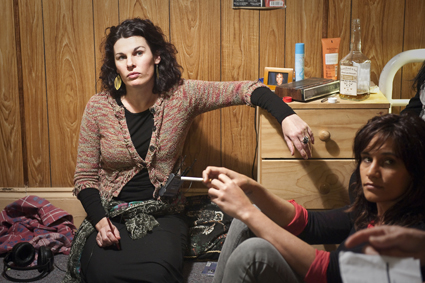
Beck Cole on the set of Her I Am with Shai Pittman
photo Sam Oster
Beck Cole on the set of Her I Am with Shai Pittman
CINEMATIC REPRESENTATIONS OF INDIGENOUS LIFE OFTEN SEEM TO DWELL UPON THE TRAGIC ASPECTS OF THE PAST, THE OVERPOWERING WEIGHT OF A TRAUMATIC HISTORY OBSCURING ONGOING EFFORTS TO IMPROVE LIFE IN THE PRESENT. WHILE POWERFUL AND CONFRONTING FILMS HAVE BEEN MADE ON THE ONGOING DISINTEGRATION OF INDIGENOUS CULTURES IN REMOTE AREAS, STORIES DEALING WITH THE EXPERIENCES OF INDIGENOUS PEOPLE IN URBAN AREAS ARE RARELY, IF EVER, TOLD. WITH HER DEBUT FEATURE HERE I AM, WRITER-DIRECTOR BECK COLE HAS BROKEN THIS MOULD, CONSTRUCTING A QUIETLY ENGROSSING PORTRAIT OF CITY LIFE FOR INDIGENOUS WOMEN IN CONTEMPORARY AUSTRALIA THAT IS IMBUED WITH GENTLE HUMOUR AND A THOUGHTFUL AND UNASSUMING OPTIMISM.
Here I Am follows the struggles of Karen Burden (Shai Pittman) in her attempts to turn her life around on being released from prison. Desperate to regain custody of her young daughter Rosie (Quinaiha Scott) from her unforgiving mother Lois (Marcia Langton) while persuading the authorities that she’s put her drug-addled past behind her, Karen enters a women’s shelter run by the formidable Big Red (Vanessa Worrall), settling into the emotional hard work of straightening out her life.
Working from her own script, Cole’s film illuminates the reality of a “fairly common experience” through a simple but effective naturalistic style that allows her to lay bare the human story behind the statistics. “Karen comes from me really,” she says, “my experience and what concerns me and the things that I think Aboriginal women experience…There is a disproportionate number of Indigenous women in prison in this country, that’s a fact…You’re making a film that you hope will engage an audience, because everyone’s got a mother, most people are parents at some point in their lives, so it’s dealing with universal themes. But it is also taking you into a world where you (probably) haven’t been before, one that really exists.”
In this film, Beck Cole draws on her experience making documentaries—her previous work includes Making Samson & Delilah (2009) as well as the brilliant SBS series First Australians (2008) with Rachel Perkins—and the half-hour drama Plains Empty (2005), which also followed the experiences of a lone woman. Cole shot Here I Am on location in the “familiar territory” of Port Adelaide (her upbringing being punctuated by regular moves between Alice Springs and South Australia) to lend the film an inimitable aura of realism. “We were in that world all the time,” she comments, “it was a really good grounding, a reality check, to be making a story amongst it…we were really welcome there. [Adelaide’s] like a big country town, really laid back.”
Immaculately shot amongst cheap motels, decaying industrial infrastructure and cigarette-butt littered streets by director of photography (and Cole’s husband) Warwick Thornton, Here I Am is grounded by an extraordinary performance from Shai Pittman, who approached her task with similar energy and persistence to her director. “I love doing this style of work,” she enthuses. “I suppose being an actor you’ve got to be quite open to diverse, different people…Karen was really easy to relate to. There were times when I just thought, okay, this is a test…[but] I did it all, never questioned it.” Says Cole, “Shai was completely and utterly fearless.”
Karen’s story plays out against the backdrop of the women’s shelter, the makeshift camaraderie among the residents leavening the desolation that continually threatens to overwhelm her. As Cole notes, “it’s important to have a laugh in dire situations.” As well as giving roles to theatre veterans Betty Sumner and Pauline Whyman, Cole drew on predominantly Indigenous, non-professional actors from the local community in casting the supporting roles, their efforts adding to the film’s raw honesty. “I like to try and find the heart in people, get them to express that,” explains Cole, “but when you’re putting words in their mouths you’re dealing with something else, it’s a different scenario…It was challenging, and I think it’s just something that you’ve got to embrace and look for those little quirky moments…That’s what I like. I think you can tell when there’s that essence of that person’s heart in that moment on screen.”
Indeed, the roles of many of the institutional figures encountered by Karen—her parole officer, a job-seeking coordinator, a child welfare officer—are played by Indigenous women who hold similar positions off-screen, a decision that Cole believes reflects an encouraging trend in reality. “I’ve got loads of friends who work in those sorts of jobs…Women are in these jobs, right across the country. I think it’s a statement about employment, a statement about taking control of your own destiny and getting to change things for the better—you’ve gotta get in there and work from within. It’s not rocket science.”
Which doesn’t mean it’s easy. Against Pittman’s smudged and battered Karen, Cole sets the stony and unrelenting figure of Lois, who has achieved a position of stability through hard, repetitive but essentially restorative labour—she is employed, significantly, as a cleaner. Langton, a renowned academic and social activist, was by all accounts an inspiration on set, reading Senate Notes between takes—when not on Facebook. “She’s very strong,” says Pittman. “She reminds me of Indigenous mothers and grandmothers these days [who are] just like her; she’s strong like that. It was just like having my grandmother on set, or my mum.”
Much of the emotional power of the film comes from the ultimate reassertion of Karen’s individual dignity and sense of self-worth against the contemptuous judgement of her mother and society at large. In a remarkable scene towards the end of the film, she takes a shower, a simple symbolic act shot with uncomplicated grace. “I reckon you can forgive,” Cole muses, “…[but] the thing that is really hard to shake is shame…When I was thinking about Karen I was thinking: how do you get over the shame of neglecting a child? Because that is mega-shame. How do you forgive yourself for that? You can’t, all you can do is try to forget it—and you can’t do that either…It’s a hard question.”
A willingness to confront hard questions seems to lie at the heart of Cole’s filmmaking. As with other contemporary Indigenous filmmakers such as Ivan Sen (Beneath Clouds and more recently Toomelah) or Thornton (Samson & Delilah), Cole has received immense support from the Indigenous Branch of Screen Australia who recognise the importance of talented Indigenous storytellers sharing their stories. “I think there’s…an important place for films like [Rolf de Heer’s] The Tracker (2002) and others,” says Cole, “the more the merrier—the history of this country being told from all its perspectives is an important thing. But the reason why there’s a lot of support for films made by Aboriginal people about Aboriginal people has been largely I think due to a commitment by Screen Australia and its Indigenous Branch… it’s been strategic I think, and it’s great that there’s been such a high calibre of films released. It’s no longer this bullshit ooga-booga blackfella sort of stuff. These are stories that audiences can sink their teeth into and enjoy. That’s all you want for someone who’s paying 15 bucks to see a film…Now there’s more of a push to get the next group of people through, to keep this momentum up. It’s an exciting time to be a filmmaker in this country—particularly an Aboriginal one.”
Here I Am, writer, director Beck Cole, director of photography Warwick Thornton, producer Kath Shelper, Scarlett Pictures, 91mins, 2011
RealTime issue #103 June-July 2011 pg. 13
© Oliver Downes; for permission to reproduce apply to realtime@realtimearts.net
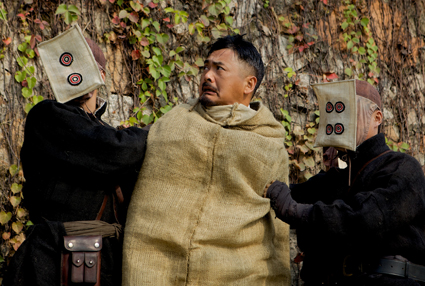
Let the Bullets Fly
AT THE FILMART MARKET THAT ACCOMPANIES THE HONG KONG INTERNATIONAL FILM FESTIVAL (HKIFF), THIS YEAR THE TALK WAS ALL OF THE RISE OF CHINESE CINEMA AND WHETHER WE WERE SEEING A GOLDEN AGE. THE IMMEDIATE RESPONSE TO THIS QUESTION WAS A RESOUNDING YES, WITH THE BOX OFFICE ROCKETING PAST 10 BILLION RENMINBI ($A1.45B) AND A RECORD NUMBER OF FILMS PRODUCED LAST YEAR.
This represents hefty growth, but the longer the panellists tried to talk up China, the more the doubts started to emerge. China’s box office still doesn’t represent such a great advance on Australia’s $1.1 billion, and it seems there are only 20 million active cinema-goers in China. Other revenue sources such as video, television and the internet remain sadly underdeveloped and, worst yet, of the 536 films made in China last year, only 100 got any kind of distribution. While Chinese films still have almost 60% of their domestic market, this is attributable to a handful of blockbusters.
A lot of films are being made throughout East Asia right now. The most interesting are shot cheaply on digital video, sometimes with seed money from the promotional events that accompany Asian festivals. They go largely unseen within China and the industry folk at FilMart have little interest in them. One of the few places where they mingle is at HKIFF, so it seems an ideal place to sample developments on either side of the Chinese cinema chasm and also to consider the middle ground.
let the bullets fly
The biggest recent hit in Chinese cinema is Jiang Wen’s Let the Bullets Fly (2010). This is a remarkable and welcome development, not only because it is a pretty good movie but also because Jiang has shown himself to be a fine filmmaker, one whose last film, The Sun Also Rises, wilfully embraced all the obscurities of art cinema.
The new film is set during the 1920s, a transitional period when China was struggling to move from peasantry to modernity. It is flush with two-fisted automatic pistol action and flashy CGI effects, but succeeds in using digital effects for something more than just spectacle. In fact, spectacle is held in check for moments of flourish, while character interaction is still the main driver. Jiang plays a bandit who starts out simply wanting to make a fortune and ends up achieving something more. There are some clear analogies to the spaghetti western here. The film is a poker game between Jiang and an urbane warlord played by Chow Yun-Fat—two smiling antagonists learning mutual respect even while each plots to kill the other. This battle of wits is all macho co-operation on the surface and simmering animosity beneath it. Somehow, China will take a step forward out of this confrontation, though each of the protagonists will be left behind.
Devils on the Doorstep (2000) showed Jiang to be a fabulous stylist and this latest film demonstrates a confidence and storytelling finesse. It is one of those rare instances where a blockbuster can capture a mass audience’s respect for pleasurable innovation. Significantly, it marks a step away from the overblown, period martial arts fantasies which have weighed down big budget Chinese production for a decade now.
old dog
On the other side of the divide is Old Dog, a cheap, digital feature from Tibetan Pema Tsuden. The story is of a Tibetan mastiff owned by an old man. These dogs are in demand by Chinese businessmen and the old sheepherder is besieged with offers to sell before the dog is stolen. Of course, this is all open to interpretation as an allegory of Tibet’s situation in relation to the Han Chinese. Tibetan culture can provide no place of respite from the demands of the Chinese.
On the other hand, we can also see the dog as simply a dog. There is a resolute refusal to take the easy option by allegorising or sentimentalising the story. The dog is the item of exchange that keeps the narrative going, but it has no name and is never touched or spoken to by its master. Things rarely need to be spoken in this film. One scene is shared between a father and his son who has just been arrested. They say hardly anything but pass a lighter back and forth with an eloquence that speaks loudly.
There is also a lot of spare time in the film: time to show guys playing pool in the street, time to show a herd of cattle pass by. One memorable shot is sustained so that we can watch a sheep stuck on one side of a fence try to get through to rejoin the flock.
Narratives are like bags—you can put a lot of things in them. Pema’s bag has a lot of space in it for wonderful things. The camera is kept back from the action, not to distance you from the characters in the style of Hou Hsiao-Hsien, but to place the characters in their environment. Part of the project of the film is simply to show you what small Tibetan towns are these days, with their mixture of wide, muddy, rubble-strewn streets and cloud-adorned mountains; where trucks and motorcycles share the streets with goats and cattle.
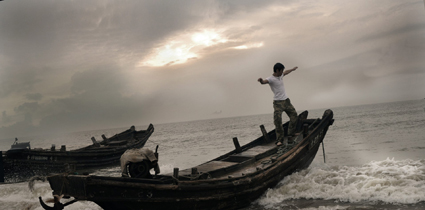
Chongqing Blues
chongqing blues
To be stuck in the middle of the Chinese cinema is an uncomfortable place. Dan Edwards’ accompanying HKIFF piece (p15) touches on the ungainly way that Jia Zhangke is trying to scramble across the divide. A few years ago Wang Xiaoshuai, director of Beijing Bicycle (2000), was grouped together with Jia as one of the key figures of the so-called Sixth Generation. So what if the Fifth Generation was largely a marketing device and that the 6G tag never took off as a label in the broad post-Tiananmen territory of low budget grunge in which filmmakers who were never going to be accepted by the Party made China look like hell on earth.
Fifteen years on, this miserabilist orthodoxy has run out of steam, Wang is no longer a cutting edge figure, but he has a new film, Chongqing Blues (2010). He isn’t a particularly distinctive stylist or social critic, but he is still a solid filmmaker. The film is dominated by Wang Xueqi’s fine, understated performance as Lin, a middle-aged sea captain returning after an absence of 15 years to make peace with his past. The sailor is home from the sea because his estranged son, who hates but loves his absent father, has been gunned down in a hostage-taking standoff.
Like many recent Chinese films, this one addresses the generational gulf in China. Lin shares the problems of millions of migrant workers who have left their families to earn a living, only to find that they have to learn how to be fathers on their return. Wang follows the action in longish handheld takes as the father wanders a city he barely recognises. His son’s crime and death grow out of the way that Chinese youth is poised on a knife-edge between aimlessness and the lure of spurious success.
An epilogue: my HKIFF ended on a strange note with a visit to the HK Film Archive for a screening of the Australian National Film and Sound Archive’s restoration of The Man from Hong Kong (1975). Coming so soon after Mario Andreacchio’s Dragon Pearl and the formation of an Australia-China Film Alliance to try to attach Australian cinema to the coat-tails of the Chinese market, Brian Trenchard-Smith’s delirious mixture of popular film elements seemed especially poignant as a road not taken, and as a nostalgic remembrance of action genre traditions in Australia and Hong Kong that are now, alas, dead. The film is a reminder that there was a brief moment when Australian and Chinese film cultures briefly touched and that bringing them back into alignment remains an elusive quest.
[The renminbi (literally people’s currency ) or the yuan is the official currency in the mainland of the People’s Republic of China. Eds]
Hong Kong International Film Festival, March 20-April 5, 2011, www.hkiff.org.hk
RealTime issue #103 June-July 2011 pg. 14
© Mike Walsh; for permission to reproduce apply to realtime@realtimearts.net
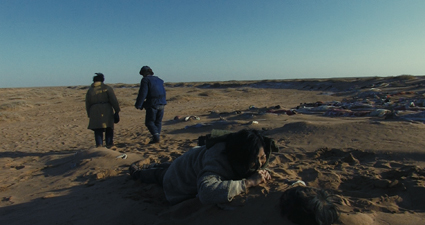
The Ditch
HONG KONG’S INTERNATIONAL FILM FESTIVAL EMBODIES ALL THE STRANGE CONTRADICTIONS UNDERLYING CHINA’S DIVIDED CONTEMPORARY CULTURE. ON THE ONE HAND THE CHINESE STATE HELPS PROP UP A FILM INDUSTRY BOOMING IN TERMS OF CINEMA NUMBERS AND BOX OFFICE SALES. ON THE OTHER HAND SOME OF THE NATION’S MOST TALENTED AND POPULAR FILMMAKERS SEE THEIR WORKS DELIBERATELY SHUNTED INTO QUIET SEASONS—JIANG WEN’S LET THE BULLETS FLY (2010) SPRINGS TO MIND, (P14)—TO LEAVE HOLIDAY SEASONS CLEAR FOR SAFER, VACUOUS HISTORICAL BLOCKBUSTERS OR OVERT PROPAGANDA LIKE FOUNDING OF A REPUBLIC (2009; RT94, P21).
Other key contemporary directors like Wang Bing are barely known on the mainland, their films not permitted in cinemas or on television. Only in Hong Kong—a part of China, yet culturally quarantined from the mainland—can these films rub shoulders, providing some kind of rounded picture of what’s happening in Chinese cinema.
the ditch
No title at Hong Kong this year highlighted the divide between China’s official and unofficial sectors more starkly than Wang Bing’s The Ditch (2010). While many Chinese features since the 1980s have touched on the suffering inflicted by Mao’s endless mass political campaigns, few have been so brutally raw in their depiction of the Maoist era. Wang emerged from China’s independent documentary sector in 2003 with his nine-hour epic West of the Tracks, about the closure and decay of a massive socialist industrial complex in China’s northeast. His documentary roots are in evidence in The Ditch, an unembellished realist drama based on Wang’s interviews with survivors of Mao’s labour camps.
The film opens with the arrival of prisoners in a vast desert landscape, which appears empty until the men are assigned beds in caves dug into the desert floor. This is the Gobi in China’s northwest, where thousands were exiled after taking up Mao’s invitation to speak out about societal problems in the Hundred Flowers Campaign of 1957. The severity of their desert plight was compounded by the food shortages that swept China in the wake of the botched Great Leap Forward. Wang disturbingly evokes the desperation of men on the edge of starvation, consuming roots they know will poison them and finally resorting to eating the corpses of fellow inmates.
This bleak tale plays out in long shots, the men only vaguely differentiated from each other as the indignities of prison camp life take their toll. They are dwarfed and ironically imprisoned by their wide open desert surrounds, adrift in a world utterly divorced from the urban environments they have come from. Wang shadows his characters in long tracking shots evoking the ghostly presence of the dead littering the landscape outside the caves. Every frame of this movie feels haunted—by hunger, death and the knowledge that the Chinese authorities have attempted to erase this history from the nation’s consciousness.
bachelor mountain
Yu Guangyi’s documentary treads more familiar ground, presenting a subtle portrait of the pressures placed on rural areas by China’s city-centric mode of development. In the country’s far northeast a logging community ekes out an existence in a harsh landscape now largely bereft of timber. Most of the local women have left for the promise of a better life in the cities.
We meet San Liangzi, a 46-year-old laid off worker, one of those left behind in this isolated community without money, a steady job or a wife. For a decade he has nursed a crush on Wang Weizi, a forthright woman more than 15 years his junior who runs a small inn, pursuing the tourist dollar with a single-minded determination. She also appears to be gay, a fact that does nothing to dampen her suitor’s obsession. During tourist seasons, he quietly tramps over to Wang’s inn every night, labouring without recompense as visiting urban tour groups indulge in hedonistic rituals of dancing and drinking around him.
Yu’s film is resolutely non-judgmental and handles San’s gentle, lumbering personality with tenderness. At one level the documentary is a study of quiet personal obsession, but we are also left to ponder the personal and social distortions created by economic circumstances that have left the mountain stripped of trees, the local community without young women, and men like San stranded with virtually no hope of a steady income or family life in their hometowns.
yulu
Jia Zhangke is one of the few filmmakers who has successfully straddled the divide between the commercial and independent industries in China in recent years, continuing to produce astute, innovative films since he began submitting his work for approval—and official mainland release—in 2004. His involving documentary, I Wish I Knew (2010; RT99, p17) appeared at HKIFF this year alongside the more recent project, Yulu.
It’s perhaps unfair to describe Yulu as a “Jia Zhangke film,” since he produced the work, which actually comprises a dozen or so short documentaries by seven different directors profiling “up-and-coming figures who the younger generation can easily identify with,” to quote the festival program. Jia directs the opening and closing segments, both of which unfortunately exemplify the film’s problems.
Jia’s opening portrait of Cao Fei, an entrepreneur who has created a groceries shopping website, is characterised by the lack of probing insight that runs throughout Yulu, reducing some of the episodes to the tone of a motivational video. The uncritical celebration of a “can-do attitude” becomes most problematic in the final segment—again directed by Jia Zhangke–on Pan Shiyi, Chairman of SOHO China, the developers who famously constructed a series of vast residential-commercial complexes around Beijing. Unsubtle attempts to ‘modernise’ the face of major Chinese cities have seen hundreds of thousands of people forcibly thrown out of their homes across the country, often with little or no compensation—a process that has greatly enriched developers and many government officials. Admittedly, SOHO’s complexes have largely been built on former industrial sites rather than residential zones, but like all such developments they have involved the commercialisation of land supposedly held by ‘the people’ under the socialist system, with the proceeds pocketed by officials. Jia’s uncritical celebration of a figure who has amassed immense wealth through this process is somewhat puzzling, given the attention his previous works have paid to China’s disenfranchised.
Other segments offered more interesting subjects, such as Chen Tao’s profile of the blind folk singer Zhou Yu and the AIDS charity worker Zhang Ying. Wei Tie presented a moving snapshot of Zhao Zhang, founder of the environmental NGO Green Camel Bell, while the strongest segment was Tan Chui Mui’s profile of investigative journalist Wang Keqin. Most of the episodes, however, suffered from the same lack of depth that plagued Jia’s contributions.
In the post-screening Q&A, an audience member pointedly asked if the film’s upbeat tone and theme of striding confidently forward were inspired by the walking figure of the Johnnie Walker logo. The liquor firm was the film’s principal sponsor.
a divided culture
If none of the Chinese documentaries at HKIFF this year had the power of last year’s Petition (2009; RT97, p16), Wang Bing’s drama The Ditch demonstrates the independent sector’s ongoing interest in unearthing China’s buried stories—and the cinematic power of these hidden tales. Meanwhile Jia Zhangke’s Yulu did nothing to combat perceptions that political and market pressures often work hand in glove to dilute directors’ critical prowess. While most of the Chinese films at HKIFF in 2011 fell somewhere between these two poles, the selection illustrated that for all the liberalisation of China’s cultural sphere in recent decades, there remains a sharp divide between what can and can’t be shown in official mainland content, reinforcing the unfortunate truth that much of the population remains ‘shielded’ from the nation’s most incisive film products.
35th Hong Kong International Film Festival, various venues, Hong Kong, March 20-April 5, www.hkiff.org.hk
RealTime issue #103 June-July 2011 pg. 15
© Dan Edwards; for permission to reproduce apply to realtime@realtimearts.net
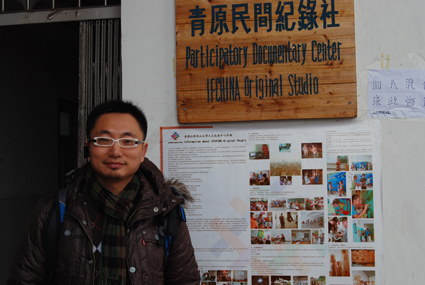
IFChina Studio founder and filmmaker Jian Yi, outside the studio on the campus of Jinggangshan University
JI’AN DOESN’T LOOK LIKE THE MOST AUSPICIOUS PLACE FOR A GROUNDBREAKING EXPERIMENT IN CHINA’S BUDDING CIVIL SOCIETY. THE TOWN DOESN’T APPEAR IN ANY ENGLISH LANGUAGE GUIDEBOOKS, THE LOCAL STATION PLATFORM IS JUST A LOW-SLUNG SLAB OF CONCRETE AND, IN EARLY SPRING WHEN I VISITED, A BONE CHILLING MIST HUNG OVER THE TOWN. YET THIS MINOR CHINESE CITY IS HOME TO IFCHINA ORIGINAL STUDIO, A BOLD ATTEMPT TO GENERATE COMMUNITY PARTICIPATION IN THE ARTS AND ORAL HISTORY IN THE HEART OF ONE OF CHINA’S POOREST REGIONS.
hidden stories
“We wanted to start with oral history because this place is so special—the Chinese revolution under Mao Zedong started here,” explains Jian Yi, a gently spoken local filmmaker whose credits include the documentary Super, Girls (2007). Jian Yi founded IFChina Original Studio with his wife Eva in 2009 on the campus of Jinggangshan University. Their activities include theatre classes, video workshops and photography programs, all built on an oral history foundation.
In a nation where history is always highly contested and politicised terrain, IFChina’s attempts to record personalised stories from China’s recent past and incorporate these into theatre and film projects is not only brave—it’s virtually unprecedented. “We are really doing groundbreaking work,” Jian Yi acknowledges. “We are facing an audience with zero literacy about documentaries and narrative films…many people who come to our screenings say, ‘That was the first documentary I ever saw’.”
Despite being a minor city, Ji’an provides fertile ground for a documentary maker looking to generate community interest in oral history. The remnants of the Chinese Communist Party fled to this area after thousands of members were massacred by Chiang Kai-shek’s forces in Shanghai in 1927, an incident that led to a fundamental shift in the previously urban-based party. As Mao Zedong rose to the fore with his vision of an agrarian-based revolution, the Communists regrouped and declared a Chinese Soviet Republic just south of Ji’an, a region they controlled until 1934, when encirclement forced them to embark on their “long march” to northwest China.
Since founding IFChina Original Studio, Jian Yi has been working with locals—mostly students from Jinggangshan University—to capture this history before it vanishes with only official accounts remaining that leave much unsaid. He cites a story from a 97-year-old local as an example of the tales they have uncovered: “This guy told a story of how his sister tried to get back the body of her husband, one of two men ‘wrongly executed’ by a faction of the Communists.” The murdered pair were local bandit leaders that Mao had persuaded to join his cause, but who were then killed in circumstances that remain unclear to this day. “The story was so human—you know, when we talk about Jinggangshan we think about this huge revolutionary era that’s so heroic. But this one little human story can reveal a side to the era that has been previously buried under slogans and a ‘grand’ historical narrative.”
IFChina Original Studio also works with locals to record more contemporary explorations of China’s rapidly shifting social reality. The 10,000 Village Writing Project will see students from rural areas at Jinggangshan University trained in recording oral history. “We’ll ask them first to write about their own family,” says Jian Yi. “We already have some young people writing about their experiences with the One Child policy. Most of the young female students from rural areas have younger brothers, so all of them have experience of the punishments of the policy. Then they will expand to their extended family, and the village as one community.”
One of their primary goals is to create a series of handbooks that will facilitate the creation of similar projects around the country, as well as hopefully leading Ji’an locals into more sophisticated forms of expression like documentary films. Jian Yi sees this nurturing of local culture as vital to China’s future, as the nation stands at a crossroads between its poverty stricken past and a materially wealthy but potentially culturally impoverished future under a system rife with restrictions.
“I’m convinced culture is a basic need,” Jian Yi asserts. “People are still trying to survive, but I don’t think we can survive as a proper society without culture. Many people around me are very cynical, while many people who do think independently tend to be very critical. I think it’s a step forward from not thinking at all, but then they don’t have the kind of positive energy which a society needs to cultivate and build something. I don’t think you can build something on negative energy, I don’t think you can build something on an emptiness.”
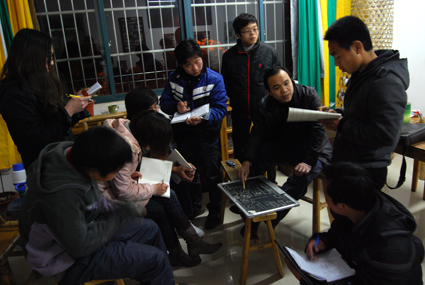
participants in the studio
reconnecting
It was his desire to build and cultivate a positive ethos in one of China’s more disadvantaged regions that led Jian Yi to give up a comfortable academic position in Beijing and return to his hometown to establish IFChina Original Studio.
“I lived in Beijing for more than a decade—going to school, teaching and working,” Jian Yi recalls. “Being in Beijing you really begin to have illusions about the country and you begin to misjudge many things. When I came back [to Ji’an] every year to visit relatives, I felt like I was in a different world. So that was the first objective—to get reconnected to social realities. The second objective was to do something similar to what Wu Wenguang and I did with the Villagers’ Documentary Project.”
The Villagers’ Documentary Project was an earlier attempt to forge a creative space for China’s rural classes, who despite comprising the majority of the country’s population, rarely have the chance to represent their own lives in any medium, let alone a relatively expensive one like video. Jian Yi was able to garner funding from an EU project on village governance in 2005 and worked with well-known Chinese documentary maker Wu Wenguang (whose credits include China’s first independently produced documentary Bumming in Beijing back in 1990) to train farmers in documentary making. Jian Yi says his work on the Villagers’ Documentary Project gave him the experience and confidence he needed to strike out and establish IFChina Original Studio a few years later.
international exchange
In addition to fostering localised forms of creative expression, an important part of the studio’s vision is giving Ji’an locals exposure to visiting foreign residents and interns. These programs, in turn, provide visitors with a chance to experience China away from the booming urban centres like Beijing and Shanghai. “I think it would be very exciting for people to come here to do their work, because it’s a totally different environment to Beijing,” enthuses Jian Yi.
IFChina’s internship program provides young people with interests ranging from arts management to filmmaking an opportunity to spend anything from one month to a year working at the studio. Similarly, the residency program provides a chance for scholars, artists and filmmakers with an interest in participatory cultural work to spend one to two months living on campus at Jinggangshan University, working with IFChina.
As well as accommodation, the studio provides volunteer translators who will help residents visit the region’s more remote revolutionary sites, including some historic villages. “You know, the social realities are there—Mao Zedong started from the villages here, and today China’s rural areas are still where China’s future has to come from,” comments Jian Yi.
Although IFChina Original Studio is clearly underpinned by an ambitious vision, Jian Yi sums up their work in quite modest terms: “We try to do very little things in a little community.” Yet as an earlier generation of Chinese in the same area demonstrated 80 years ago, little things with deep roots can one day change a nation.
Arts workers and scholars interested in internships or residencies at the studio should contact Jian Yi via the IFChina website at: www.ifchinastudio.org
IFChina Original Studio, Ji’an, Jiangxi Province, People’s Republic of China
RealTime issue #103 June-July 2011 pg. 16
© Dan Edwards; for permission to reproduce apply to realtime@realtimearts.net
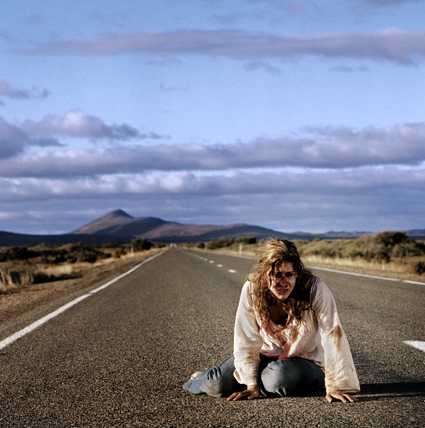
Wolf Creek
IN SPITE OF ISOLATED EARLY EXAMPLES SUCH AS LONG WEEKEND, PATRICK (BOTH 1978) AND RAZORBACK (1984), IT’S ONLY OVER THE LAST DECADE THAT AUSTRALIAN HORROR HAS TRULY FOUND ITS VOICE, GAINING INTERNATIONAL RECOGNITION, FINANCIAL SUCCESS, GRADUAL ACKNOWLEDGMENT AND SUPPORT ON THE PART OF AUSTRALIAN GOVERNMENT FILM FUNDING BODIES. THE NUMBER OF HORROR FILMS MADE SINCE 2000 (OVER 60) IS MORE THAN THREE TIMES THE NUMBER MADE IN THE 1990S (MARK DAVID RYAN, WHITHER CULTURE? AUSTRALIAN HORROR FILMS AND THE LIMITATIONS OF CULTURAL POLICY, MEDIA INTERNATIONAL AUSTRALIA INCORPORATING CULTURE AND POLICY, NO. 133).
saw
If one film can be said to have kicked off this boom in the genre, that would be Saw (2004), the first in what has become the most commercially successful horror franchise in history. The brainchild of James Wan and Leigh Whannell, two young Melbourne filmmakers, Saw, as an Australian success story, is notable for its complete lack of ‘Australianness.’ Picked up by Lionsgate in the US after failing to secure funding in Australia, Saw is internationalised horror—horror with an American accent but no clear national identity.
Sharing certain characteristics with Se7en (1995) and Silence of the Lambs (1991), Saw takes as its focus an intelligent serial killer who wants to play a game with those involved in his crimes. Although associated with the representation of strong violence, Saw keeps its gruesomeness in context and is not deserving of the disparaging ‘torture porn’ label bestowed (often justly) upon many of its imitators. In its pared-down, grim scenario, narrative is paramount. As with many a low-budget horror film, the initial set-up is minimal: two men regain consciousness to find themselves chained by the ankle at opposite ends of a grimy industrial bathroom. Between them lies a dead man.
The more mature, self-aware of the pair, Dr Lawrence Gordan (Cary Elwes) speculates, “Whoever brought us here could have killed us by now, but they didn’t. They must want something from us. Question is, what?” A mini-cassette each man finds in his pocket provides more riddles than answers. It also introduces the film’s main narrative preoccupation: the idea of the Game. The Game takes its cue from computer games (“Game over,” the killer tells his victim at the film’s end) as well as the competitive reality TV phenomenon, where distrust is fostered and contestants can only progress at each other’s expense. There is only one ‘winner.’ In keeping with the killer’s nickname, “Jigsaw,” the Game is also a puzzle that the victim-contestants must solve, full of hidden symbols, clues and riddles.
Jigsaw’s identity is part of the puzzle for viewers and characters alike. He hides behind an array of facades and disguises, including the puppet on a trike delivering the killer’s recorded messages; the assailant in a pig-mask; and Zep, the hospital orderly whom the audience are led to believe is Jigsaw, until we discover he’s just one more participant-’player’ in the Game. Jigsaw, like Se7en’s John Doe, is a moralistic killer who perversely attempts to teach his carefully selected victims the value of life. With its emphasis on saturated colour (green and red predominate), occasional frenetically sped-up scenes, the presence of puppets and masks and tricksy narrative, Saw uses stylisation rather than naturalism to create an atmosphere of horror.
wolf creek
Though spawning a similarly ‘iconic’ serial killer, Wolf Creek (Greg McLean, 2005) differs markedly from Saw in that it’s naturalistic and undeniably Australian. Before the opening credits, portentous documentary-style captions (much favoured by horror directors) appear onscreen informing us that, “The following is based on actual events. 30,000 people are reported missing in Australia every year. 90% are found within a month. Some are never seen again.” By adopting this visual characteristic of a documentary, Wolf Creek attempts to move its scenario out of the comfort of the cinema and into the lived reality of its audience.
Wolf Creek follows a trio of backpackers—Australian Ben (Nathan Phillips), Liz (Cassandra Macgrath) and Kristy (Kestie Morassi) from England—as they drive from Broome towards Darwin, taking in Wolf Creek Meteorite Crater along the way. McLean deliberately avoids in-depth characterisation; in the manner of a fly-on-the-wall documentary, the trio exists purely in the present. In the relatively long lead-in before any violence occurs, the emphasis is on their carefree youthfulness. As if to contrast with this innocent exuberance, and to offer a presentiment of future events, McLean hints at an ugly, misogynistic side of Australia from the film’s beginning. “They get real easy when they travel,” the Broome used car salesmen tells Ben, in reference to female backpackers. Later, a group of men in an outback pub joke about “gang-banging” the girls.
When Mick Taylor (John Jarratt), the film’s monster, appears, Kristy whispers, “He’s hilarious, he’s like one of those guys from Outback Australia shows.” This observation is underlined by parallels drawn in the film between Mick and his cinematic namesake, Mick “Crocodile” Dundee, with the latter’s famous “That’s not a knife” line quoted twice. Mick Taylor is Dundee’s dark counterpart. He’s also a figure with an intentional resemblance to backpacker murderer Ivan Milat, sharing the NSW serial killer’s enthusiasm for weaponry, hunting expertise, killing methods (severing of the spine, for instance) and protruding teeth. In Mick, the beer-swilling, sexist hunter stereotype in Ted Kotcheff’s seminal 1971 film Wake in Fright is taken to its extreme.
Despite the film’s title and some vaguely mystical allusions recalling Picnic at Hanging Rock (as when watches stop in the vicinity of the crater), there’s no sense of the landscape being threatening in itself. The real horror lurks in the ugly collection of sheds that constitute Mick’s hideaway, flickeringly illuminated in the darkness; and in his rifle sights, when a sunlit road provides no cover.
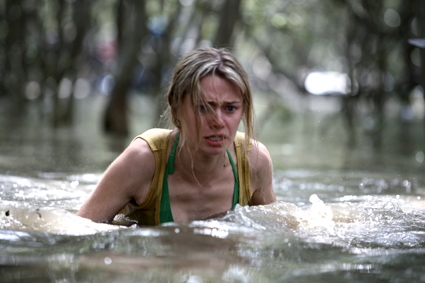
Black Water
black water
Horror takes us out of our comfort zone, which for a certain sub-genre, means following urban holidaymakers into the wilderness and whatever threat awaits them there. In Wolf Creek, it’s a psychopath, in David Nerlich and Andrew Traucki’s naturalistic Black Water (2007), a crocodile. Like Wolf Creek, Black Water uses ‘documentary’ captions, tersely explaining that the Northern Territory’s saltwater crocodile population is expanding alongside its human population. It’s also “based on true events.” As with Greg McLean’s follow-up to Wolf Creek, Rogue (2007), another crocodile film, Black Water’s subject is a river tour gone wrong.
Unlike Rogue, however, which uses stunning aerial shots and an animatronic croc to awe its audience, the minimalist Black Water works more subtly, employing landscape not as mere backdrop, but as an integral part of the threat. The camera dwells on the scenery: initially, accompanied by a gently strummed score, the river seems idyllic. Later, when a crocodile (real, not animatronic) has upended the tinny and killed the guide, the surroundings transform from peaceful to sinister. The three terrified protagonists taking refuge in a mangrove tree are interlopers negotiating a hostile environment: one that won’t let them escape. This is a film that manages to do much with relatively little.
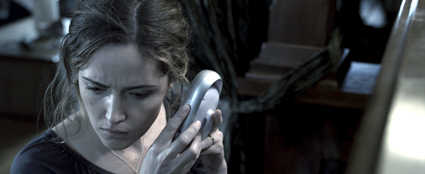
Insidious
insidious
All three sets of filmmakers are horror aficionados, but Whannell and Wan’s interest so far lies in generalised genre horror (in the manner of the Spierig Brothers, discussed in Part 2 of this article) whereas McLean, Nerlich and Traucki are concerned with developing distinctively Australian horror films. These variously draw on horrific elements of recent Australian criminal history and wildlife and the sinister potential of the landscape, as well as recalling Australian cinema classics. All continue to work in the genre: McLean has set up a production company and is working on Wolf Creek 2, and Andrew Traucki’s shark-themed The Reef was released earlier this year. With their new film Insidious (released in Australia in May) Whannell and Wan have taken their genre expertise and made what could be seen as a quintessential horror film: one designed primarily to scare.
As with Saw, Insidious is internationalised horror set in America, the only Australian element being the nationality of the female lead, Rose Byrne and of course its makers (Whannell also acts). In aspects of the art direction, certain scenes and the placement of a child at the centre of horrific events, Insidious is intentionally reminiscent of classic 1970s and 80s paranormal horror (think The Exorcist, The Shining, Poltergeist). Some of its stylisation even recalls Murnau’s Nosferatu (1922). Wan weaves these influences into a beautifully orchestrated film, which fulfils his early promise as director of Saw, demonstrating what he is capable of with a more generous budget and timeline.
Part 2 of The Horror: How Australian? will appear in RealTime 104.
RealTime issue #103 June-July 2011 pg. 15
© Katerina Sakkas; for permission to reproduce apply to realtime@realtimearts.net
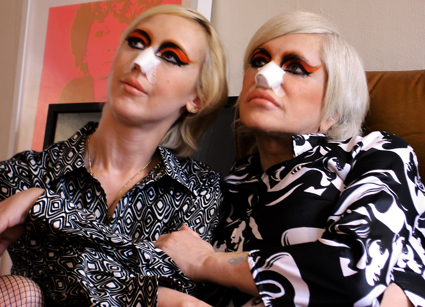
The Ballad of Genesis and Lady Jaye
REVELATION CONTINUES TO EXCITE PERTH AUDIENCES WHO ARE ENVIED EVERY YEAR BY THEIR INTERSTATE PEERS FOR THEIR ACCESS TO SOME OF THE WORLD’S MOST RECENT, STRANGE AND REVEALING FILM FARE. JUST A PRE-LAUNCH GLIMPSE OF A SMALL SLICE OF JACK SARGEANT’S 2011 PROGRAM, CURATED WITH HIS CUSTOMARY FLAIR, IS ENOUGH TO WHET THE APPETITE AND TRIGGER TREPIDATION. IN THE FOLLOWING CLUSTER OF FILMS THE BODY IS SEEN FROM A NUMBER OF PERSPECTIVES—AS ZOMBIE, THIRD GENDER, SKATEBOARDER RADICAL, CANCER VICTIM, MURDERER AND UNIVERSE-ENCOMPASSING ARTIST-SCIENTIST-PHILOSOPHER.
the advocate of fagdom
Angelique Bosio’s 2011 welcome documentary, The Advocate for Fagdom (France, 2011, 91mins, www.theadvocateforfagdom.com), will put Bruce La Bruce’s LA Zombie (RT99, p26) in perspective with its survey of the cult filmmaker’s output from shorts to the features Hustler White, No Skin Off My Ass and his zombie sex films. The specialist lineup of interviewees includes LaBruce himself, Gus Van Sant, John Waters, Harmony Korine (RT99, p16), Richard Kern and Revelation director Jack Sargeant. Bosio is a festival guest.
the ballad of genesis and lady jaye
Marie Losier’s The Ballad of Genesis and Lady Jaye (US, Germany, UK 2011, www.balladofgenesisandladyjaye.com/ballad/) investigates the ‘pandrogeny’ project of artist Genesis Breyer P-Orridge (70s performance art group Coum Transmissions; Throbbing Gristle; Psychic TV) and wife Lady Jaye transcending notions of gender by “transforming their bodies through cosmetic surgery into a third body.”
dragonslayer
Hot from SXSW 2011 in Texas where it won Grand Jury Award Documentary feature and Jury Award Best Cinematography comes Tristan Patterson’s Dragonslayer (USA, 74mins, www.dragonslayermovie.com). The film tracks an itinerant skateboarder Josh Sandoval as he journeys through suburbia “like the classic anti-hero, part-punk and part-bohemian, avoiding the bleak certainties of everyday life in favour of the magical pleasures to be had in skateboarding, hanging out with his friends and falling in love.”
gravity was everywhere back then
Described as “dreamlike,” the animated film Gravity Was Everywhere Back Then (Brent Green, 75mins, 2010, http://gravitywaseverywherebackthen.blogspot.com) will feature a live soundtrack performance by five of the film’s makers. It’s based on the true story of a man who, with love and hope, builds a healing-house for his terminally ill wife. Revelation reports that “director Green built a replica of the healing machine in his garden for the film, his own obsessions mirroring those of his subjects.”
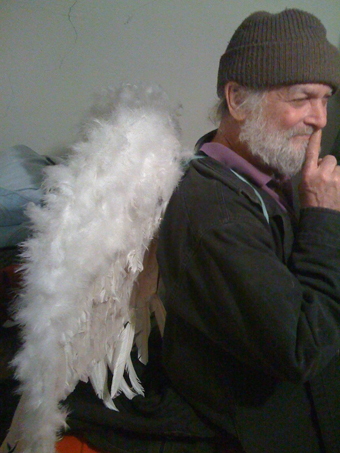
Heaven & Earth & Joe Davis
heaven & earth & joe davis
Peter Sasowsky’s Heaven and Earth and Joe Davis (USA, 90mins, 2011, www.joedavisthemovie.com) introduces us to artist, philosopher and scientist Joe Davis: “art and science fuse in his work; whether creating a genetically modified apple designed to tempt the Devil, recording the sounds of micro-organisms or encoding Greek philosophy into fly DNA.”
Stranger still is Davis’ account of “the broadcast of the harmonic frequencies of vaginal contractions into space as a comment on the censorship of gender by the space program.” Reevlation reckons that polymath Joe’s enthusiasms will generate a revitalised sense of awe about the universe of which we are part.
the redemption of general butt naked
The Redemption of General Butt Naked (Daniele Anastasion, Eric Strauss, 2011, USA, 84mins) won Excellence in Cinematography at this year’s Sundance (www.generalbuttnakedmovie.com). Revelation fills us in on the background to this documentary: “During the [first] Liberian civil war (1989-1996) Joshua Milton Blahyi, aka General Butt Naked, led his brutal army, many of whom were child soldiers, into murderous attacks. Known as the Butt Naked Batallion because of their habit of fighting naked in order to get the spirits to protect them, the Warlord and his men were responsible for thousands of deaths.” Blahyi has since reappeared as a Christian seeking forgiveness from victims and his own soldiers. The strength of the film lies apparently in its avoidance of easy judgment given the moral complexity of a post-colonial war.
soda_jerk v tony lawrence
If these films are not enough to make you see the world in a different light, Soda_Jerk v Tony Lawrence might do the trick. Instead of revealing unexpected realities, these artists play with the very way the world is mediated for us. Berlin-based Australians Soda_Jerk and Sydney’s Tony Lawrence present a feast of new and recent works using whatever comes to hand—mixing, mashing, experimenting in their very different ways. Soda_Jerk will premiere the epic Pixel Pirate 2: The Director’s Cut (2011), messing with iconic images, forms and sound-image norms. Lawrence will present four short films, “from the rock-based Goldtop Mountain, through to the poetic evocation Girl On Fire, the quasi-religious imagery of Monsignor Blood and the almost mystical From Water (2009-2011).”
Revelation Perth International Film Festival, Perth, July 14-22, www.revelationfilmfest.org
RealTime issue #103 June-July 2011 pg. 19
© RealTime ; for permission to reproduce apply to realtime@realtimearts.net
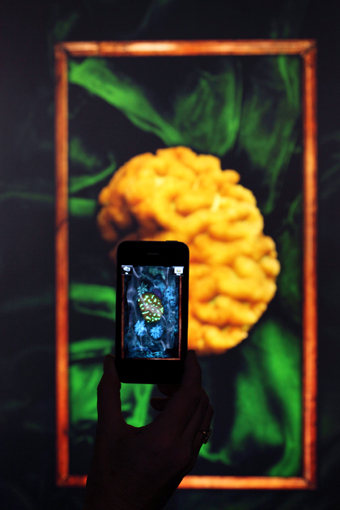
Rekindling Venus: In Plain Sight 2011, Lynette Wallworth, commissioned by Adelaide Film Festival
photo Tony Lewis
Rekindling Venus: In Plain Sight 2011, Lynette Wallworth, commissioned by Adelaide Film Festival
SOME TIME DURING THE WINTER OF 2010 I FOUND MYSELF BASKING IN THE WARM, SYNAESTHETIC GLOW OF AN ANACHRONISTIC SUN. THE DECKCHAIR ON WHICH I RECLINED PROVIDED JUST THE RIGHT VANTAGE POINT FOR CONTEMPLATION OF THE WONDERS OF ARTIFICIAL SUNSHINE. RATHER LIKE THE SUN DOMES OF RAY BRADBURY’S SHORT STORY “THE LONG RAIN” (1950), RAFAEL LOZANO-HEMMER’S GLORIOUS SIMULATED SUN INSTALLED AT MELBOURNE’S FEDERATION SQUARE OFFERED WELCOME RESPITE FROM INCLEMENT WEATHER. AS PART OF THE CITY OF MELBOURNE’S LIGHT IN WINTER FESTIVAL, SOLAR EQUATION RESONATES AS A PARABLE OF THE UBIQUITY OF DIGITAL LIGHT, ITS AMBIENCE IN THE CONTEMPORARY BUILT ENVIRONMENT, ITS FACILITY IN ENABLING SO MUCH OF WHAT WE SEE AND ITS REMARKABLE CAPACITY TO SUBSTITUTE APPEALING COPIES FOR THE REAL THING.
Such themes were among the concerns of the two-day Digital Light symposium, the public face of Genealogies of Digital Light, an ARC (Australian Research Council) Discovery project that seeks to provide a critical account of digital light-based technologies “by tracing their genealogies and comparing them with their predecessor media.” The principal researchers of the project and organisers of the conference—Sean Cubitt, Daniel Palmer and Les Walkling—conceived the event around a number of questions, chief among them the issue of how Australian and international artists working with light-based technologies are considering “the capacities and limitations of contemporary digital processes” in their work.
This reflexive gesture was welcome, for at face value the notion of digital light, in itself, is not immediately compelling as a framing theme for a packed two-day program of speakers. As if adding to my growing relief, Sean Cubitt’s opening remarks set the right conceptual tone for the event, asserting that there is still a “general ignorance” regarding digital technologies and how they actually work, despite their omnipresence in our lives. While this polemical sortie clearly identifies the research opportunity of the project, it also opened up a dialogue to do with the realpolitik of the digital, providing a reason why members of the public would bother giving up half their weekend to attend such a conference. Alvy Ray Smith, computer graphics pioneer and co-founder of Pixar, detailed the extraordinary and exponential development of computational power since the early 1960s in an entertaining and authoritative talk. He also set the digital record straight on a crucial point: pixels are actually round, not square.
The pixilated, block aesthetic of the 1980s and 90s that signified the emergence of the digital world was in fact an optical illusion, a mis-seeing of digital light. In a similar spirit of critical revisioning, Geoffrey Batchen boldly asserted, “photography has always been embedded in the DNA of digital media.” Among the many exquisite examples he discussed to support his position was Henry Fox Talbot’s 1839 contact print of two pieces of lace that he presented to Charles Babbage. “It’s as if Talbot wants to show us,” Batchen suggests, “that the photograph too is made up of a series of smaller units”—in other words, round pixels. Appropriately closing the show, Victor Burgin’s conceptually rich presentation also détourned the histories of cinema and photography, returning to their very origins in the manipulation of light and its capacity to fool the eye. Burgin’s own recent practice of compositing moving, panoramic montages from sequences of still images, evidenced the uncanny and even unsettling sensation of moving through a natural landscape that does not move with you.
The event certainly brought together an impressive who’s who of Australian and international artists, curators and technological innovators worthy of the radiance of Lozano-Hemmer’s sun. In this the symposium provided the refreshing opportunity to engage with historical perspectives alongside glimpses of contemporary aesthetic practices that explore the notion of digital light. Lynette Wallworth’s beautiful Rekindling Venus series engages with her concerns about the impact of climate change on ecosystems, using a cell phone app to transform hand-held media into a “virtual porthole to coral reefs and connected real-time data.” This canny use of augmented reality brings to life the illusion of a vibrant, three-dimensional world of fragile beauty. The symposium also offered Jeffrey Shaw the opportunity to document his long association with the wonders of light, from his expanded cinema events of the 60s, his light shows for bands such as Genesis in the 70s, to his immensely rich and varied experiments with immersive and interactive cinema and the convergence of real and virtual spaces as manifestations of light: a history that in itself charts the sedimentary record of artists working with digital technologies during the last decades of the 20th century, as well as looking back to the trompe l’oeil experiments of Baroque optics and illusionism in painting and architecture. Similarly, Stephen Jones’ comprehensive history of early electronic art within Australia added to the sense of a rich heritage of experimentation with digital light in this country. And as luck would have it (or was it an artefact of the digital?) Jones’ long awaited book Synthetics: Aspects of Art and Technology in Australia, 1956-1975 (MIT Press, 2011) was hot off the press, providing a concrete instance of the longevity on show in both his and Shaw’s presentations.
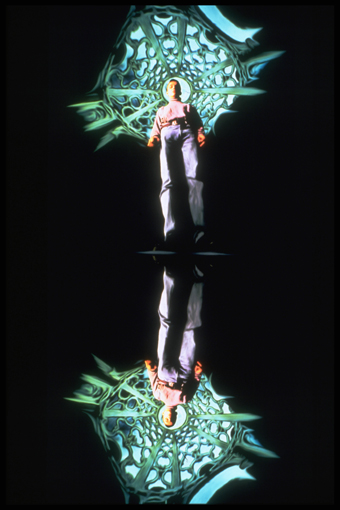
Heaven’s Gate 1987, Felix Meritis 1787-1987, Shaffy Theater, Amsterdam, Netherlands
With the advent of the minutely small (such as nanotechnology and biomechanics), a deeper questioning of the metaphysics of digital light is emerging, whereby the notion of “seeing,” as curator Christiane Paul eloquently described, becomes irrelevant. This alternative epistemology of light was taken in a different, haptic direction by Stephen Jones back to the telegraph in his re-tracing of the digital as a strict micro-economy of “on/off,” associating the digital “picture element” with the dots and dashes of the telegram. Alvy Ray Smith decisively quashed the hype around 3D TV and cinema, pointing to the misconception that 3D was ever possible on the two-dimensional screen to begin with, since it “happens in the brain, not in the display.” Smith also contributed to this galvanizing counter-phenomenology of digital light at the symposium with one of the most memorable aphorisms of the event, “Reality begins at 80 million polygons per frame.” But reminding us of Lucasfilm’s famous acronym REYES (“renders everything you ever saw”) may prove to be the boldest gauntlet thrown down to artisans of digital light in their quest for the highest-fidelity vision; the ultimate dream when the map will surely replace the territory.
Digital Light: Technique, Technology, Creation Public Symposium, University of Melbourne, March18-19, 2011
RealTime issue #103 June-July 2011 pg. 20
© Darren Tofts; for permission to reproduce apply to realtime@realtimearts.net
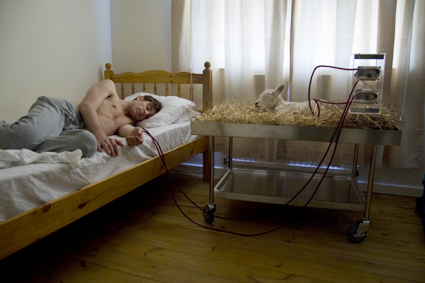
Life Support: Dialysis Sheep, 2009, Revital Cohen
image courtesy the artist
Life Support: Dialysis Sheep, 2009, Revital Cohen
IN A RECENT ARTICLE FEATURING ALEXANDRA DAISY GINSBERG’S SYNTHETIC KINGDOM PROJECT, HETTIE JUDAH ASKED, “WOULD PEOPLE STILL BE SCARED OF NANOTECHNOLOGY IF WE COULD MAKE IT STRAWBERRY FLAVOURED?” IN SOME WAYS THE ARTWORKS IN LIFE 2.0: ARTIFICE TO SYNTHESIS ARE SO SUBTLE THAT THEY DON’T NEED SWEETENING. NEW TECHNOLOGIES SLIDE INTO OUR LIVES IN SUCH AN INNOCUOUS MANNER THAT THE TECHNOLOGIES DISCUSSED IN THIS EXHIBITION SEEM TO BE ALREADY NORMALISED.
Much of the exhibition is couched in scientific-utopian terms which, on the surface, could be read as advertisements for synthetic engineering. The exhibition conjures an intense fascination for what we have done and can still do with synthetic life. There is only a slight feeling of discomfort about some of the proposed uses—a subtle twinge, miniature, like the subject matter of most of the artworks.
Some of the concepts that the exhibition asks the viewer to consider are not too far away from what people are already doing. If we can breed a sheep just for the purpose of shearing it, then why can’t we use the same sheep to provide dialysis for a human? Is one ‘use’ of the animal more humane than the other? If we use animals for our entertainment (pets, racing) or manufacture them for our food, why not use them as medical aids? Revital Cohen’s Life Support: Respiratory Dog and Dialysis Sheep proposes using retired working animals in medical programs, producing a symbiotic relationship between animal and patient. A lamb lies down on a bed of hay next to a sleeping man; the image is beautiful, softly lit and sensuous. Both man and lamb are connected to a dialysis machine, blood is feeding out of the man into the lamb, waste is processed by the lamb’s kidneys, a natural cleaning system, and eliminated through the lamb’s urine. Healthy blood flows back into the man. During the day the lamb is free to graze in the backyard and at night, while it sleeps, it is put to work. In a kind of chimerical/cyborg configuration, human, machine and animal come together and produce what curator Melinda Rackham describes as an emotionally and physically intimate healing relationship. Two of Cohen’s four photographs of Dialysis Sheep and Respiratory Dog are in everyday picture frames—taking the concepts further into the domestic arena—but are we ready to be so emotionally and physically (even parasitically) dependent on animals?
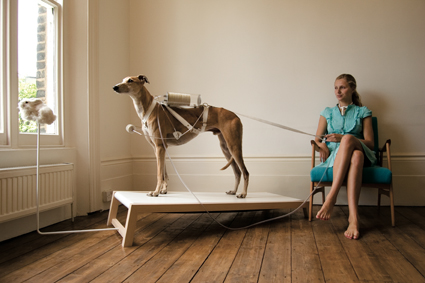
Life Support: Ventilation Dog, 2009, Revital Cohen
image courtesy the artist
Life Support: Ventilation Dog, 2009, Revital Cohen
Alexandra Daisy Ginsberg’s individual artworks and collaborations dominate the exhibition space. The Synthetic Kingdom: Synthetic Pathologies features beautiful luminescent photographs: Bioluminescent Kidney Stones, CMYK Plaque (on a set of teeth), Pollution-sensing Tumour Lung and Colonic Alchemy (gold faeces), with each body part showing anomalies formed by the body’s exposure to synthetic bacteria that have accidentally escaped from laboratories, factories and broken products. In this fictitious scenario, some of the bacteria have evolved, changing their function as they proliferate. Each image comes with a back story, such as Colonic Alchemy, where a patient’s waste material is turned to gold—although genetic testing failed to find the origins of the bacteria that caused this precipitation. These stories are almost believable; I found myself questioning whether this had already happened somewhere. Ginsberg plays with the fear of invasion/infection by our last ‘other,’ ie bacteria, with the alchemists’ quest finally answered by something that we have made, but cannot quite control.
In The Synthetic Kingdom: A Natural History of the Synthetic Future, exhibited as an animated video and as a diagram, Ginsberg explores the need to add a new branch to the Tree of Life—Synthetica. She asks, “How do we classify natural and unnatural if life is built from scratch?” The animation explores the way that life can be built from existing DNA rather than from petrochemicals. In E.chromi, collaborating with James King and the Cambridge University International Genetically Engineered Machine (iGEM) team, Ginsberg explores how the team constructed bio-bricks, synthetic genes which, when inserted into the bacteria E.coli began to secrete colours visible to the naked eye. The animation projects future uses for these bacteria: by 2039 they could be used to make a yoghurt drink which changes the colour of waste to indicate the presence of specific diseases in the body. A physical example of this is also exhibited as The Scatalog, a case of brightly coloured stool samples, each colour indicating a different disease. The animation also suggests that in the future a new profession will be created, with people searching the world for DNA that produces certain colours. Colour swatches are shown alongside a whale and a canary, perhaps suggesting that synthetic manufacture will not quite be able to stop the plundering of the natural world.
The two artworks by Richard Pell, from the Centre for Postnatural History, provide captivating catalogues of genetic research. A Selection of Noteworthy Genetically Engineered Bacteria, 2011-05-17, a cabinet of curiosities, features ‘highlights’ from the world of miniature synthetic life. Two samples that stand out are the Olfactory Art Bacteria, engineered in Bangalore India to produce the smell of fresh rain at the start of the monsoon season (why has this not been sold commercially?) and the GenTerra bacteria used by the Critical Art Ensemble, which was seized by the FBI in a mismanaged bioterrorism investigation. GenTerra was used in a performance that implicated the audience by giving them permission to release samples of bacteria into the atmosphere, one of which was possibly synthetically manufactured. These samples are fascinating as a catalogue of what can be done with genetic engineering—the presence of Gen Terra along with the sealed case that the samples are presented in is a reminder of the responsibility that accompanies this desire to tinker with the world. Pell’s Strategies in Genetic Copy Prevention looks at techniques that are used to control life, such as sterilising insects that were damaging the cattle industry in the United States and, on a more sinister note, sterilising humans (those considered to be criminal, idiots and rapists) in a plan passed in Indiana in 1907, a practice that died out after World War II. This is another reminder of the implications of these new technologies, beyond fashion and politics.
Deborah Kelly’s animation Beastliness is part of her ongoing exploration into the poetics of biotechnology. The animation features hand-cut chimerical creatures made of human, animal and plant parts dancing seductively together in a crazy mating ritual. Kelly writes, “The horizonless, post-species-specific possibilities of our new on- and offline lives demand sustained investigation as we tango into the far-fetched future, propelled by unchecked hungers.” In some ways, Life 2.0 is very clean and sanitised—if it weren’t for the uproarious music of Beastliness, inserted between the soothing pseudo-scientific soundtracks of Ginsberg’s animations, desire in all its messiness might not enter the gallery space. Kelly’s animation actively injects a little of the dystopian into the utopian future of manufactured scientific endeavour, moreso than some of the more subtle works in the exhibition. Beastliness leaves us with the question: what should we fear and what should we celebrate? It’s a question that bypasses the need for sugarcoating.
Life 2.0: Artifice to Synthesis, curator Melinda Rackham, RiAus Gallery, The Science Exchange, Adelaide, 7 April-July 8
RealTime issue #103 June-July 2011 pg. 21
© Kirsty Darlaston; for permission to reproduce apply to realtime@realtimearts.net
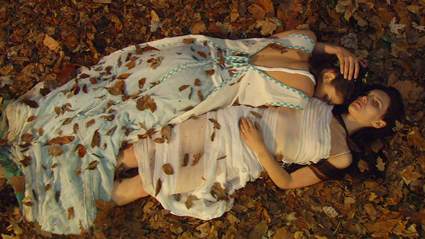
Penelope
BEN FERRIS’ 80-MINUTE DRAMA, PENELOPE, IS AN UNUSUAL WORK THAT PROVOKES REFLECTIONS ON CURRENT FILM AND VIDEO PRACTICES, NOT LEAST BECAUSE THIS INTENSELY VISUAL FILM WILL HAVE ITS PREMIERE AUSTRALIAN SCREENINGS IN A MUSEUM AND AN ART GALLERY. IT’S A FILM THAT ASKS YOU SURRENDER TO THE MOMENT.
With video art revitalised by relatively inexpensive, software-rich new technologies in the 21st century, art galleries have increasingly become sites for reflective viewing of works short, long, epic and looped. As per Christen Cornell’s encounter with Yang Fudong’s No Snow on the Broken Bridge and Seven Intellectuals in Bamboo Forest (p46), and in the tradition of video art, the viewing experience is supremely visual while cinematic expectations regarding character, dialogue, plot and structure are elided or subverted.
On the other hand, the experimental and feral heritage of video art increasingly sits beside sleek monumentally projected digital works, like those of AES+F and Isaac Julien in the 17th Biennale of Sydney, that are nothing less than cinematic in their scale and immersiveness. In fact the material distinction between film and video is fast disappearing, while not a few artists refer to themselves as filmmakers and leading visual artists—like Sam Taylor-Wood, Steve McQueen, Julian Schnabel—are making feature films.
Ferris’ film is a variation on the mythological tale of Queen Penelope waiting 20 years for the return of Odysseus, King of Ithaca, from the Trojan War. In that tale she is surrounded by 108 suitors who have assumed the hero is dead. Penelope defers choosing a new husband by focusing on the weaving of a burial shroud for her father, unravelling it nightly to extend the time of its making. Finally, she sets the suitors a near impossible archery task that the returning, disguised Odysseus executes with ease. He then kills the suitors.
Ferris’ telling is broadly true to the myth and sometimes to its detail (Penelope’s painful prayer to the god Artemis for death, for example), but in the end makes a surprising departure, one not to be revealed here but consistent with the film’s focus on Penelope herself. For the most part (save for cutaways to the loutish, gluttonous suitors), the film is realised as a sumptuous visual embodiment of her state of mind, shifting from recollection to reverie, delusion and nightmare, a condition amplified by the film’s real time unfolding and slow tracking shots. The camera’s long lines of movement and circlings suggest the omniscience of a storyteller who never speaks and is in no hurry to inform or guide us—there is little narrative propulsion and only spare dialogue. This is a film of the lived moment, quite apt for a contemplative gallery screening.
The slow pacing of the film correlates with a sense of timelessness in the late Jennie Tate’s expert production design. Penelope and her maids appear as if from a Classical frieze or a Renaissance painting of the same (glimpsed in the film’s opening), while the suitors seem attired like Florentine gentlemen. Odysseus in a trench coat smokes a cigarette and Penelope plays a 19th century piano. The elegant, modestly grand house has an Italianate openness and is imbued with a sense of mystery—perhaps the gods are at work, particularly towards the film’s end when huge timber doors are slowly buffeted then blown open and an aura glows around a determined Penelope. A single crow sits ominously on her windowsill. Wolves howl out of the emphatic sound design. Penelope’s silken weaving glows in the night like a spider web—and is unthreaded like one. The world of Penelope is an oddly disparate but simultaneously coherent one.
The formal camera work, its considered, painterly gaze and the symmetries of the film’s design are counterpointed by what they frame: Penelope’s disturbed state—her loneliness, her anguish over the sickness destroying her beloved geese, her imagined lovemaking with Odysseus in an autumnal forest and the nightmare of the suitors raping her maids (enough to soon stir her to action). It’s an effective dynamic in a film that warrants patient attentiveness to yield its subtleties and pleasures.
Penelope, director Ben Ferris, director of photography James Barahanos, production designer Jennie Tate, composer Max Richter, producer Irena Markovic; Australian/Croatian, 80mins; Nicholson Museum, University of Sydney, June 15, 6:30pm, free; Art Gallery of New South Wales, June 25, 2pm, free
RealTime issue #103 June-July 2011 pg. 22
© Keith Gallasch; for permission to reproduce apply to realtime@realtimearts.net
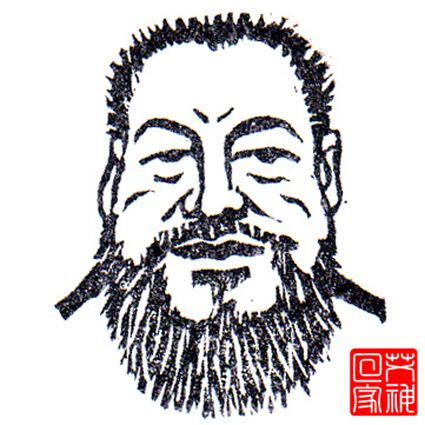
Free Ai Weiwei!, hand carved stamp by Carloe Liu
creative commons, some rights reserved
Free Ai Weiwei!, hand carved stamp by Carloe Liu
“IF IT CARRIES ON LIKE THIS IT WILL BECOME LIKE THE CULTURAL REVOLUTION.” THAT WAS THE ASSESSMENT EXPRESSED TO ME RECENTLY BY A WELL KNOWN CHINESE CREATIVE FIGURE REGARDING THE CURRENT SITUATION IN THE PEOPLE’S REPUBLIC. IF THAT SOUNDS LIKE HYPERBOLE, THE FACT THAT THESE WORDS ARE BEING UTTERED BY SOMEONE OLD ENOUGH TO REMEMBER WHAT THE MAOIST ERA WAS ACTUALLY LIKE IS INDICATIVE OF THE PREVAILING MOOD AMONGST THE NATION’S ACTIVIST AND CREATIVE COMMUNITIES.
On Sunday April 3, China’s best known contemporary artist Ai Weiwei was taken from Beijing airport as he attempted to board a flight for Hong Kong. He has not been directly heard from since. His wife, Lu Qing, told international media outlets on Monday, May 16 that she had been allowed to see the artist the day before for around 20 minutes—her first contact with Ai for six weeks. It is still not clear where or why the artist is being held. Four of Ai’s associates have also been arrested and have not been heard from now for seven weeks.
As well as being a prolific filmmaker, architect and designer, Ai Weiwei has long been an outspoken critic of the Chinese government. His domestic and international profile, however, led many to believe he was unlikely to suffer the harsh treatment dealt out to many lesser known opponents of the regime. In the words of The Guardian’s Jonathan Jones on April 4, his arrest is being interpreted as an attempt to “stamp out the idea that any individual is greater than the law of the state.”
Unfortunately Ai Weiwei’s case is just the tip of the iceberg. After anonymous calls for a Chinese “Jasmine Revolution” emulating recent uprisings in North Africa and the Middle East circulated online in mid-February, the Chinese authorities moved swiftly to neutralise the perceived threat. Initially political activists were targeted, including lawyers and well known bloggers. In March, they also began exerting pressure on parts of China’s creative community.
The China Human Rights Defender website claims, “The Chinese government has criminally detained a total of 39 individuals since mid-February.” Seventeen of these are still in detention, nine have been charged and are awaiting trial and three have already been sent to camps for “re-education through labour.” The claims are supported by a map detailing the names and locations of those detained (see chrdnet.org). Earlier this month the same organisation reported that around 200 others have been placed under various forms of “soft detention”—in other words, house arrest.
In addition, an unknown number of people across China have been subject to a ramping up of intrusive surveillance, harassment and interference in their daily lives. On March 18 for example, I visited the academic and documentary filmmaker Ai Xiaoming (no relation to Ai Weiwei) at Sun Yat-Sen University in Guangzhou. Ai has made numerous low budget documentaries focusing on controversial issues such as the spread of AIDS in rural China through unregulated blood collections.
As Ai Xiaoming led a translator and myself to her apartment, we were intercepted by a plain-clothed security officer who addressed Ai by name and asked what we were doing. He was joined a few moments later by another man and a woman, while two other men stood watching a few metres away. None of the group were uniformed or offered any form of identification. The first man informed Ai Xiaoming that we needed to accompany him to the campus security office (bao wei chu), while the woman asked me and my translator our names, occupations and places of origin. Ai Xiaoming agreed to accompany the “officers” if they let me and my translator go. As my companion and I made a hurried exit we were followed by other plain-clothed personnel into the subway station next to the campus.
On May 13 China Human Rights Defenders reported that Ai Xiaoming has recently received a high volume of “silent phone calls, believed to be automated, that have disrupted her phone service.” The keyhole to her front door was also recently filled with glue by an unknown harasser.
Although certain filmmakers and artists have long been under surveillance and subject to phone taps, since the 1980s it has been rare for Chinese authorities to physically prevent artists meeting with foreigners. It is a disturbing development that the kinds of restrictions that more radical political activists have long endured are now being extended to established creative figures.
In more bad news for China’s film community, on April 18 organisers announced the cancellation of the 8th Documentary Film Festival China, an event staged annually since 2004 in the far flung Beijing suburb of Tongzhou. The festival is one of a handful of regular events in China showcasing films made outside the country’s state-controlled approval system. The 2011 edition had been planned for the first week of May. Critic and programmer for the Vancouver International Film Festival, Shelly Kraicer, reported on the dGenerate website (www.dgeneratefilms.com) on May 12 that, “Several levels of government, represented at a surprisingly high level, made it clear…that this was not the right time for an independent organisation to screen Chinese films that the state has not authorised.” Kraicer also claimed that foreign visitors who had journeyed to Tongzhou were followed by plain-clothed police.
The literary world has also been affected by the tightening of the cultural sphere. On March 27 Yang Hengjun, a China-born Australian novelist and blogger, disappeared in the city of Guangzhou. He resurfaced the following weekend and was allowed to return to Australia via Hong Kong, but he declined to elaborate on his experience.
Writer Liao Yiwu was less fortunate. In early May he was denied permission to leave China to attend the Sydney Writers Festival to talk about his new book, The Corpse Walker. This turn of events was disappointing but unsurprising—writers’ organisation PEN claims that Liao has been denied permission to leave his own country 14 times in the past three years.
It remains to be seen whether the present crackdown represents a longer term hardening in the government’s attitude or is simply a panicked, typically heavy-handed response to events overseas. Either way, it’s a sobering reminder of the immense arbitrary power wielded by China’s ruling party and how quickly cultural liberalisation can be wound back when the state feels threatened. Even if all the detained figures are released tomorrow, the atmosphere of fear will linger, intensifying the already pervasive self-censorship that exists in China’s media and cultural spheres. Which is, of course, precisely the intention. The message from the authorities is clear—the right to creative expression in China is always on notice.
This report is an updated version of the one originally appearing in the e-dition of May 10.
RealTime issue #103 June-July 2011 pg. 23
© Dan Edwards; for permission to reproduce apply to realtime@realtimearts.net
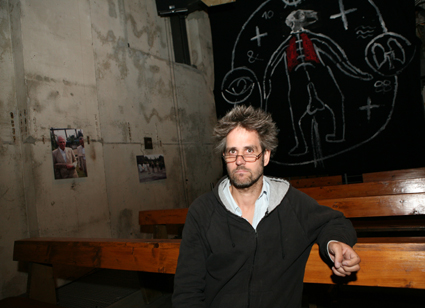
Christoph Schlingensief preparing for Church of Fear (2003)
photo © Ursula Kaufmann
Christoph Schlingensief preparing for Church of Fear (2003)
ART WITHOUT BORDERS, EDITED BY TARA FORREST AND ANNA TERESA SCHEER, RECENTLY PUBLISHED BY INTELLECT, IS THE FIRST MONOGRAPH ON CHRISTOPH SCHLINGENSIEF, THE GERMAN THEATRE AND FILM ARTIST WHO DIED IN JULY 2010. IT IS THE FIRST ENGLISH LANGUAGE RESOURCE ON THE MAN CONSIDERED TO BE ONE OF THE MOST IMPORTANT 20TH CENTURY ARTISTS OF THE GERMAN SPEAKING WORLD, BUT ALSO THE FIRST ACADEMIC STUDY OF A VERY PROVOCATIVE OEUVRE. I SPOKE IN MELBOURNE WITH ANNA TERESA SCHEER ABOUT THE ARTIST AND THE BOOK.
First things first: Schlingensief is almost entirely unknown in Australia.
In 2008, when I returned to Australia, I realised Schlingensief’s work was among that which had really impressed me during my 14 years in Germany—especially when I realised how apolitical Australian art had become in the Howard years. For example, there was no attempt to test the sedition laws. People seemed afraid of losing the support of the funding bodies. Schlingensief, by contrast, had gone out on a limb time after time, in Germany, Switzerland and Austria. He was arrested twice and wasn’t bothered about the consequences.
In Germany, I was used to him being a household name—an unusual position for a theatre artist. It became especially apparent to me that his work needed to be written up when I began my postgraduate studies. He’s not mentioned in any of the ample literature that was coming out on politics and performance. American and British perspectives dominate the field, and still focus on people like Augusto Boal. Even Baz Kershaw, in The Radical in Performance, still talks about The Living Theatre and the Welfare State International from the 1960s.
After nearly 30 years of work, not much has been published on Schlingensief. Of course, there were articles in German papers and magazines, but that’s not the same as a scholarly, referenceable book. His work wasn’t considered serious—which didn’t detract from its power, from it being always sold out at the Volksbuehne in Berlin. The writing that did get published was primarily from his own collaborators. I was interested in how other people thought about the work, how it could be understood. In this book, we move from Adorno to Brecht to Goffman, looking for interpretive context.
We know Schlingensief as a theatre-maker, but his theatre career was an accident. He was an underground filmmaker when Matthias Lilienthal invited him to work in the re-established Volksebuehne in former East Berlin.
An incredibly smart move for Lilienthal, to pick up on a man who says his films were only ever going to be shown in cellar cinemas. Schligensief was invited after making the third film in his German trilogy, Terror 2000: Intensive Station Germany, which lampoons Germany’s memorial culture—politicians laying wreaths at every opportunity, the Gladbecker hostage disaster, the plight of the asylum seekers—piling up a lot of stuff together using very unaesthetic, trashy means. The film was called sexist, racist, every negative epithet you can imagine. And he was invited by Lilienthal to retort to critiques in a stage production.
I am intrigued by Rocky Dutschke ‘68 (1996), an early theatre work in which he tried to confront the Left’s nostalgia for the 60s and uncritical emulation of kinds of protest that are now futile.
It tried to re-create the 60s: Schlingensief in a Dutschke wig inciting people to go into the theatre, then out again for a protest, a love-in in the theatre…It inquired into the leftist mythology of Rudi Dutschke [assassinated leader of the West German student movement in the 1960s], seriously asking: is anything like this still possible, or are we all postmodern super-cynics and resistance no longer imaginable?
He really targeted the Left’s idealism: ‘We’ll still find the working class, who will revolt and take over.’ He wasn’t interested in that sentiment. You could absolutely not describe him as a leftist in those terms. He was an anarchic spirit, whose line was one of inquiry.
In your book cinematographer Sandra Umathum reflects very personally on what it meant to experience Rocky Dutschke ‘68.
The difficulty of writing about Schligensief’s work is that it was different every night. He throws dramaturgy overboard, gets rid of previously made agreements with the actors; he will on the spur of the moment upturn the whole thing. Key sections may remain—or maybe not! Schlingensief’s theatre work was not fuelled by a great love of theatre, of wanting to follow in Brecht or Grotowski’s footsteps. He was experimenting with theatre like a child with plasticine. What can you do with this? He was interested in the way theatre was never finished, but happened anew each night.
Rocky Dutschke ‘68 was the first performance in which Schlingensief used non-professional performers, a practice he continued throughout his career: people with disabilities, the homeless. In Hamlet in 2001 he conscripted a bunch of reformed neo-Nazi youths. He was not interested in the ‘show me your wounds’ approach in which we turn up to be compassionate. The audience is not allowed complacency.
He was not doing it to elevate the status of a minority, but to get to the core of societal problems—and not in a linear or simple, causal way. People forget how turbulent Germany was in the 90s. Moving the capital back to Berlin, the ‘media chancellor’ Gerhard Schroeder, then the bombing of Belgrade, the first time German troops were employed since WWII. Germany was outraged: this happened under a red-green government! Then the ongoing reunification debate: will we become the great nation of fascists again? All these things swirling around, as if in a washing-machine. And that is how these productions looked: like questions, with actors representing contemporary politicians, with references to the Nazi past…but always as this “past that will not pass.”
Was he an heir of Brecht in that sense?
Yes—the audience had to sit there and critically engage with their own society and socio-political problems, because he wasn’t telling them what to think.
PASSION IMPOSSIBLE, 1997
Passion Impossible was an inquiry into the city of Hamburg. Schlingensief was invited to create a work at the Deutsches Schau-spielhaus in Hamburg, Germany’s largest theatre [whose production Pornography was presented at Melbourne Interntional Arts Festival in 2010].
At that time, Hamburg station, which sits opposite the theatre, was literally a camp for the homeless and drug users. To get to the theatre, you had to step over their bodies. Schlingensief was essentially a moralist and found this situation unbearable. He first suggested to the administration they tear down the facade of the theatre and turn around the seats, to face the theatre across the road, the theatre of misery. The theatre rejected the proposal ‘for technical problems.’ Instead, they agreed to sponsor a benefit gala, to raise money for a mission.
The seven-day event Schlingensief staged was a mission in the former police station down the road and a series of mass events in public space. You had him standing outside the theatre in a policeman’s jacket with a megaphone, encouraging the theatre patrons to “come away from this ugly bunker! There’s nothing in here for you!” Like the Pied Piper of Hamelin, he would encourage people, having bought their ticket, to leave the building and come to the mission, which was a real mission—with beds and a soup kitchen. Here they had an open mike, a small stage and people could speak about whatever they wanted. He had an accordion player, the Salvation Army band, people singing songs…All sorts of little moments of what could be called entertainment.
Was this real or just a provocation?
It wasn’t clearly outlined. The theatre had publicised the event. The audience would buy tickets, then walk 200 metres up the road to the mission. You were paying to be involved with the people you would normally completely ignore, would never encounter in your daily life, or could have easily dealt with for free!
Participating in it was a provocation to oneself. Some of the stories of the homeless people were just awful. Early on, at the benefit gala, Schlingensief appeared with a decrepit battery chicken, and asked: “I want to see how much money can be raised to save the neck of this chicken!” People in the audience started protesting but he said, “We eat these chickens every day. What do you care about its life? I want to know how far people will go. We’re all addicted”—addicted to one’s own sense of doing good, of being a good citizen. We responded to the phone call, turned up at the benefit gala, did our little bit, even if otherwise we don’t really care. But now we’re really worried about the chicken!
But the main provocation was to the Lord Mayor by getting the citizens to eventually march up to the Town Hall, asking for the mission to continue. It became permanent.
I found Passion Impossible fascinating because it took it right out onto the streets. It is not dissimilar to Augusto Boal’s invisible theatre. There was a lot of media around. Questions were asked: Is he serious? Is this a charity campaign? Is it performance? Of course, it was all these things. And it evolved into an actual campaign, which he couldn’t have planned in the beginning. The work really asks: can art do something that politics can’t, create impetus for change? It questions our idea that artists can at best be pranksters. This is very different from watching The Chaser boys having a good time.
PLEASE LOVE AUSTRIA, 2000
I remember the reverberations from Please Love Austria (2000) as it made news throughout Europe that summer. There were riots!
2000 was the year when the liberal Austrian government became the only one since WWII to form a coalition with a far-right populist party, FPÖ, led by Jörg Haider. Sanctions were imposed on Austria. All of Europe was aware of Haider’s anti-immigrant campaigns.
Schlingensief was invited to create a work for the Vienna Festival. It was planned that shipping containers would be placed in the centre of town, on the Opera Square. These containers would be the living quarters for 12 asylum seekers for a period of seven days. Inside were webcams streaming to a website and Austrian citizens were encouraged to vote out their least favourite inhabitant, who would be taken to the border and deported. The winner would get 35,000 schillings and the possibility of becoming an Austrian resident by marriage. It followed the Big Brother format, which had just appeared.
It was only when Schlingensief, opening the show, revealed a large banner on the container, which said “Foreigners Out.” that it stopped being a game, or even funny. This is a well-known right-wing slogan: “Germany for Germans, Foreigners Out.” Jaws dropped. It attracted growing attention. People were coming through town for the festival and Schlingensief was there with a megaphone, exhorting tourists to take photos: “This is the future of Europe, this is Austria, send this to your friends at home, dear Japanese, dear Americans!” Austrians were shocked: “Besmirching our country!” Schlingensief kept publicly inviting Jörg Haider to meet with the asylum seekers—involving him in the performance, in absentia. The national boulevard press, the Kronen-Zeitung, were writing every day: “This Schlingensief clown is costing you money, dear readers.” Schlingensief retorted that they were just writing the program notes to his event.
The Left were campaigning against Jörg Haider. They saw the “Foreigners Out” banner simply as a provocation, accusing Schlingensief of misusing asylum seekers for his project. They marched around the container, demanding that he set those inside free, showing mind-boggling naivety—these were real asylum seekers, all with cases pending.
In the end they stormed the container.
Jumped on the roof, destroyed the banner, demanded a meeting. The asylum seekers had to be evacuated. The protesters then realised these were real asylum seekers and had to question their own activities. When they finally left, Schlingensief raised the ante by putting up an SS slogan that had been used by an FPÖ member: “Loyalty is our Honour.”
In that moment, it was as if Schlingensief reminded everyone that we were watching an art performance and that the real issue was only being represented. It questioned the efficacy of removing a symbol as a political action.
The Left-Right binary looked pathetic. The Right couldn’t take down the sign and government officials taking down an artwork would look pretty stupid. On the other hand, leftist protesters making insane demands weren’t effective either. Set the asylum seekers free—for what? Where?
The show wasn’t so much about the asylum seekers. Austria was televised around the world—the theatre was the Austrians, watching each other perform. Whatever happened, Schlingensief incorporated it into the work. That was the fun aspect of it. He didn’t have to rise to the bait or argue that this was a serious piece of political art. He would say: “I’m just repeating what Haider has been saying.”
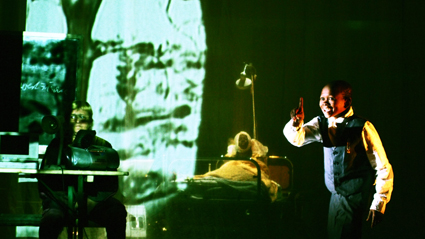
Kerstin Grassmann, “Kandy” Mamounata Guira, Amando Komi in Christoph
Schlingensief’s award winning 2010 work Via Intolleranza
Slavoj Žižek calls this “radical overidentification”— an artistic position where you critique by overstating, by taking a claim to its absolute extreme to reveal its ugly possibilities.
Please Love Austria was a perfect example—the asylum seekers being forced to learn German, do callisthenics…It’s not as if Austria changed when the project left. That didn’t see the end of the coalition. But it showed how art can be directly involved in events of the day, in a very radical way.
In the book you point out the connection between Schlingensief’s work and the neo-avant-garde of the 1950s. You write about “an art practice that emerges from the social sphere—and that develops out of the active, creative participation of the viewer.”
The comparison with happenings is not wrong—everyday life, spontaneity, experiments. Schlingensief didn’t start something with a blueprint of how it should end, but set it in motion like a wind-up toy, to see where it goes. In Germany he is often considered the inheritor of the legacy of Joseph Beuys. Beuys’ discussions, definitions, ideas—of social sculpture, of an expanded form of art—Schligensief co-opted for his own ideas on an expanded form of theatre. Getting rid of the fourth wall, people leaving the theatre for the streets. That became really clear in 1998, when he ran his own political party in the German election.
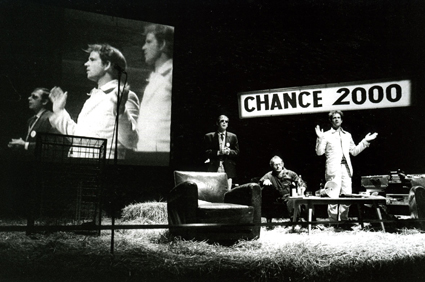
Christoph Schlingensief (right), Chance 2000—Vote for Yourself (1998)
photo © Aino Laberenz
Christoph Schlingensief (right), Chance 2000—Vote for Yourself (1998)
CHANCE 2000—VOTE FOR YOURSELF, 1998
It started off with an event at the Volksbuehne. Schlingensief had a circus performance set up in a tent—the “electoral circus.” But at the same time, he started his own media campaign on national television about Chance 2000 – Vote For Yourself (1998). He was encouraging the disabled and the unemployed to run as political candidates. “None of these people in the Bundestag represent you. The idea that you will be represented by someone else your whole life is ridiculous—you have to prove you exist. Get involved in starting your own campaign.”
He toured Germany in a bus, campaigning non-stop. It wasn’t a completely serious attempt to form a political party. He would say, “Unlike all other politicians running in this election, the only promise I am going to make is that everyone will be bitterly disappointed.” Then he decided that the people who joined the party were too boring, left it and set up the Schlingensief Party. He wouldn’t let those he rejected into his new tent, but after two days they reunited. A very clever German reviewer commented that Schlingensief gave us a short run-through of democracy in a week. Parties, factions, reuniting, splitting up, another leader emerging, and all happening with such a turbulent tempo!
Germany was baffled: vote for yourself? Is he lampooning the election? The party got 30,000 votes. But the idea wasn’t that they would take over the Bundestag but rather “prove you exist.” In this world, where the only voices we hear are those of rich politicians, who are these faceless unemployed people, apparently numbering six million? He was demanding you make yourselves visible in a world that’s trying to erase you.
There was a lovely offshoot action of Chance 2000. Schlingensief announced that the six million unemployed would join him to jump into a lake, Wolfgangsee, where Helmut Kohl’s villa is, to raise the water level, flood Kohl out and give him cold feet. The police were sent to the village, all sorts of preparations were in place. Schlingensief turned out with about 300 people. But Kohl ‘participated,’ against his will, in a performance. It doesn’t really matter if it did or didn’t happen. People saw the clips, it was national news that there hadn’t been 6 million people, only 300.
Schlingensief really understood the sound-byte world we’re living in—he created a mythology around the work, pretending things would go further than they actually could, and were bigger than they actually were.
How did Schlingensief’s work fit into the German theatre context? I remember when Denise Varney [Theatre Studies, University of Melbourne] showed a clip from Please Love Austria in class there was incredible consternation about whether such an action was legal or not. In Germany Schlingensief reached the status of a star. He directed an opera for the Bayreuth Wagner festival. He was not living in a live art ghetto, the way one would expect here.
Events such as the one he staged in the election campaign of 1998 made him nationally prominent, while internationally it was Please Love Austria. He became the biggest name in art in Germany. After years of people saying it wasn’t real theatre, the fact that he wasn’t going away and was finally invited to direct Parsifal at the shrine of Wagner in Bayreuth, meant that he was finally accepted. On the other hand, he never became an intendant of a theatre—people didn’t trust him on that level. But after he contracted cancer, when he was only 47, he released a book—his cancer diary, titled Heaven Can’t Be More Beautiful Than Here—and it became a bestseller.
SHOCKED PATIENTS
He started a website, Shocked Patients (www.geschockte-patienten.org). The first thing he found out as a cancer patient is that you lose all autonomy. People start shoving tubes into you, no one talks to you, they talk over you. You are again erased. He created a forum for people diagnosed with terminal diseases, cancer and ALS [amyotropic lateral sclerosis] to write about their experiences, to have their own voice.
He had previously created a performance called Art and Vegetables (2004) at the Volksbuehne, in which, centrestage, was a woman with ALS, in bed, able to write messages by blinking at a computer screen. The woman, Angela Jansen, was quoted in the program, saying, “I’ve got everything I need, it’s just that I can’t move.” He used that as a reference to German society of the time. The woman became the forum moderator.
It’s not as if he avoided scandal, he sought the media, did things knowing they would provoke a reaction—saying unkind things about Lady Di, for example. But there is also his metaphorical language: “Jump into the lake and give Kohl cold feet,” or relating physical sickness to a social sickness and lethargy.
One of the reasons it’s hard to talk about Schlingensief’s work is because he covers so many forms: happening, performance, theatre, film, activism, politics. It’s hard to sum up his work. One motif is, perhaps, visibility, the other is putting himself in his work. And particularly interesting to me, in these times of complete social inertia—I’m thinking Australia now—is his idea of movement, getting out of torpor and lethargy. He often took to the streets with groups of people. “Move! It doesn’t matter where we’re going. I don’t even need a plan.” No need for direction – you just move. “We’ll figure it out as we go.”
Tara Forrest and Anna Teresa Scheer eds, Art Without Borders, Intellect Books, 2010; www.intellectbooks.co.uk
RealTime issue #103 June-July 2011 pg. 24-25
© Jana Perkovic; for permission to reproduce apply to realtime@realtimearts.net
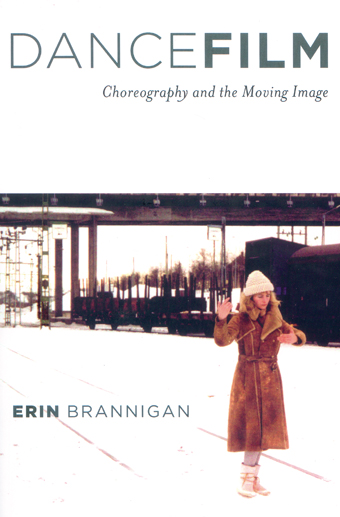
Dancefilm: Choreography and the Moving Image,
CHOREOGRAPHER WILLIAM FORSYTHE STATED, “THERE ARE WONDERFUL INNER THINGS HIDDEN WITHIN DANCING,” AND FROM THE LATE 19TH CENTURY TO THE START OF THE 21ST, SCREEN-BASED EXPLORATION HAS OPENED ACCESS TO ALTERNATIVE MOVEMENT WORLDS, ENGINEERING ALONG THE WAY THE CROSS-BRED DISCIPLINE OF THE DANCEFILM.
Formulating an academic approach to this field of study has been a more recent development, with groundwork laid over the last 10 years by a variety of approaches and writers. However in the introduction to her new book, Dancefilm: Choreography and the Moving Image, Erin Brannigan notes a ‘stand-off’ between dance and film discourse, with an often unclassifiable hybridised form left languishing in the theoretical margins. Brannigan manages to integrate both strands in a deeply rooted field of critical thought, making reference to Walter Benjamin, Henri Bergson and Gilles Deleuze among others. She also nods to contemporary dancefilm practitioners—David Hinton, Miranda Pennell and Gina Czarnecki—with examples of work on an accompanying website. The book comes into its own, however, as an historical tour-de-force, probing deeply into cultural causes, presenting the reader with a spiralling timeline of critical nexus points.
Brannigan sets the scene by arguing convincingly for the emergence of, in Bergson’s phrase, ‘modern movement’ as symptomatic of the neurasthenic, turn-of-the-20th century city-dweller’s state, set within a wider historical context of technological transformation. Here, the primacy of the pose in classical ballet and still photography gives way to a notion of constant flux. This notion is presented as the defining characteristic of both modern dance and moving pictures, which are as inseparably entwined in Brannigan’s reading as the twin strands of a double helix.
Placed centrally to this argument is the work of solo performer Loïe Fuller, whose serpentine spin weaves through the cultural milieu of fin-de-siècle Paris, reflecting and expanding on the ideas of Mallarmé, Valéry, the Lumière Brothers and Georges Méliès. Neither ballerina nor showgirl, ‘La Loïe’ was the first artist regardless of gender to claim the title of director/choreographer, manipulating billowing fabric around a shrouded body as lighting effects conjured a continuous stream of allusion—flowers, butterflies, fire and snow. Complete in herself as a one-woman ‘moving image,’ Fuller is positioned by Brannigan as prefiguring the thematic and operational territory of both avant-garde film and postmodern dance.
The threads of this lineage are traced along multiple pathways, finding resonances between the work of Jean Renoir, René Clair and the Dadaists and writing on non-narrative cinema, such as that of Hungarian theorist Béla Balázs on the expressive potential of the close-up. The latter is explored in depth, with the abstracted play of bodily detail—the twitch of a finger, the ripple of a spine—central to much contemporary dancefilm cast as ‘micro-choreographies,’ small-scale, transformational experiments in ‘movement-for-movement’s sake.’ Brannigan also traces the historical roots of Delsartism—a gesture-based system of actor training—noting its role in the highly physical performance style of silent-era stars such as Lillian Gish and Charlie Chaplin. Tracking the pathways of this tradition through the pedagogy of the Dennishawn school and the Graham Studios, Brannigan winds her way towards the psychologically charged, non-linear montages of Pina Bausch and Wim Vandekeybus, finding particular significance en route in the gesture-heavy waking dreamscapes of Maya Deren.
A figurehead for the mid-20th century Greenwich Village avant-garde, Deren’s writing on a choreographic dimension to filmmaking is highlighted as central to an understanding of the field. Deren’s notion of “horizontal form”—where the feeling state of being-in-the-moment is explored in depth—provides Brannigan with a template for analysis not only of experimental film, but also for the Hollywood musical, here cast as “longer format vertical film form.” In contrast to much pre-existing, production-led analysis, Brannigan approaches this territory by highlighting the phenomenon of highly nuanced transitions between performance modalities. Focusing on a central—often female—physicality, she contrasts the precise, self-contained technical style of Ginger Rogers with the long-limbed, ground-covering expansiveness of Rita Hayworth, while casting the hyper-expressive sensuality captured in Marilyn Monroe’s close-ups as micro-choreographies in themselves. However Brannigan finds fullest expression of Deren’s ideas in the work of choreographer/director Bob Fosse, with Liza Minelli and Shirley MacLaine barely keeping in check an edgy over-exuberance, spilling out into highly stylised song-and-dance numbers.
Deren’s input is also tracked through convergence points where avant-garde film and dance intersect, noting her influence on the work of artists such as Shirley Clark, Amy Greenfield and Norman McLaren, before arriving squarely at the writings of Judson Church alumnus Yvonne Rainer and the movement research of fellow downtown Manhattanite Trisha Brown. Rainer noted that “dance is hard to see,” and Brannigan observes that Brown’s exploration of uninflected sequencing— characterised here as “anarchic phrasing” and as a lack of conventionally “privileged moments”—pushes technical boundaries in registering the “in-betweenness” of a work such as Watermotor (1978), ultimately captured in otherworldly slowed-motion by Babette Magnolte’s cinematography.
In her concluding chapter, Brannigan makes the case for a hugely disparate “cinema of movement,”—identifiable throughout genres from abstraction to advertising—bringing together the body-centric notion of ‘somatic intelligence’ and Jean-François Lyotard’s concept of “somatography.” The latter emerges as a highly significant element of Brannigan’s theorising. Described as “a writing on/of the body,” it provides graspable language for a notoriously slippery phenomenon—kinesthetic engagement with screen practices such as framing and edit. Brannigan goes further, arguing that this also allows for a kinesthetically framed viewing experience, sited within the “sensitive field” of filmic mise-en-scène and completing an improvisatory circuit of multisensory transference between moving image and audience—a “call-and-response” grounded in non-verbalised levels of body-based exchange.
Tackling a large-scale agenda from a meticulously researched and unapologetically dance-centred perspective, Dancefilm is a much-needed resource for the serious scholar. Viewed in addition to Karen Pearlman’s recent focus on a choreographic approach to editing in Cutting Rhythms (2009) and the appearance of the International Journal of Screendance in 2010, we could be forgiven for thinking that these are promising times for raising awareness of a significant field.
Erin Brannigan, Dancefilm: Choreography and the Moving Image, Oxford University Press, New York, 2011
RealTime issue #103 June-July 2011 pg. 26
© Chirstinn Whyte; for permission to reproduce apply to realtime@realtimearts.net
WHO ON EARTH WOULD WANT TO SPEND AN ENTIRE WEEKEND TALKING ABOUT ‘PRACTICE’? THIS QUESTION WAS ANSWERED WHEN THE NATIONAL DANCE FORUM, DESIGNED TO “REFLECT ON THE STATE OF DANCE PRACTICE IN AUSTRALIA NOW, AND TO CHART A COURSE FOR THE FUTURE,” QUICKLY SOLD OUT. DANCE TYPES, IT SEEMS, NEED LITTLE INCENTIVE TO RUMINATE.
True, there were two weeks of Dance Massive performances book-ending the talkfest in Melbourne in which to see practice in, well, practice. The forum sat neatly within the biennial festival’s program and the foyers of Dancehouse, Malthouse Theatre and Arts House were more than usually clogged on March 19 and 20.
Inspired by the 2010 National Theatre Forum that proved a dynamic meeting place for the theatre sector, Ausdance and the Australia Council supported independent producer Kath Papas to work with a National Advisory Group to create a platform of similar scale for dance. While Australia Council Director of Dance Carin Mistry’s summary of the event published on the Australia Council website emphasised the to-and-fro between dance in Australia and overseas, the forum was focused determinedly on the local. Mistry concluded her article with an aspiration for the debates of the forum to connect to the world stage. While there were two international guest speakers and several artists on panels who work internationally, there was a particular urgency to the discussions about the Australian context.
Three keynote interviews, 12 round tables and a plenary were interspersed with breaks in which the conversations were more hungrily pursued than the meals. Noise levels were high in the underground canteen of North Melbourne Town Hall, suggesting an excitement and energy to the communion that was repeatedly articulated over the weekend. There was a lot of kissing.
While I was unable to attend every round-table due to the simultaneous programming of three groups in each slot, I spoke with participants in each. The general opinion was that the more specific the theme, the better the quality of discussion. Dramaturgy for example, chaired by independent choreographer Brian Lucas with speakers Anne Thompson, Lisa O’Neill and Tang Fu Kuen, provoked a lively discussion of the whys, hows and whos of this discipline. The session on Dance Practice in Communities was equally specialised and energetic. Chaired by Annie Greig of Tasdance, speakers Philip Channells, Annette Carmichael, Jess Devereux and Dalisa Pigrum inspired the full room to contribute their experiences, sparking an upbeat debate that affirmed work that is often excluded from the spotlight. The session on Critical Feedback run by choreographers Becky Hilton and Lucy Guerin was a group exercise in self-analysis, attending to often painful aspects of the dance-making process.
Less successful were the larger panels or those where the topic was less clear. It bears remembering that the most innovative artists are not necessarily the most interesting speakers about their work, or that those who love to talk about their work are often not the most interesting. Young artists became rather bogged down in their personal experiences in a panel that sought to give them an equal voice. Artists expressing their enthusiasm for technology relied too much on said technologies in their presentation and forgot the bodies in the room. A long line of collaborators presented too many perspectives upon collaboration to find a thread and a discussion on practice itself succumbed to the perhaps inevitable navel-gazing its rather abstruse questions set up.
The roundtable entitled “Where are we?” directly addressed the Forum’s overarching theme. Keith Gallasch, Editor of Real Time, Kate Denborough, Artistic Director of KAGE Physical Theatre and Daniel Brine, Artistic Director of Performance Space, offered personal points of view in an optimistic survey of dance in relation to other artforms, other nations and other cultural pursuits. Gallasch, delineating a mock ecology of contemporary Australian dance, worried that elements missing in the system left dance undernourished, while Daniel Brine was curious about what he regarded as unwarranted anxiety about contemporary dance’s achievements. In this session, as in most, there were diverse questions from the floor, considering phenomena from mass-market television dance shows to dance in education.
The role of session Chairs was vital and excellent work was done by representatives of a broad range of organisations that support dance-making in Australia, including Jeff Khan, now at Performance Space, Helen Simondson from ACMI and Erin Brannigan from UNSW. Panels represented the geographical spread of artists and organisations in Australia although some complained of a metropolitan focus. Other complaints concerned the underrepresentation of sectors such as commercial dance although the organisers defended their right to focus upon the subsidised sector, with Ausdance spruiking forthcoming conferences in other areas.
The keynote speeches were a personal highlight. Lee Christofis, the ‘Parkinson of Australian dance,’ coaxed poignant observations of an extraordinary career out of leading Indigenous dance maker, Raymond Blanco. The warmth of this conversation at the start of the first day set the tone of pleasure and celebration that persisted. The first day closed with Chrissy Sharp, Chair of the Australia Council’s Dance Board interviewing choreographer Kate Champion, delivering useful insights for emerging makers in particular. Thai choreographer Pichet Klunchen was interviewed by dramaturg Tang Fu Kuen from Bangkok, assisted by Naree Vachananda’s good humoured translation. Klunchun’s discussion of his status as an artist in Thailand, making contemporary work in reverence of and direct challenge to the traditional Kohn dance style, was fascinating. Fu Kuen struggled to draw out the wider implications of his grappling with Western audiences and responses to his recent production, Nijinsky Siam, but each word Klunchun uttered was sufficiently different from the way in which Australians talk about dance to merit close attention and the room was more hushed than at any other time by this interview.
Forum Facilitator Kristy Edmunds kept us on mission, reminding participants at the start of each day of their responsibilities to contribute. The Forum published rigorous principles: namely to embrace and value diversity, to foster robust debate, to maintain a positive tone, to focus on the future and to challenge each other to delve deeper. Edmunds worked these principles in the final session entitled Artistic Stocktake, in which she broke the plenary into groups and demanded punchy answers to provocative questions. Conversation spilled out onto the footpaths and foyers of Melbourne and continues still.
National Dance Forum, An Australia Council for the Arts and Ausdance National partnership, Arts House, North Melbourne, March 19-20
RealTime issue #103 June-July 2011 pg. 27
© Sophie Travers; for permission to reproduce apply to realtime@realtimearts.net
{$slideshow} PERFORMANCE SPILLING OUT INTO STREETS AND ALTERNATIVE VENUES CHARACTERISES PERTH OF LATE. AIMEE SMITH’S MONSTERS OF ACCIDENTAL MEANING (SEE PAGE 30) SLIPPED HUMAN CONTAMINATION AMID THE MUSEUM’S INANIMATE SPECIES, WHILE CAROL BROWN AND DORITA HANNAH’S TONGUES OF STONE AND WILLI DORNER’S BODIES IN URBAN SPACE SHOVED DANCE DEFTLY INTO ANARCHIC OCCUPATION. SKIN BECOMES METAPHORICALLY TAUT IN SPATIAL TRANSGRESSIONS, IMPOSING ALTERNATING CURRENTS OF FLOW AND RESISTANCE IN MOVEMENT AND STASIS, FLESH AND STONE.
In spite of the accumulations of energy and imagination involved in birthing cities, their monumental structures and half-hidden crumbling decrepitude are forbidding places for performance. The city emasculates human playfulness, tames its makers—well almost. These recent dance invasions suggest that the scribbled traces of bodies can defy the immovable stance of skyscraper and underground labyrinth and tease the automated traffic of corporate workers and castaways.
Human shapes orchestrated into architectural recesses, plastered gecko-like on blank walls or swept like refuse into obscure alleyways comprise the snatched moments of Austrian Willi Dorner’s site-specific choreography captured on video. Faceless, his dancers freeze in tension infused inversions, their geometric interventions creating tensile counterpoints to the wedged planes and joints of construction. Each momentary anti-dance carries movement into the heart of stillness willing a paradoxical negation of the hegemony of buildings. While video clips offered tantalising glimpses into Dorner’s work, his lecture fell short on revealing the thinking that produced the curious shapes.
Gathering at the departure point for Tongues of Stone was quite another story. Here within the stagnant design of the railway station’s regulated flow, the senses prickled. How could performance overcome such drabness and discomfort, even given the careful attentions of the production crew, which proved to be an intrinsic feature of the choreography? Then the journey from civilisation’s underbelly began. I surged with the rest of the mobile audience wearing slightly disorientating earphones into the choreographies of passing traffic to settle around a distracted bride figure, her voluminous tulle swept up in the grime of time. Blinded by a gash-like eye-mask, she thrust herself against a wall, fingers groping and scratching the worded surface while soundtrack intonations dissolved. “My words go home/Fear and fury” rushed towards the past while she continued to dig into the inert stone text’s “I am present.” Distraught flesh, stone and elusive tongues began to map the city’s hidden traceries.
Danced ephemera with textile and text, water and chalk-dust transformed human-made surfaces and conventions: the total experience kneaded the city’s present into its multiple histories. Intentional aesthetic layers, such as the Greek myth of Procne and Philomela and the creation body of the Indigenous spirit Wagyl relayed both through the visual and sonic experience, dissipated somewhere in the complex assault on the senses but the fierce guardians of unborn futures, the red mop-head furies, marked alleys and atriums with ‘attitude’ and breathed exquisite billows of black cloaks across architectural sharpness.
That striking collision of built environment, past and transitory shadows emerged forcefully in another episode when the chorus inhabited the escape stairs at the back of Her Majesty’s Theatre. Serendipitously, the sun’s angle directed the tiered and cascading silhouettes of their toil up and down an adjacent wall. The powerful effect would be the envy of any theatrical designer.
Across main arteries and back alleys, the performance trajectory snaked its way with the Wagyl towards the corporate enclave, producing particular reflections of alienation on the Saturday of my viewing. The emptiness of glinting marble, revolving doors and manicured landscapes seemed woven into the theatricality. Dancers laconically shifted within water features and filled spaces with stunning red satin, but they were not entirely alone. Pertinent accidents occurred: a female guard walked embarrassedly into the spotlight and a white and black bridal party crossed the performance flow creating surreal counterparts to the story being told. The irony of intersecting processions was Felliniesque—tulle bright in one direction, red stained drama in another.
Accidental juxtapositions are crucial to these kinds of performances and, I assume, will be different with each presentation. Mind you, the final destination, the Convention Centre forecourt may invariably be uninhabited for the structure forms a dead end, barring access to the life-giving river beyond. Even the wondrous scrawls of the paperbark trees within which the final de-robing takes place cannot displace the poignancy of hidden waters and raped landscapes that linger after the dancers disappear.
STRUT and the Dancing Cities Network: Tongues of Stone, co-directors Carol Brown (choreography), Dorita Hannah (spatial design), sound design Russell Scoones, Perth Dancing City Event, April 9-16; Willi Dorner (Austria) Lecture presented by STRUT in conjunction with the School of Architecture, Curtin University, April 1
RealTime issue #103 June-July 2011 pg. 28
© Maggi Phillips; for permission to reproduce apply to realtime@realtimearts.net
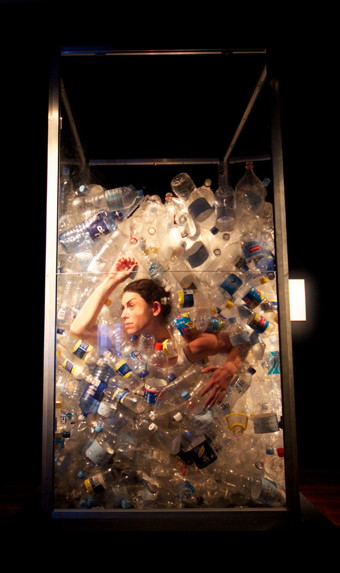
Deborah Robertson, Accidental Monsters of Meaning
photo Jarrad Seng
Deborah Robertson, Accidental Monsters of Meaning
ANTICIPATION PERVADED MOUNTING THE STEPS OF MONUMENTAL OFFICIALDOM: AN EXHIBIT OF CONTEMPORARY DANCE ‘SPECIMENS,’ CATALOGUED AND DELICATELY PINNED WITHIN CUSTOM-MADE GLASS-LIKE SHOWCASES, WAS ABOUT TO BE LAUNCHED AT THE WA MUSEUM, GIVEN EQUALITY WITH THE PRESERVED ‘WONDERS’ OF THE WORLD. THERE WAS SOMETHING DELICIOUS FOR AN HABITUAL PERFORMANCE GROUPIE, NORMALLY LEFT TO NAVIGATE ILL-ANGLED STEPS AND SHAKY SEATING CONSTRUCTIONS, IN THE PERSONALISED ATTENTIONS GIVEN BY THE MUSEUM STAFF WHO GUIDED VISITORS THROUGH INTRICATE PASSAGES TO THE PERFORMANCE VENUE. THE SCENE WAS SET FOR ASCENSION AND, UNPREDICTABLY, FOR ACCIDENTAL SMALL DISAPPOINTMENTS.
Instead of the horrified delight of my first viewing of these ‘accidental monsters’ too close-up, amidst a small pressed crowd in the now condemned visual art space, Spectrum, the specimens of human bondage in their own wasteful behaviours were now tactfully arranged, beautified by spatial expansiveness and subdued lighting. Ironically, giving equivalent treatment to the rest of the exhibits failed to extend the visceral potency of these danced monsters. In line with their inanimate companions, the metaphorical blood and weeping gristle of the danced specimens were cleansed, spruced up for visual clarity.
The impact of Aimee Smith’s conception lies primarily in the spectator’s shocked recognition of the future, indelibly hatched in the human present. Encased in choreographed taxidermy and animated by innovative technology, the creatures strain in various ways within their bleak destinies. A body ‘drowning’ in a receptacle jam-packed with empty water bottles, speaks of the absurdity of our behaviour. The plastic agitation of the soundscape as a hand penetrates entrapment, mixes humour and desperation with equal and colliding effectiveness. In the Spectrum space, the hand scratching the glass carried the horrendous potential of penetrating the audience’s own skin. Here, the absurd concept remained: but its unsettling proximity was alleviated.
Rhiannon Newton’s caged beast, the once robust and insatiable human consumer, lay trapped in lassitude with flickering enticements for Vegemite and pizza projected across her hunching form, driven deep like irascible tattoos. With the venue’s distancing from the beast, spectator voyeurism seemed less likely to be caught in a hall of mirrors’ effect, watching-the-self-watching-the-self ad infinitum. Moreover, while the zoological inferences are not missed, they are ameliorated—tamed, in a strange way. This species at the edge of extinction suggests an intellectual exercise, at a remove from the confrontational recognition that the caged creature is the human present about to become its future.
In an adjacent enclave, Natalie Holmwood’s Sisyphus amassed boxed products, undeterred in rebuilding an ever-collapsing accumulation of excess. She also hoards communication, strings of incomplete messages winding up and down over the purposeless reconstruction: these two broken actions keep a disconnected rhythm.
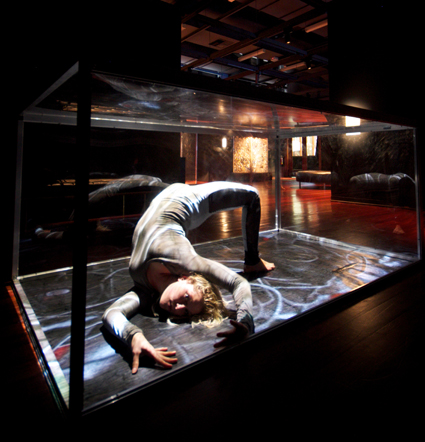
Accidental Monsters of Meaning
photo Jarrad Seng
Accidental Monsters of Meaning
The additions to the original concept tend to be less pungent in accidental monstrousness. Aisling Donovan’s Arctic figure sways wistfully fragile, an illuminated slice of body against film of the eloquent, expansive landscape. Whispers of erosion play on the purity of wilderness, transforming environmental wellbeing into a half-remembered fictive icon. In the space, this exhibit acts like a floating tissue of memory, not dissimilar to the fossil imprint of a feathery vestige found in a display case at the entrance. Whether this imagistic statement relays the dangers of climate change is debatable. Similarly, the spectatorial powerplay integral to the press-button dancer (Bianca Martin) can slip into a one-sided game. I imagine that the school groups to explore the installation in the following week will push this facility to its limits without realising the mirror that it holds on this very behaviour.
These two specimens filled out the space but did they contribute to the self-inflicted extinction highlighted in the Spectrum configuration? There was also a sequential performance element in the original cramped presentation, wherein each exhibit’s greed was pitched onto and against its neighbours’, which contributed to the claustrophobic perspective. Implication, not just as spectators but as participants in present consumption leading to future collapse, was inescapable.
Enabling spectators to roam freely and democratically bears its own advantages, a conspicuous one being access by the general public and notably the school groups mentioned above. Smith’s political commitment to the persuasive attributes of performance is undeniable, as is the commendable gain of prestige and exposure granted by the museum venue. However loss might ensue, particularly if the other monsters in the equation, the spectators, are given hushed spaces in which to hide. The accidental meanings provoked in an unconducive space may, under the banner of protest, ironically be the best place to be.
Accidental Monsters of Meaning, concept, choreography Aimee Smith, performers Deborah Robertson, Rhiannon Newton, Bianca Martin, Aisling Donovan, Natalie Holmwood, Isabella Stone, sound design Ben Taaffe, costume design Esther Gauntlett, Jason Reibel, projections Aimee Smith, Chris Jordan, Western Australian Museum, Perth, March 26-April 3.
RealTime issue #103 June-July 2011 pg. 30
© Maggi Phillips; for permission to reproduce apply to realtime@realtimearts.net
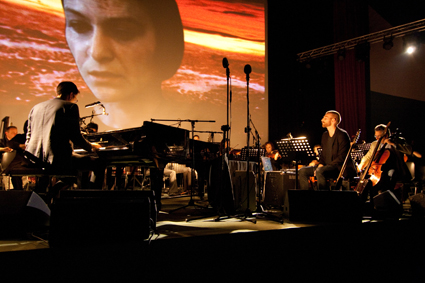
Daníel Bjarnason, Ben Frost, Sinfonietta Cracovia, “We don’t need other worlds. We need mirrors.” Music for Solaris; Unsound Krakow
photo Anna Spysz
Daníel Bjarnason, Ben Frost, Sinfonietta Cracovia, “We don’t need other worlds. We need mirrors.” Music for Solaris; Unsound Krakow
COMPOSER AND MUSICIAN BEN FROST’S BOLD DECISION TO RELOCATE FROM MELBOURNE TO ICELAND IN 2005 SEEMS TO HAVE PAID OFF. IN 2006 HE TEAMED UP WITH ICELANDIC PRODUCER VALGEIR SIGURÕSSON AND US COMPOSER NICO MUHLY TO FORM THE BEDROOM COMMUNITY LABEL PRODUCING TO MUCH ACCLAIM THEIR OWN RELEASES AND THOSE OF OTHER GENUINELY INTRIGUING ARTISTS.
In between touring schedules around Europe’s key music festivals Frost has written sound scores for the Icelandic Dance Company and the UK’s Random Dance as well as Chunky Move’s Mortal Engine. In 2011 Frost is the Rolex Music Protégé under the mentorship of Brian Eno. Coincidentally he has been collaborating with Icelandic composer Daníel Bjarnason, the Sinfonietta Cracovia and Eno on a commission from the Unsound Festival to re-interpret the soundtrack of Andrei Tarkovsky’s mesmerising epic Solaris (1972).
messing with a masterpiece
Frost is happy to admit that he came up with the idea behind Music for Solaris because of his dissatisfaction with Eduard Artemyev’s sound score for the original film. “I don’t dislike the music, I think it’s really beautiful, but it’s a science fiction score. It’s music that’s made to [give you] this feeling that you are in outer space, which in my view is not at all what the actual story is about. The space setting is merely a vehicle to get across a much bigger, more human concept—something that’s much more about inner space.”
Frost feels that Stanislav Lem, author of the novel Solaris, was not completely aware of the humanistic depths of his book, and that it was Tarkovsky’s interpretation that revealed these aspects. He says, “I think that [Tarkovsky] took it to a far more spiritual place. It’s become evident that Lem was pretty dissatisfied with the Tarkovsky version.” It is this element of interpretation or misinterpretation that he feels is the key to his project. “One person can take something from an idea that the person who [instigated it] didn’t actually see themselves and from that you can create all these variations on a theme.”
It’s a deft conceit that frees Frost somewhat from criticism for tinkering with Tarkovsky’s masterpiece. I admire Artemyev’s score for maintaining and heightening the psychological tension while not employing ‘dramatic’ filmic techniques. If Frost’s creation makes it to Australia I’m looking forward to comparing the relationship between the original and its re-interpretation.
finding the language
Frost had been waiting for an opportunity to work with Daníel Bjarnason since they first met in 2002. Bjarnason is a classically trained composer, while Frost has emerged more from the popular electronic end of the music spectrum. Frost describes Bjarnason’s music: “He has a very hardened, quite unromantic aspect to his work that I really appreciate. The thing that I love about his music is the visceral brutality of it. He really stabs you with things. It becomes quite oppressive [but] really dynamic as well.” It has taken until now for the pair to discover a shared language to enable a meaningful collaboration.
The core of that shared language turned out to be improvisation with the basis of the final composition arising from sessions recorded while watching the film, with Bjarnason on heavily prepared piano and Frost on heavily prepared guitars. Frost describes the process: “We did this a few times. There were a lot of moments where we were just sitting in this room watching the film together, but every now and then we’d find things in it, find angles on it and go off into weird little slow jams, ending up with all this material [that] became the basis for the score.”
They then fed the audio files into a computer to generate MIDI data resulting “in all kinds of errors and misinterpretations of that material, which in turn created a whole new set of ideas that were wrong.” However the errors were what Frost was looking for: “I was really interested in the idea of translation and transformation through misinterpretation of information. For me, [this] is what Solaris is about—this idea of missing information. This woman [Hari, who is] being projected back to [Kris Kelvin] is essentially his memory of her. It’s not her in the true sense. So I really liked the idea of working musically that way.”
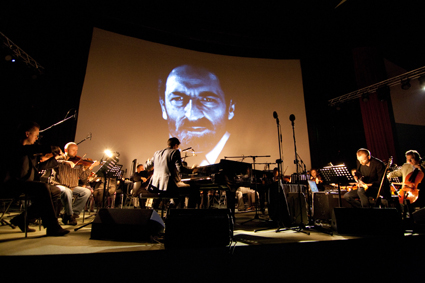
Daníel Bjarnason, Ben Frost, Sinfonietta Cracovia, “We don’t need other worlds. We need mirrors.” Music for Solaris; Unsound Krakow
establishing equilibrium
The process didn’t end there. Bjarnason and Frost then took this machine translation and retranslated it back into a form humans could play, scoring it for the 30-piece Sinfonietta Cracovia. The reasoning for this third level of interpretation was also inspired by the themes in Solaris. Frost explains, “It’s not so much about the presentation of this being in front of you…it’s what do you do with that information that becomes interesting? That’s the drama of that story: Kris trying to kill Hari three times, eventually giving up and finding some new level of existence through that. Some sort of spiritual equilibrium comes through that process.”
Interestingly, equilibrium has also been reached in the creative partnership of Frost and Bjarnason. Both artists are renowned for their epic compositions but Frost says that Music for Solaris has turned out to be “a very subtle piece of music…It’s almost like phase cancellation—you take two gigantic forces and put them together and you get something that’s not the sum of its parts but actually the negative space that’s created by the two of them.”
mirror images
After this process of re-interpretation, Frost found that he was not so interested in performing the score to Tarkovsky’s original film, so for the visual element of the 50-minute composition he turned to his Rolex mentor Brian Eno (the pair had actually been working on the project prior to the official commencement of the mentorship). Eno, in collaboration with Nick Robertson, chose to mirror the music-making process in some ways. Taking individual frames from the film, they used morphing software to create long, extruded transitions, thus creating new, machine-made material. Frost admits to being rather hands-off on the visual element: “I’ve always struggled with the relationship of video, particularly live video, to music. From my point of view the video is Brian’s thing. I’m really very happy [that there is this] other entity who is approaching the same ideas and material with the same intent but who is essentially oblivious to what I’m doing. We’ve performed it three times now and I don’t get to see the screen a lot, but it’s really quite remarkable how often things happen [together]—the synaesthetic synch of everything is really quite profound.”
“We don’t need other worlds. We need mirrors.” Music for Solaris premiered in October 2010 at the Unsound Festival Krakow, with subsequent performances at Unsound New York, The Donau Festival in Austria (of which Frost was also a curator) and most recently in the Reykjavik Festival. With each performance developing it further, Frost admits that the work is “divisive” and requires a lot of its audience due to its slow, quiet intensity.
emotional extremes
Extrapolating from the process of Music for Solaris and his previous albums Steel Wound (Room40), Theory of Machines and By The Throat (Bedroom Community) along with his longstanding ‘band name’ School of Emotional Engineering, I suggest to Frost that he appears preoccupied with the coldness of machines and the quest for deep emotion. He replies, “I think it’s a fascination with extremes: the fascination with dynamics. I want the best of both worlds. My work in the greater sense is increasingly about finding ways to create space between those two things. I think the void is far more interesting than the edges of it. I think that’s probably what drives a lot of these ideas. But then again I’m still working it out.” And, as Ben Frost has only just cleared his 20s, there’ll be plenty of time and opportunities for him to keep chipping away at it. The results so far have certainly been impressive.
Ben Frost has also composed the soundscore for Australian writer-director Julia Leigh’s film debut Sleeping Beauty, premiering at Cannes 2011 and screening at the 2011 Sydney Film Festival. www.sff.org.au/
“We don’t need other worlds. We need mirrors.” Music for Solaris, composers, performers Ben Frost, Daníel Bjarnason with Sinfonietta Cracovia, video Brian Eno, Nick Robertson; Unsound Festival Krakow, Poland, Oct 24, 2010; Unsound Festival New York, US, April 6; Donau Festival, Austria, April 29; Reykjavik Arts Festival, Iceland, June 4; www.bedroomcommunity.net/artists/ben_frost
RealTime issue #103 June-July 2011 pg.
© Gail Priest; for permission to reproduce apply to realtime@realtimearts.net
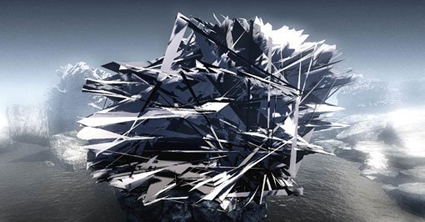
David Haines & Joyce Hinterding, The Outlands, 2011, production still; Anne Landa Award
courtesy of the artists and BREENSPACE
David Haines & Joyce Hinterding, The Outlands, 2011, production still; Anne Landa Award
haines & hinterding win anne landa award
The Art Gallery of New South Wales has announced that David Haines and Joyce Hinterding have won the $25,000 acquisitive Anne Landa Award for video and new media arts. Their large-scale screen work The outlands invites you to manipulate alone or together two twigs that trigger massive environmental changes to refracting, crystalline worlds light years from video game violence and scenic literalism. The award exhibition, Unguided tours, curated by Justin Paton (art critic, author and senior curator at Christchurch Art Gallery, New Zealand) is well worth a look with each of the works discretely housed. Other engaging works are by Rachel Khedoori (Australia/USA), Jae Hoon Lee (Korea/New Zealand), Arlo Mountford (Australia), Charlie Sofo (Australia) and Ian Burns (Australia/USA). Unguided tours: Anne Landa Award for video and new media arts 2011, Art Gallery of New South Wales, Sydney, to July 10
politics & the wild western at acmi
German artist Julian Rosefeldt’s American Night is a five-channel installation that “embraces the conventions of the Western film genre, deconstruct(ing) the myths surrounding the foundation of America and offer(ing) a scathing commentary on recent US foreign policy. Using settings that are commonly associated with Westerns—a communal campfire, the local saloon, a log cabin where a woman waits alone, a deserted main street and a lone rider travelling across a rugged landscape—American Night offers an alternative view of freedom, one where satire and the unexpected are never far away. Filmed in southern Spain and the Canary Islands on an original Sergio Leone film set, the title of the installation refers to the filmmaking technique of shooting ‘day-for-night’, also known as ‘American night’, a practice that was commonly employed during the making of Westerns. On one channel, a group of cowboys huddle around a campfire discussing freedom and their right to carry a gun, with their conversation consisting entirely of quotations lifted from pop-culture figures such as film director Jean-Luc Godard, rapper 50 Cent, and former actor and National Rifle Association President, Charlton Heston. On another channel, George Bush and Barack Obama appear as the characters in a puppet show being played out in a saloon” (ACMI press release).
Rosefeldt’s work has been shown at the Bienal de São Paolo, Athens Biennial, PS1 (New York), British Film Institute (London), Museo Reina Sofia (Madrid), Centre Pompidou (Paris), and the Hishhorn Museum and Sculpture Garden (Washington). In 2007, he was awarded the Filmstiftung NRW Award at the KunstFilmBiennale Köln for his film work, Lonely Planet, and won the Vattenfall Contemporary 2010, assigned in cooperation with the Berlinische Galerie, Berlin. He currently resides in Berlin. Julian Rosefeldt, American Night, Gallery 2, ACMI, Melbourne, June 21-July 31
tanja liedtke documentary at sydney film festival
Much admired at its premiere at the Adelaide Film Festival, Life in Movement, an 80-minute tribute to the late choreographer Tanja Liedtke by writer-director-producers Sophie Hyde and Bryan Mason, will be screened in competition at the 2011 Sydney Film Festival. The FOXTEL Australian Documentary Prize is open to factual films of any length with a cash prize of
$10,000 to be presented at SFF’s Closing Night ceremony June 19. Life in Movement traces the journey of Liedtke’s collaborators 18 months after her accidental death in 2007 as they internationally tour her award-winning productions with footage of performances and archival material of the artist at work. Life in Movement, Sydney Film Festival, June 18, 6.15pm, http://sff.org.au/
RealTime issue #103 June-July 2011 pg. 22
© RealTime ; for permission to reproduce apply to realtime@realtimearts.net






































![Nicola Leahey, Jessica Jefferies, [sic], Dancenorth](https://www.realtime.org.au/wp-content/uploads/art/46/4690_ashley_dancenorth_sic.jpg)













































